
City
of hobart
AGENDA
City Planning Committee Meeting
Open Portion
Monday, 4 July 2022
at 5:00 pm
Council Chamber, Town Hall

City
of hobart
AGENDA
City Planning Committee Meeting
Open Portion
Monday, 4 July 2022
at 5:00 pm
Council Chamber, Town Hall
Working together to make Hobart a better place for the community.
THE VALUES
The Council is:
|
People |
We care about people – our community, our customers and colleagues. |
|
Teamwork |
We collaborate both within the organisation and with external stakeholders drawing on skills and expertise for the benefit of our community. |
|
Focus and Direction |
We have clear goals and plans to achieve sustainable social, environmental and economic outcomes for the Hobart community. |
|
Creativity and Innovation |
We embrace new approaches and continuously improve to achieve better outcomes for our community. |
|
Accountability |
We are transparent, work to high ethical and professional standards and are accountable for delivering outcomes for our community. |
|
|
Agenda (Open Portion) City Planning Committee Meeting |
Page 3 |
|
|
4/7/2022 |
|
Business listed on the agenda is to be conducted in the order in which it is set out, unless the committee by simple majority determines otherwise.
APOLOGIES AND LEAVE OF ABSENCE
1. Co-Option of a Committee Member in the event of a vacancy
3. Consideration of Supplementary Items
4. Indications of Pecuniary and Conflicts of Interest
6. Planning Authority Items - Consideration of Items With Deputations
7. Committee Acting as Planning Authority
7.1 Applications under the Sullivans Cove Planning Scheme 1997
7.2 Applications under the Hobart Interim Planning Scheme 2015
8.2 Assessment of Planning Applications with Heritage and Disability Access Issues
8.3 City Planning - Advertising Report
8.4 Delegated Decision Report (Planning)
9. Responses To Questions Without Notice
9.1 Refuelling Compliance Issues
11. Closed Portion Of The Meeting
|
|
Agenda (Open Portion) City Planning Committee Meeting |
Page 6 |
|
|
4/7/2022 |
|
City Planning Committee Meeting (Open Portion) held Monday, 4 July 2022 at 5:00 pm in the Council Chamber, Town Hall.
This meeting of the City Planning Committee is held in accordance with a Notice issued by the Premier on 31 March 2022 under section 18 of the COVID-19 Disease Emergency (Miscellaneous Provisions) Act 2020.
The title Chief Executive Officer is a term of reference for the General Manager as appointed by Council pursuant s.61 of the Local Government Act 1993 (Tas).
|
COMMITTEE MEMBERS Deputy Lord Mayor Councillor H Burnet (Chairman) Alderman J R Briscoe Councillor W F Harvey Alderman S Behrakis Councillor M Dutta Councillor W Coats
NON-MEMBERS Lord Mayor Councillor A M Reynolds Alderman M Zucco Alderman Dr P T Sexton Alderman D C Thomas Councillor J Fox Councillor Dr Z Sherlock
|
Apologies:
Leave of Absence: Nil.
|
|
The minutes of the Open Portion of the City Planning Committee meeting held on Monday, 20 June 2022, are submitted for confirming as an accurate record.
|
Ref: Part 2, Regulation 8(6) of the Local Government (Meeting Procedures) Regulations 2015.
|
That the Committee resolve to deal with any supplementary items not appearing on the agenda, as reported by the Chief Executive Officer.
|
Ref: Part 2, Regulation 8(7) of the Local Government (Meeting Procedures) Regulations 2015.
Members of the Committee are requested to indicate where they may have any pecuniary or conflict of interest in respect to any matter appearing on the agenda, or any supplementary item to the agenda, which the Committee has resolved to deal with.
Regulation 15 of the Local Government (Meeting Procedures) Regulations 2015.
A Committee may close a part of a meeting to the public where a matter to be discussed falls within 15(2) of the above regulations.
In the event that the Committee transfer an item to the closed portion, the reasons for doing so should be stated.
Are there any items which should be transferred from this agenda to the closed portion of the agenda, or from the closed to the open portion of the agenda?
In accordance with the requirements of Part 2 Regulation 8(3) of the Local Government (Meeting Procedures) Regulations 2015, the Chief Executive Officer is to arrange the agenda so that the planning authority items are sequential.
In accordance with Part 2 Regulation 8(4) of the Local Government (Meeting Procedures) Regulations 2015, the Committee by simple majority may change the order of any of the items listed on the agenda, but in the case of planning items they must still be considered sequentially – in other words they still have to be dealt with as a single group on the agenda.
Where deputations are to be received in respect to planning items, past practice has been to move consideration of these items to the beginning of the meeting.
RECOMMENDATION
That in accordance with Regulation 8(4) of the Local Government (Meeting Procedures) Regulations 2015, the Committee resolve to deal with any items which have deputations by members of the public regarding any planning matter listed on the agenda, to be taken out of sequence in order to deal with deputations at the beginning of the meeting.
|
|
Agenda (Open Portion) City Planning Committee Meeting |
Page 7 |
|
|
4/7/2022 |
|
In accordance with the provisions of Part 2 Regulation 25 of the Local Government (Meeting Procedures) Regulations 2015, the intention of the Committee to act as a planning authority pursuant to the Land Use Planning and Approvals Act 1993 is to be noted.
In accordance with Regulation 25, the Committee will act as a planning authority in respect to those matters appearing under this heading on the agenda, inclusive of any supplementary items.
The Committee is reminded that in order to comply with Regulation 25(2), the Chief Executive Officer is to ensure that the reasons for a decision by a Council or Council Committee acting as a planning authority are recorded in the minutes.
|
Agenda (Open Portion) City Planning Committee Meeting |
Page 21 |
|
|
|
4/7/2022 |
|
7.1 Applications under the Sullivans Cove Planning Scheme 1997
7.1.1 6 Montpelier Retreat, 8 Montpelier Retreat, Battery Point and adjacent Road Reserve - Partial Demolition, Alterations, Partial Change of Use to Car Parking and Associated Works
Address: 6 Montpelier Retreat, 8 Montpelier Retreat, Battery Point and Adjacent Road Reserve
Proposal: Partial Demolition, Alterations, Partial Change of Use to Car Parking and Associated Works
Expiry Date: 25 July 2022
Extension of Time: Not applicable
Author: Cameron Sherriff
|
REcommendation That pursuant to the Sullivans Cove Planning Scheme 1997, the City Planning Committee, in accordance with the delegations contained in its terms of reference, approve the application for partial demolition, alterations, partial change of use to car parking, and associated works at 6 Montpelier Retreat, 8 Montpelier Retreat and adjacent road reserve for the reasons outlined in the officer’s report and a permit containing the following conditions be issued:
GEN
The use and/or development must be substantially in accordance with the documents and drawings that comprise PLN21455 6 Montpelier Retreat & 8 Montpelier Retreat Battery Point TAS 7004 & Adjacent Road Reserve Final Planning Documents except where modified below.
Reason for condition
To clarify the scope of the permit.
ENG 12
A construction waste management plan must be implemented throughout construction.
A construction waste management plan must be submitted and approved as a Condition Endorsement, prior to the issue of any approval under the Building Act 2016 or the commencement of work on the site (whichever occurs first). The construction waste management plan must include:
· Provisions for commercial waste services for the handling, storage, transport and disposal of postconstruction solid waste and recycle bins from the development; and · Provisions for the handling, transport and disposal of demolition material, including any contaminated waste and recycling opportunities, to satisfy the above requirement.
All work required by this condition must be undertaken in accordance with the approved construction waste management plan.
Advice:
This condition requires further information to be submitted as a Condition Endorsement. Refer to the Condition Endorsement advice at the end of this permit.
It is recommended that the developer liaise with the Council’s City Resilience Unit regarding reducing, reusing and recycling materials associated with demolition on the site to minimise solid waste being directed to landfill. Further information can also be found on the Council’s website.
Reason for condition
To ensure that solid waste management from the site meets the Council’s requirements and standards.
SW 6
The affected public stormwater infrastructure must be designed and constructed prior to occupancy or the commencement of the approved use (whichever occurs first).
Prior to the issuing of any approval under the Building Act 2016 or commencement of works (whichever occurs first), detailed engineering drawings must be submitted and approved as a Condition Endorsement. The detailed engineering drawings must be certified by a suitably qualified and experienced civil engineer and must:
1. be substantially in accordance with the Local Government Association of Tasmania: Tasmanian Municipal Standard Drawings (May 2020), as varied by the City of Hobart’s published departures from those Drawings, and the Local Government Association of Tasmania, Tasmanian Subdivision Guidelines (October 2013); 2. clearly distinguish between public and private infrastructure; 3. show in both plan and longsection the proposed alterations to the public stormwater system (eg abandoned connections and replacement pit), which show reinstatement, flows, maintained inlet capacity, clearances (including vertically from other services), cover, gradients, sizing, material, pipe class, and inspection openings; 4. no adverse impact on the public stormwater system's service level 5. include any supporting calculations.
Advice:
The proposed conversion of the stormwater side entry pit to a 'v' pit is not accepted as shown. An alternate design to maintain inlet capacity is required. This may require pit relocation.
This condition requires further information to be submitted as a Condition Endorsement. Refer to the Condition Endorsement advice at the end of this permit.
SW 8
All stormwater from the proposed development (including but not limited to: roofed areas, ag drains, and impervious surfaces such as driveways and paved areas) must be drained to the Council’s stormwater infrastructure prior to first occupation or commencement of use (whichever occurs first).
Detailed engineering designs, prepared and certified by a suitable qualified person, must be submitted and approved as a Condition Endorsement prior to the issue of any approval under the Building Act 2016 or the commencement of work on the site (whichever occurs first).
These must demonstrate:
1. All private pipework must be contained within the respective Lot boundaries. 2. All impervious areas which can be drained via gravity (including charged systems) must be drained via gravity. The pump system must be limited to capture stormwater only from areas which cannot be drained via gravity. 3. All pump rising main discharges must occur to a private dispersion pit within the property, sized such that only freeflowing gravity discharge occurs from the property into the Council stormwater connection.
All works must be undertaken and maintained in accordance with the approved plans.
Advice:
Under section 23 of the Urban Drainage Act 2013 it is an offence for a property owner to direct stormwater onto a neighbouring property.
This condition requires further information to be submitted as a Condition Endorsement. Refer to the Condition Endorsement advice at the end of this permit.
SW 9
Prior to occupancy or the commencement of the approved use (whichever occurs first), stormwater quality treatment for stormwater discharges from the development must be installed.
A stormwater management report and design must be submitted and approved as a Condition Endorsement, prior to the issue of any approval under the Building Act 2016 or the commencement of work on the site (whichever occurs first). The stormwater management report and design must be prepared by a suitably qualified engineer and must:
1. include final detailed design of the proposed treatment train, including final estimations of contaminant removal demonstrating the treatment meets current best practice; 2. include a supporting maintenance plan, which specifies the required maintenance measures to check and ensure the ongoing effective operation of all systems, such as: inspection frequency; cleanout procedures; descriptions and diagrams of how the installed systems operate; details of the life of assets and replacement requirements.
All work required by this condition must be undertaken and maintained in accordance with the approved stormwater management report and design.
Advice:
This condition requires further information to be submitted as a Condition Endorsement. Refer to the Condition Endorsement advice at the end of this permit. Current best practice is taken as achieving 80% removal sediments, 45% removal total nitrogen and 45% removal of total phosphorous; and (if a carpark) targeting fine sediments and hydrocarbons.
ENG tr1
Traffic management within the access driveway, and parking module (parking spaces and aisles) must be installed prior to the commencement of use.
Traffic management design drawing(s) (including signage and line marking), must be submitted and approved as a Condition Endorsement, prior to the issue of any approval under the Building Act 2016 or the commencement of work on the site (whichever occurs first). The design drawing(s) must include (but not be limited to):
1. Be prepared by a suitably qualified person; 2. Relevant signage; 3. Pedestrian safety bollards for egress to/from any lifts or doorways; 4. Delineation of pedestrian pathways along the shared vehicular circulation roadway; 5. Road hump located at the car park exit to ensure low vehicle speeds when exiting onto Montpelier Retreat; 6. Warning devices (both active and static) at the car park exit to alert drivers and pedestrians on Montpelier Retreat that a vehicle is exiting the car park; and 7. Any other details as Council deem necessary.
All work required by this condition must be undertaken in accordance with the approved traffic management design drawings.
Advice:
This condition requires further information to be submitted as a Condition Endorsement. Refer to the Condition Endorsement advice at the end of this permit.
Reason for condition
In the interests of user safety and the amenity of the occupiers of the development.
ENG tr2
A construction traffic and parking management plan must be implemented prior to the commencement of work on the site (including demolition).
The construction traffic (including cars, public transport vehicles, service vehicles, pedestrians and cyclists) and parking management plan must be submitted and approved as a Condition Endorsement, prior to the issue of any approval under the Building Act 2016 or the commencement work on the site (whichever occurs first). The construction traffic and parking management plan must:
1. Be prepared by a suitably qualified person. 2. Develop a communications plan to advise the wider community of the traffic and parking impacts during construction. 3. Include a start date and finish dates of various stages of works. 4. Include times that trucks and other traffic associated with the works will be allowed to operate. 5. Nominate a superintendent, or the like, to be responsible for the implementation of the approved traffic management plan and available as a direct contact to Council and/or members of the community regarding day to day construction traffic operations at the site, including any immediate traffic issues or hazards that may arise.
All work required by this condition must be undertaken in accordance with the approved construction traffic and parking management plan.
Advice:
This condition requires further information to be submitted as a Condition Endorsement. Refer to the Condition Endorsement advice at the end of this permit.
Reason for condition
To ensure the safety of vehicles entering and leaving the development and the safety and access around the development site for the general public and adjacent businesses.
ENG 3b
The access driveway and parking module (parking spaces, aisles and manoeuvring area) design must be submitted and approved, prior to the issuing of any approval under the Building Act 2016 or commencement of works on the site (whichever occurs first).
This access driveway and parking module (parking spaces, aisles and manoeuvring area) design must:
1. be prepared and certified by a suitably qualified engineer; 2. be in accordance with the Australian Standard AS/NZS 2890.1:2004, if possible; 3. where the design deviates from AS/NZS 2890.1:2004 the designer must demonstrate that the design will provide a safe and efficient access, and enable safe, easy and efficient use; and 4. show [dimensions, levels, gradients and transitions], and other details as Council deem necessary to satisfy the above requirement.
Advice:
This condition requires further information to be submitted as a Condition Endorsement. Refer to the Condition Endorsement advice at the end of this permit.
Reason for condition
To ensure the safety of users of the access and parking module, and compliance with the relevant Australian Standard.
ENG 3c
Prior to commencement of use, a suitably qualified engineer must certify that the access driveway and parking area has been constructed in accordance with design drawings approved by Condition ENG 3b and ENG tr1.
Advice:
We strongly encourage you to speak to your engineer before works begin so that you can discuss the number and nature of the inspections they will need to do during the works in order to provide this certification. It may be necessary for a surveyor to also be engaged to ensure that the driveway will be constructed as approved. If the driveway is not constructed as it has been approved then this may mean that the driveway will either be unsafe or will not function properly.
Certification may be submitted to Council as part of the Building Act 2016 approval process or submitted as a Condition Endorsement. Refer to the Condition Endorsement advice at the end of the permit.
An example certificate is available on our website.
Reason for condition
To ensure the safety of users of the access and parking module, and compliance with the relevant Australian Standard.
ENG 4
The access driveway and parking module (car parking spaces, aisles and manoeuvring area) approved by this permit must be constructed to a sealed standard (spray seal, asphalt, concrete, pavers or equivalent Council approved) and surface drained to the Council's stormwater infrastructure prior to the commencement of use.
Reason for condition
To ensure the safety of users of the access driveway and parking module, and that it does not detract from the amenity of users, adjoining occupiers or the environment by preventing dust, mud and sediment transport.
ENG 5
The number of car parking spaces approved to be used on the site is fourteen (14).
All parking spaces must be delineated by means of white or yellow lines 80mm to 100mm wide, or white or yellow pavement markers in accordance with Australian Standards AS/NZS 2890.1 2004, prior to commencement of use.
Reason for condition
To ensure the provision of parking for the use is safe and efficient.
ENG 9
All car parking spaces for people with disabilities must be delineated to Australian/NZS Standard, Parking facilities Part 6: Offstreet parking for people with disabilities AS/NZS 2890.6: 2009, prior to the commencement of the use.
Reason for condition
In the interests of vehicle user safety and the amenity of the development.
ENG 1
Any damage to council infrastructure resulting from the implementation of this permit, must, at the discretion of the Council:
1. Be met by the owner by way of reimbursement (cost of repair and reinstatement to be paid by the owner to the Council); or 2. Be repaired and reinstated by the owner to the satisfaction of the Council.
A photographic record of the Council's infrastructure adjacent to the subject site must be provided to the Council prior to any commencement of works.
A photographic record of the Council’s infrastructure (e.g. existing property service connection points, roads, buildings, stormwater, footpaths, driveway crossovers and nature strips, including if any, preexisting damage) will be relied upon to establish the extent of damage caused to the Council’s infrastructure during construction. In the event that the owner/developer fails to provide to the Council a photographic record of the Council’s infrastructure, then any damage to the Council's infrastructure found on completion of works will be deemed to be the responsibility of the owner.
Reason for condition
To ensure that any of the Council's infrastructure and/or siterelated service connections affected by the proposal will be altered and/or reinstated at the owner’s full cost.
ENG r3
Prior to the commencement of use, the proposed driveway crossover on the Montpelier Retreat highway reservation must be designed and constructed in accordance with:
· Urban TSDR09v3 – Urban Roads Driveways and TSD R14v3 Type KC vehicular crossing; · Footpath Urban Roads Footpaths TSDR11v3.
Design drawings must be submitted and approved as a Condition Endorsement prior to any approval under the Building Act 2016. The design drawings must:
1. Show the cross and long section of the driveway crossover within the highway reservation and onto the property; 2. Detail any services or infrastructure (ie light poles, pits, awnings) at or near the proposed driveway crossover; 3. Show swept path templates in accordance with AS/NZS 2890.1 2004(B85 or B99 depending on use, design template); 4. Show that vehicular and pedestrian sight lines. 5. Provide approval from TasNetworks regarding relocation of the light pole. 6. Be prepared and certified by a suitable qualified person, to satisfy the above requirements.
All work required by this condition must be undertaken in accordance with the approved drawings.
Advice:
This condition requires further information to be submitted as a Condition Endorsement. Refer to the Condition Endorsement advice at the end of this permit.
Please note that your proposal does not include adjustment of footpath levels. Any adjustment to footpath levels necessary to suit the design of proposed floor, parking module or driveway levels will require separate agreement from Council's Road Services Engineer and may require further planning approvals. It is advised to place a note to this affect on construction drawings for the site and/or other relevant engineering drawings to ensure that contractors are made aware of this requirement.
Reason for condition
To ensure that works will comply with the Council’s standard requirements.
ENG s1
Approval from Council's City Futures Division as a Condition Endorsement must be obtained prior to the issue of any approval under the Building Act 2016 or commencement of work on the site (whichever occurs first) for any changes to the existing on street parking arrangements in Montpelier Retreat.
Advice:
This condition requires further information to be submitted as a Condition Endorsement. Refer to the Condition Endorsement advice at the end of this permit.
All works will be at the developer's expense. Please contact Council's City Mobility Manager with regard to the application process for any changes to the on street parking arrangements in Montpelier Retreat.
Any request to temporarily or permanently remove any parking sensor requires a written application to be submitted to the Parking Operations Workgroup of the Smart & Sustainable City Unit. For more information and application forms with regard to the removal of parking sensors, go to https://www.hobartcity.com.au/Business/Constructionactivitiesandeventsonpublicstreets and scroll to Dial Before You Dig parking sensors.
Reason for condition
To ensure that relevant approvals are obtained.
ENG s2
The car parking provided must be for short term parking only and not allday parking.
Reason for condition
To be in accordance with the principles and objectives for traffic, access and parking of the Sullivans Cove Planning Scheme 1997.
ENV s1
An Excavation Management Plan, prepared by suitably qualified persons, must be implemented.
The plan must include, but is not limited to, the following:
1. Details of the excavation methodology and expected likely timeframes. 2. The days and hours of work and hours of activities likely to generate significant noise emissions (including volume and timing of heavy vehicles entering and leaving the site). 3. Details of potential environmental impacts associated with the excavation works including noise, vibration, dust and sediment transfer. 4. Details of measures to avoid or mitigate all identified potential environmental impacts as far as is reasonable practicable and in accordance with industry bestpractice including, but not limited to:
a. A Noise and Vibration Management Plan generally consistent with AS 24362010 Guide to Noise and Vibration Control on Construction, Demolition and Maintenance Sites and the Interim Construction Noise Guidelines (New South Wales Department of Environment and Climate Change, July 2009), and with reference to any other applicable guidelines or standards referenced by those documents, including, but not limited to:
i. identification and quantification of potentially noisy or vibration causing excavation activities; ii. identification of the methods, procedures and equipment that will be adopted to ensure that all reasonable and feasible noise and vibration mitigation measures are applied; and iii. details of monitoring measures and triggers for actions.
b. A soil
and water management plan including: i. measures to avoid or minimise the discharge of contaminated stormwater from the site; ii. measures to avoid or minimise dust emissions from the site; and iii. measures to avoid or minimise soil and debris being carried onto the street.
5. Details of responsible persons, communication protocols, compliance, recording and auditing procedures and complaint handling and response procedures.
The Noise and Vibration Management Plan must be certified by a suitably qualified person as being generally consistent with the referenced standards and guidelines.
A copy of the adopted Excavation Management Plan must be submitted to the planning authority prior to the commencement of works and a copy of the plan must be kept on site for the duration of the works and be available for inspection.
Reason for condition
To ensure that activities are managed in a way which will not cause environmental harm.
HER 11
The proposed flush masonry infill that is designed to match the existing facade, after the demolition of the ground floor windows, is not approved. A revised drawing is required to be submitted showing a change in surface treatment at ground level.
Prior to the issue of any approval under the Building Act 2016, revised plans must be submitted and approved as a Condition Endorsement in accordance with the above requirement and advice below.
All work required by this condition must be undertaken in accordance with the approved revised plans.
Advice:
This condition requires further information to be submitted as a Condition Endorsement. Refer to the Condition Endorsement advice at the end of this permit.
The facade at ground level should offer visual interest, provide a change in surface treatment and reduce the solidity and scale of the blank facade with either recessed blank and solid detailing or a change in material. The pattern of treatment should reflect the scale and proportions of apertures of adjacent heritage buildings. For further advice contact Council's Senior Cultural Heritage Officer on 6238 2711 or email coh@hobartcity.com.au.
Reason for condition
To ensure that development in Sullivans Cove is undertaken in a sympathetic manner which does not cause loss of historic cultural heritage significance.
HER 17c
The external colour, materials and texture of the approved development must be substantially in accordance with the approved plans. Any substantial change in the colour, materials and texture requires further approval.
Reason for condition
To ensure that development in Sullivans Cove is undertaken in a sympathetic manner which does not cause loss of historic cultural heritage significance.
ADVICE
The following advice is provided to you to assist in the implementation of the planning permit that has been issued subject to the conditions above. The advice is not exhaustive and you must inform yourself of any other legislation, bylaws, regulations, codes or standards that will apply to your development under which you may need to obtain an approval. Visit the Council's website for further information.
Prior to any commencement of work on the site or commencement of use the following additional permits/approval may be required from the Hobart City Council.
CONDITION ENDORSEMENT
If any condition requires that further documents are submitted and approved, you will need to submit the relevant documentation to satisfy the condition via the Condition Endorsement Submission on Council's online services eplanning portal. Detailed instructions can be found here.
A fee of 2% of the value of the works for new public assets (stormwater infrastructure, roads and related assets) will apply for the condition endorsement application.
Once approved, the Council will respond to you via email that the condition has been endorsed (satisfied).
Where building approval is also required, it is recommended that documentation for condition endorsement be submitted well before submitting documentation for building approval. Failure to address condition endorsement requirements prior to submitting for building approval may result in unexpected delays.
BUILDING PERMIT
You may need building approval in accordance with the Building Act 2016. Click here for more information.
This is a Discretionary Planning Permit issued in accordance with section 57 of the Land Use Planning and Approvals Act 1993.
PLUMBING PERMIT
You may need plumbing approval in accordance with the Building Act 2016, Building Regulations 2016 and the National Construction Code. Click here for more information.
OCCUPATION OF THE PUBLIC HIGHWAY
You may require a Permit to Open Up and Temporarily Occupy a Highway (for work in the road reserve). Click here for more information.
GENERAL EXEMPTION (TEMPORARY) PARKING PERMITS
You may qualify for a General Exemption permit for construction vehicles i.e. residential or meter parking/loading zones. Click here for more information.
STORMWATER
Please note that in addition to a building and/or plumbing permit, development must be in accordance with the Hobart City Council’s Infrastructure By law. Click here for more information.
WORK WITHIN THE HIGHWAY RESERVATION
Please note development must be in accordance with the Hobart City Council’s Infrastructure By law. Click here for more information.
CBD AND HIGH VOLUME FOOTPATH CLOSURES
Please note that the City of Hobart does not support the extended closure of public footpaths or roads to facilitate construction on adjacent land.
It is the developer's responsibility to ensure that the proposal as designed can be constructed without reliance on such extended closures.
In special cases, where it can be demonstrated that closure of footpaths in the CBD and/or other high volume footpaths can occur for extended periods without unreasonable impact on other businesses or the general public, such closures may only be approved by the full Council.
For more information about this requirement please contact the Council's Traffic Engineering Unit on 6238 2804.
DRIVEWAY SURFACING OVER HIGHWAY RESERVATION
If a coloured or textured surface is used for the driveway access within the Highway Reservation, the Council or other service provider will not match this on any reinstatement of the driveway access within the Highway Reservation required in the future.
TITLE ADHESION AND CAR PARKING EASEMENT
A building surveyor should consider if there are building requirements that would necessitate the adhesion of the two titles (CT 234896/1 and CT 10357/1) that comprise the development site.
The proposed basement car parking extends over the boundary between 6 and 8 Montpelier Retreat and will be partially within the title for 8 Montpelier Retreat. Currently both properties are in common ownership. If the titles are not adhered and if in future one of the titles were to be transferred to a different owner, a limited in height car parking easement will need to be created in favour of No 6 over No. 8 to enable the basement car parking to continue to function. Council will not be able to approve a boundary adjustment that includes a vertical component.
WORK PLACE HEALTH AND SAFETY
Appropriate occupational health and safety measures must be employed during the works to minimise direct human exposure to potentiallycontaminated soil, water, dust and vapours. Click here for more information.
WASTE DISPOSAL
It is recommended that the developer liaise with the Council’s Cleansing and Solid Waste Unit regarding reducing, reusing and recycling materials associated with demolition on the site to minimise solid waste being directed to landfill.
Further information regarding waste disposal can also be found on the Council’s website.
FEES AND CHARGES
Click here for information on the Council's fees and charges.
DIAL BEFORE YOU DIG
Click here for dial before you dig information.
|
Attachment a: PLN-21-455
- 6 MONTPELIER RETREAT BATTERY POINT TAS 7004 - Planning Committee or Delegated
Report ⇩ ![]()
Attachment
b: PLN-21-455
- 6 MONTPELIER RETREAT & 8 MONTPELIER RETREAT BATTERY POINT TAS 7004 &
ADJACENT ROAD RESERVE - CPC Agenda Documents ⇩ ![]()
Attachment
c: PLN-21-455
- 6 MONTPELIER RETREAT & 8 MONTPELIER RETREAT BATTERY POINT TAS 7004 &
ADJACENT ROAD RESERVE - Updated Facade Plan ⇩ ![]()
Attachment
d: PLN-21-455
- 6 MONTPELIER RETREAT BATTERY POINT TAS 7004 - Planning Referral Officer
Cultural Heritage Report ⇩ ![]()
|
Item No. 7.1.1 |
Agenda (Open Portion) City Planning Committee Meeting - 4/7/2022 |
Page 71 ATTACHMENT a |













































|
Agenda (Open Portion) City Planning Committee Meeting - 4/7/2022 |
Page 97 ATTACHMENT b |

























|
Agenda (Open Portion) City Planning Committee Meeting - 4/7/2022 |
Page 143 ATTACHMENT c |
|
Item No. 7.1.1 |
Agenda (Open Portion) City Planning Committee Meeting - 4/7/2022 |
Page 146 ATTACHMENT d |


|
Agenda (Open Portion) City Planning Committee Meeting |
Page 154 |
|
|
|
4/7/2022 |
|
7.2 Applications under the Hobart Interim Planning Scheme 2015
7.2.1 2/816 Sandy Bay Road, Sandy Bay and Common Land of Parent Title - Change of Use to Visitor Accommodation
Address: 2/816 Sandy Bay Road, and Common Land of Parent Title
Proposal: Change of Use to Visitor Accommodation
Expiry Date: 27 July 2022
Extension of Time: Not applicable
Author: Cameron Sherriff
|
REcommendation That pursuant to the Hobart Interim Planning Scheme 2015, the Council approve the application for change of use to visitor accommodation, at 2/816 Sandy Bay Road 7005 and common land of parent title, for the reasons outlined in the officer’s report and a permit containing the following conditions be issued:
GEN
The use and/or development must be substantially in accordance with the documents and drawings that comprise PLN21569 2/816 SANDY BAY ROAD SANDY BAY TAS 7005 Final Planning Documents except where modified below.
Reason for condition
To clarify the scope of the permit.
PLN 18
Prior to the commencement of the approved use, a management plan for the operation of the visitor accommodation must be submitted and approved as a Condition Endorsement, to the satisfaction of the Council's Director City Life. The management plan must include measures to limit, manage and mitigate unreasonable impacts upon the amenity of long term residents. These measures must include, but are not limited to, the following requirements:
1. To limit, manage, and mitigate noise generated as a result of the visitor accommodation. 2. To limit, manage, and mitigate behaviour issues caused as a result of the visitor accommodation. 3. To maintain the security of the building where the visitor accommodation would be located, including managing and/or limiting access to shared areas and facilities. 4. To specify the maximum permitted occupancy of the visitor accommodation. 5. To specify that guests must utilise the site for the parking of vehicles, that the maximum number of vehicles to be parked on the site (2), and detail where the parking spaces are located and how the spaces are to be accessed. Additionally, at the booking stage, guests should be discouraged from bringing more than 2 vehicles and the parking of any additional vehicles in nearby streets should also be discouraged. 6. To provide a name and contact phone number of a person who will respond to any complaints regarding behaviour of guests. If the property is sold the Visitor Accommodation Management Plan (VAMP) must be updated with new contact details.
Once approved, the management plan must be implemented prior to the commencement of the approved use and must be maintained for as long as the visitor accommodation is in operation. The VAMP must be provided to adjacent property owners and occupiers within 14 days of being approved. If the property is sold, the updated VAMP (in accordance with 6. above) must be provided to adjacent property owners and occupiers within 10 business days of settlement.
Advice:
This condition requires further information to be submitted as a Condition Endorsement. Refer to the Condition Endorsement advice at the end of this permit.
Reason for condition
To ensure that visitor accommodation does not cause an unreasonable loss of residential amenity.
ENG sw1
Prior to first occupation or commencement of use (whichever occurs first), all stormwater from the proposed development (including but not limited to, roofed areas, ag drains, retaining wall ag drains, and impervious surfaces such as driveways and paved areas) must be drained to the Council’s stormwater infrastructure.
Advice:
Under section 23 of the Urban Drainage Act 2013 it is an offence for a property owner to direct stormwater onto a neighbouring property.
Reason for condition
To ensure that stormwater from the site will be discharged to a suitable Council approved outlet.
ENG 2b
Detailed designs for physical controls required must be submitted and approved via a Condition Endorsement, prior to the issue of any approval under the Building Act 2016 or commencement of work (whichever occurs first).
The detailed designs submitted must;
1. be prepared and certified by a suitably qualified engineer, 2. be in general accordance with the Australian Standard AS/NZS 1170.1:2002, and AS/NZS 2890.1:2004, and 3. show typical structural details and dimensions, and any other details as Council deem necessary to satisfy the above requirement.
Prior to first occupation or commencement of use (whichever occurs first), vehicular barriers (compliant with the Australian Standard AS/NZS 1170.1:2002) must be installed to prevent vehicles running off the edge of the parking area where the drop from the edge of the trafficable area to a lower level is 600mm or greater, wheel stops must be installed for drops between 150mm and 600mm, and kerbs for drops less than 150mm. Physical controls installed must be in accordance with the approved detailed designs.
Advice:
Designers are advised to consult the National Construction Code 2016 to determine if pedestrian handrails or safety barriers compliant with the Code are also required in the parking area, as it may be considered a path of access to a building.
Reason for condition
To ensure the safety of users of the access driveway and parking module and compliance with the standard.
ENG 2c
Prior to first occupation or commencement of use (whichever occurs first), a suitably qualified engineer must certify that physical controls (including vehicle barriers) have been installed in accordance with the detailed designs approved by Condition ENG 2b.
Advice:
An example certificate is available on our website.
Reason for condition
To ensure the safety of users of the access driveway and parking module and compliance with the relevant standards.
ENG 5
Prior to first occupation or commencement of use (whichever occurs first), the Two (2) car parking spaces approved by this permit, must be delineated by means of white or yellow pavement markers in accordance with the Australian Standard AS/NZS 2890.1:2004.
Reason for condition
To ensure the provision of parking for the use is safe and efficient.
ENG 1
Any damage to council infrastructure resulting from the implementation of this permit, must, at the discretion of the Council:
1. Be met by the owner by way of reimbursement (cost of repair and reinstatement to be paid by the owner to the Council); or 2. Be repaired and reinstated by the owner to the satisfaction of the Council.
A photographic record of the Council's infrastructure adjacent to the subject site must be provided to the Council prior to any commencement of works.
A photographic record of the Council’s infrastructure (e.g. existing property service connection points, roads, buildings, stormwater, footpaths, driveway crossovers and nature strips, including if any, preexisting damage) will be relied upon to establish the extent of damage caused to the Council’s infrastructure during construction. In the event that the owner/developer fails to provide to the Council a photographic record of the Council’s infrastructure, then any damage to the Council's infrastructure found on completion of works will be deemed to be the responsibility of the owner.
Reason for condition
To ensure that any of the Council's infrastructure and/or siterelated service connections affected by the proposal will be altered and/or reinstated at the owner’s full cost.
ENV 1
Sediment and erosion control measures sufficient to prevent sediment from leaving the site must be installed prior to any disturbance of the site, and maintained until all areas of disturbance have been stabilized or revegetated.
Advice:
For further guidance in preparing a Soil and Water Management Plan – in accordance with Fact sheet 3 Derwent Estuary Program click here.
Reason for condition
To avoid the sedimentation of roads, drains, natural watercourses, Council land that could be caused by erosion and runoff from the development, and to comply with relevant State legislation.
ADVICE
The following advice is provided to you to assist in the implementation of the planning permit that has been issued subject to the conditions above. The advice is not exhaustive and you must inform yourself of any other legislation, bylaws, regulations, codes or standards that will apply to your development under which you may need to obtain an approval. Visit the Council's website for further information.
Prior to any commencement of work on the site or commencement of use the following additional permits/approval may be required from the Hobart City Council.
CONDITION ENDORSEMENT
If any condition requires that further documents are submitted and approved, you will need to submit the relevant documentation to satisfy the condition via the Condition Endorsement Submission on Council's online services eplanning portal. Detailed instructions can be found here.
A fee of 2% of the value of the works for new public assets (stormwater infrastructure, roads and related assets) will apply for the condition endorsement application.
Once approved, the Council will respond to you via email that the condition has been endorsed (satisfied).
Where building approval is also required, it is recommended that documentation for condition endorsement be submitted well before submitting documentation for building approval. Failure to address condition endorsement requirements prior to submitting for building approval may result in unexpected delays.
BUILDING PERMIT
You may need building approval in accordance with the Building Act 2016. Click here for more information.
This is a Discretionary Planning Permit issued in accordance with section 57 of the Land Use Planning and Approvals Act 1993.
PLUMBING PERMIT
You may need plumbing approval in accordance with the Building Act 2016, Building Regulations 2016 and the National Construction Code. Click here for more information.
STORMWATER
Please note that in addition to a building and/or plumbing permit, development must be in accordance with the Hobart City Council’s Infrastructure By law. Click here for more information.
RIGHT OF WAY
The private right of way must not be reduced, restricted or impeded in any way, and all beneficiaries must have complete and unrestricted access at all times.
You should inform yourself as to your rights and responsibilities in respect to the private right of way particularly reducing, restricting or impeding the right during and after construction.
NOISE REGULATIONS
Click here for information with respect to noise nuisances in residential areas.
WASTE DISPOSAL
It is recommended that the developer liaise with the Council’s Cleansing and Solid Waste Unit regarding reducing, reusing and recycling materials associated with demolition on the site to minimise solid waste being directed to landfill.
Further information regarding waste disposal can also be found on the Council’s website.
FEES AND CHARGES
Click here for information on the Council's fees and charges.
VISITOR ACCOMMODATION
More information on visitor accommodation, including when building approval is required, can be found here.
In all cases, check with your insurance company that you have adequate cover.
If you are in a bushfire prone area there may be a need to create/review the Bushfire Management Hazard Plan for your property.
If you have a spa or a pool at your property then you are required to test for microbiological quality and chemical parameters on a monthly basis, under the Public Health Act 1997. If you have any questions about this then please call our Environmental Health team on 6238 2711.
If you are providing food for consumption on the property, you may require a food business registration in accordance with the Food Act 2003. Click here for more information, or call our Environmental Health team on 6238 2711.
Visitor accommodation is also considered to be a commercial use and also not eligible to residential parking permits. Under the current policy for the issuing of residential parking permits, the proposed change of use to visitor accommodation would not entitle the property to a residential parking permit, or a transferable “bed and breakfast” parking permit.
|
Attachment a: PLN-21-569
- 2/816 SANDY BAY ROAD SANDY BAY TAS 7005 - Planning Committee or Delegated
Report ⇩ ![]()
Attachment
b: PLN-21-569
- 2/816 SANDY BAY ROAD SANDY BAY TAS 7005 - CPC Agenda Documents ⇩ ![]()
Attachment
c: PLN-21-569
- 2/816 SANDY BAY ROAD SANDY BAY TAS 7005 - Draft Visitor Accommodation
Management Plan ⇩ ![]()
|
Item No. 7.2.1 |
Agenda (Open Portion) City Planning Committee Meeting - 4/7/2022 |
Page 185 ATTACHMENT a |

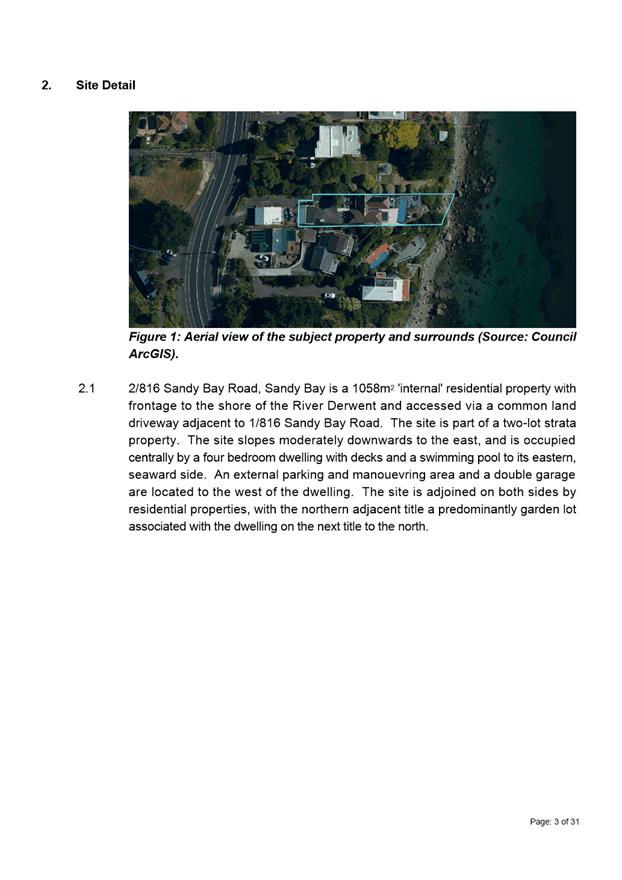

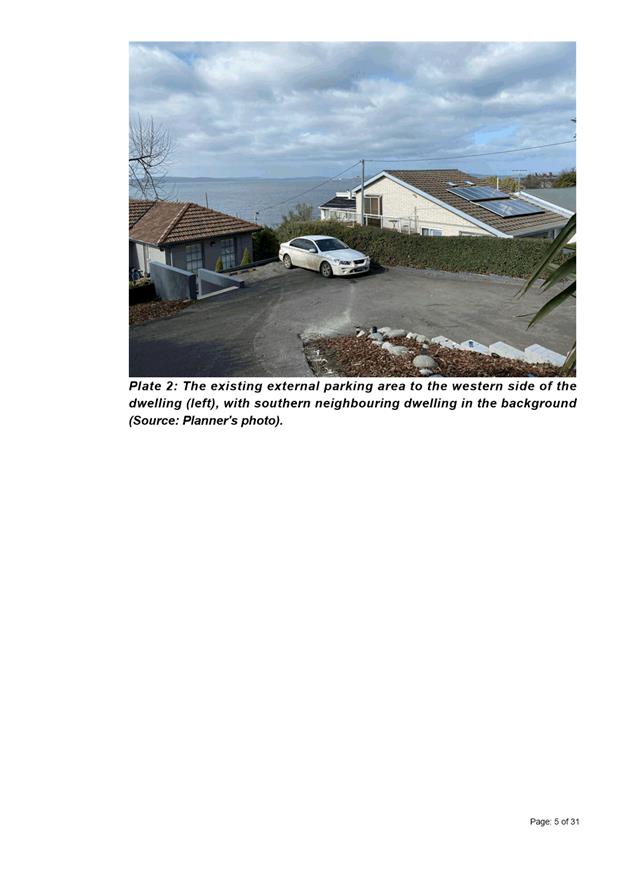



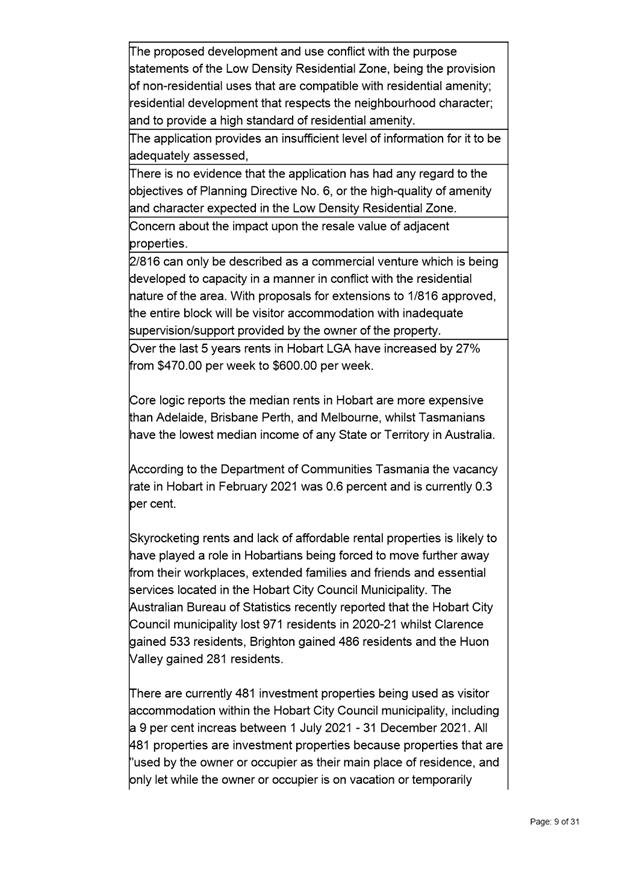
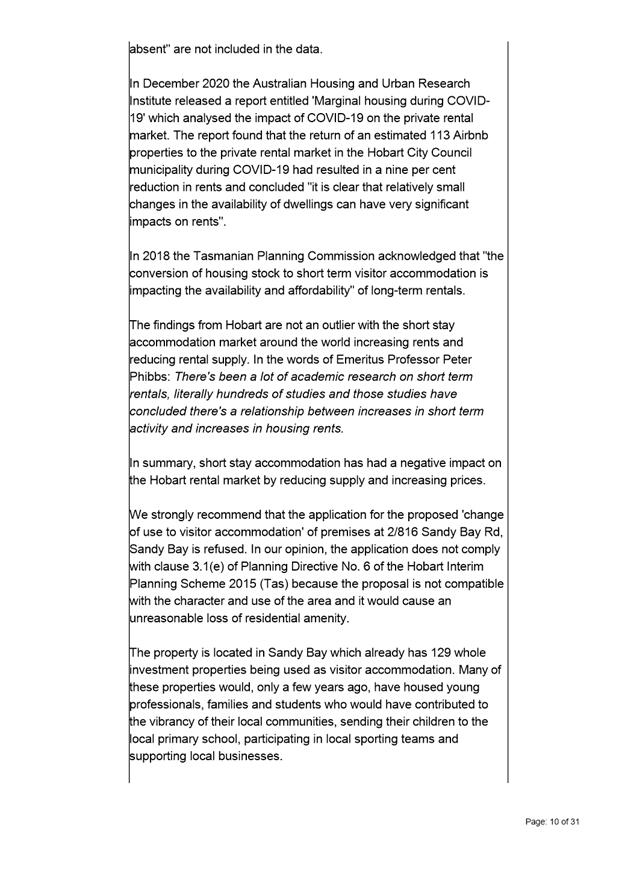
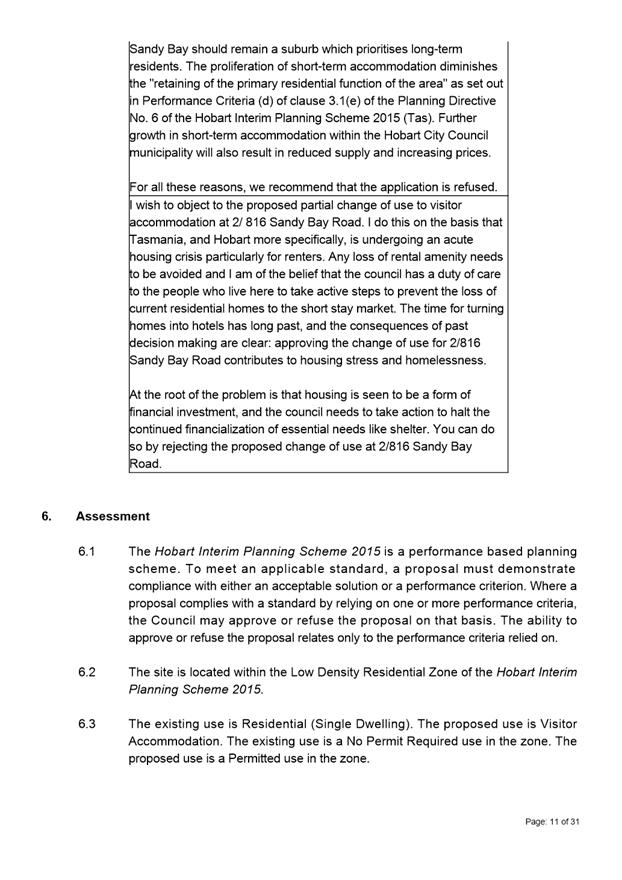

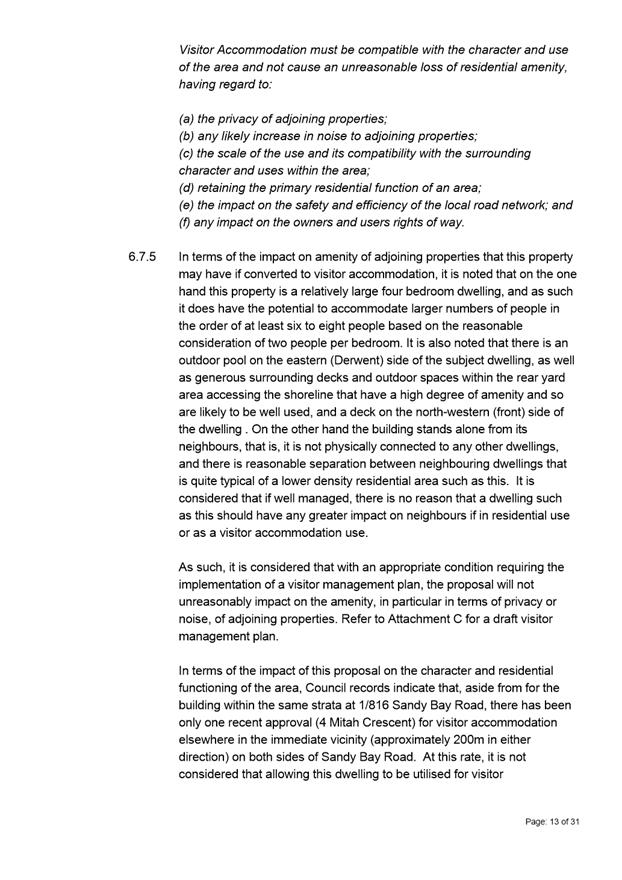

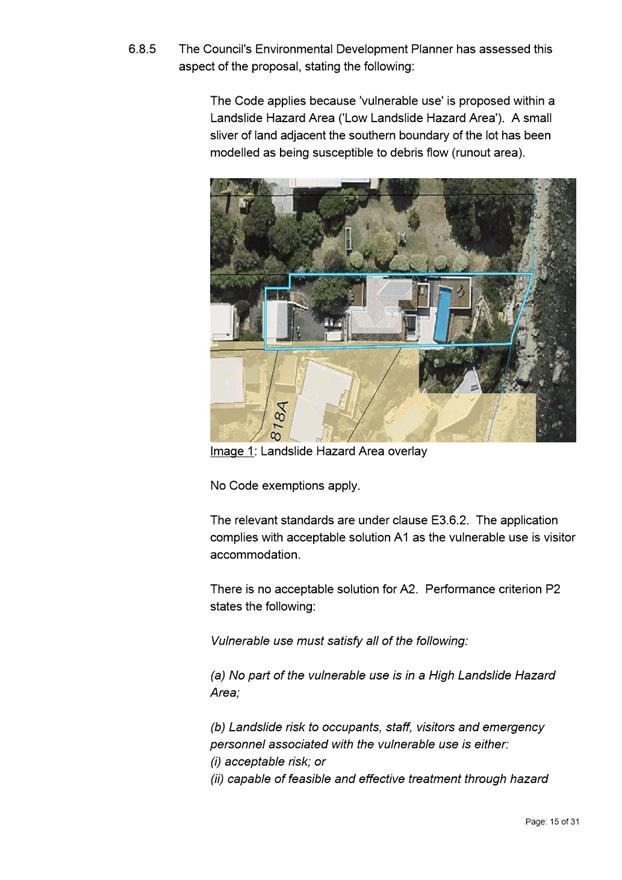



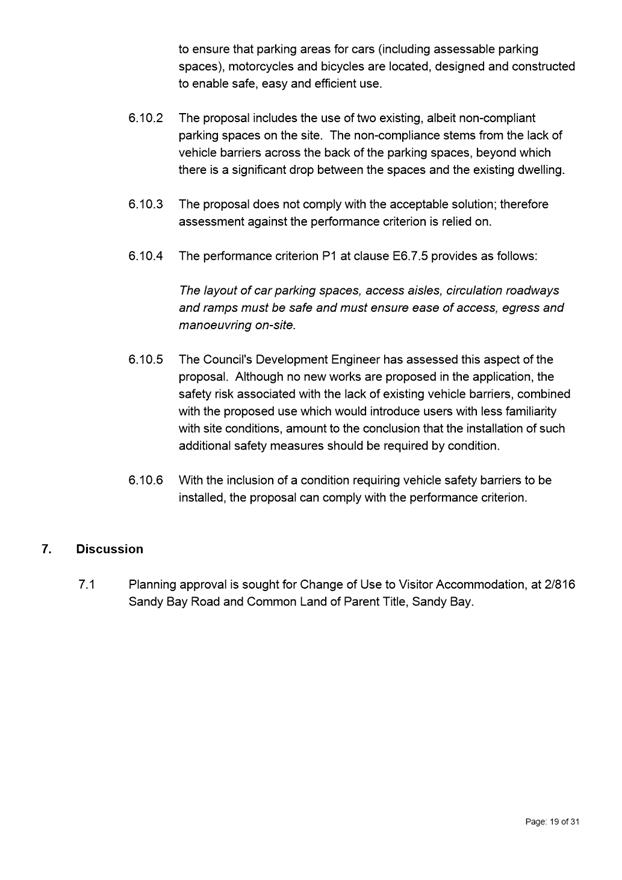
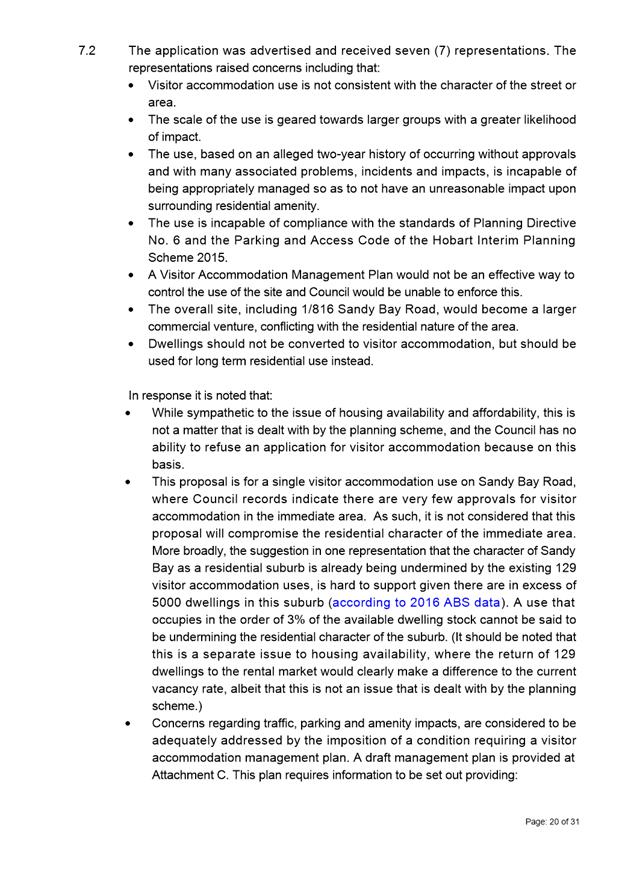
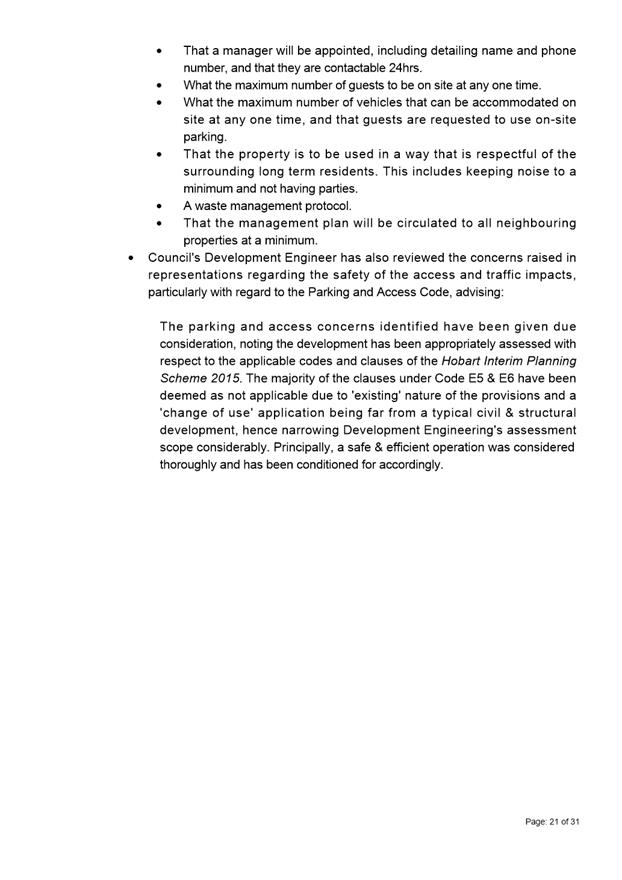
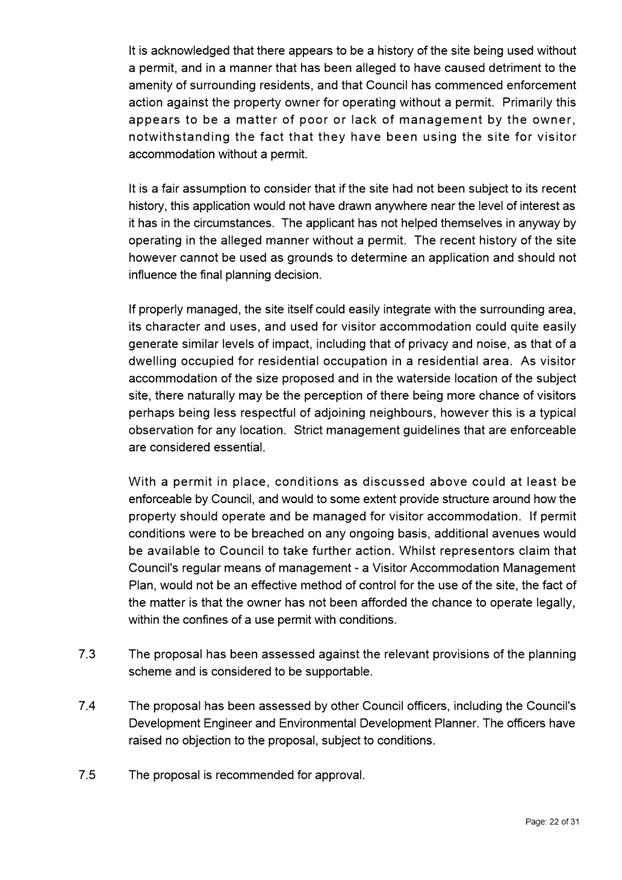
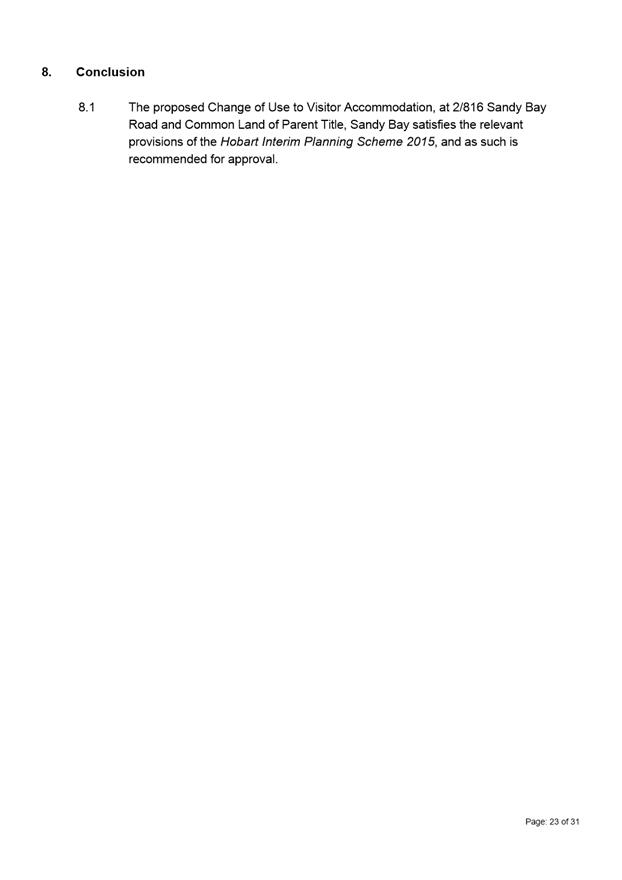
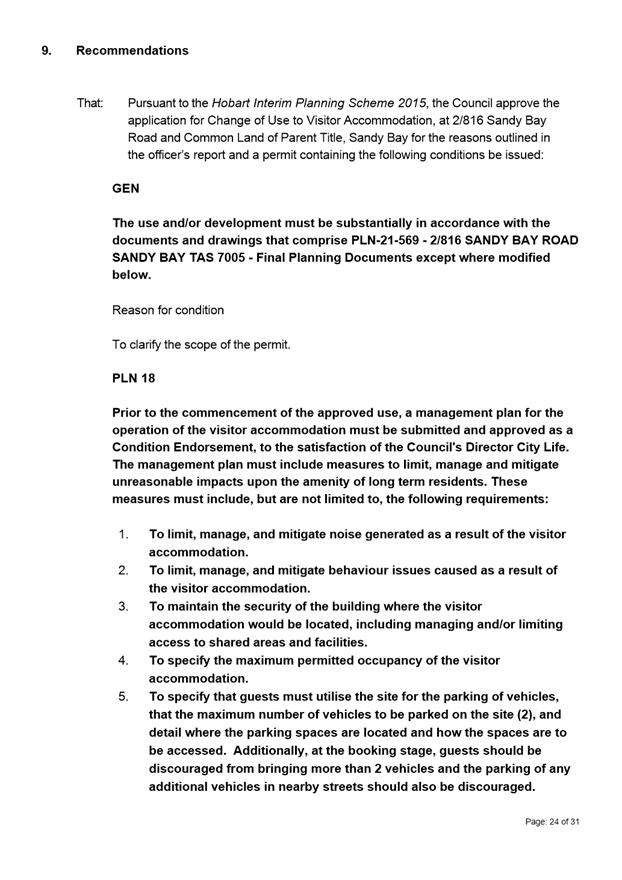
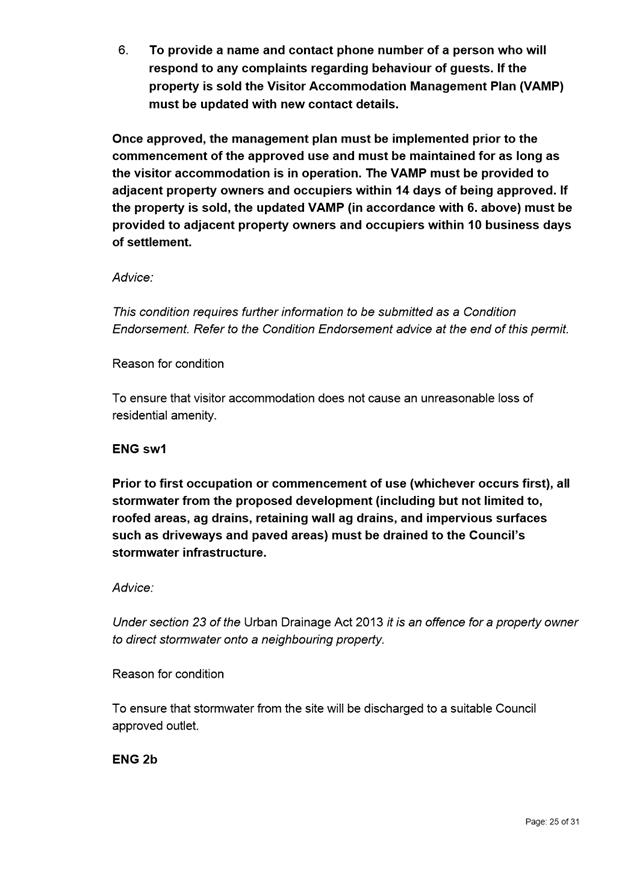
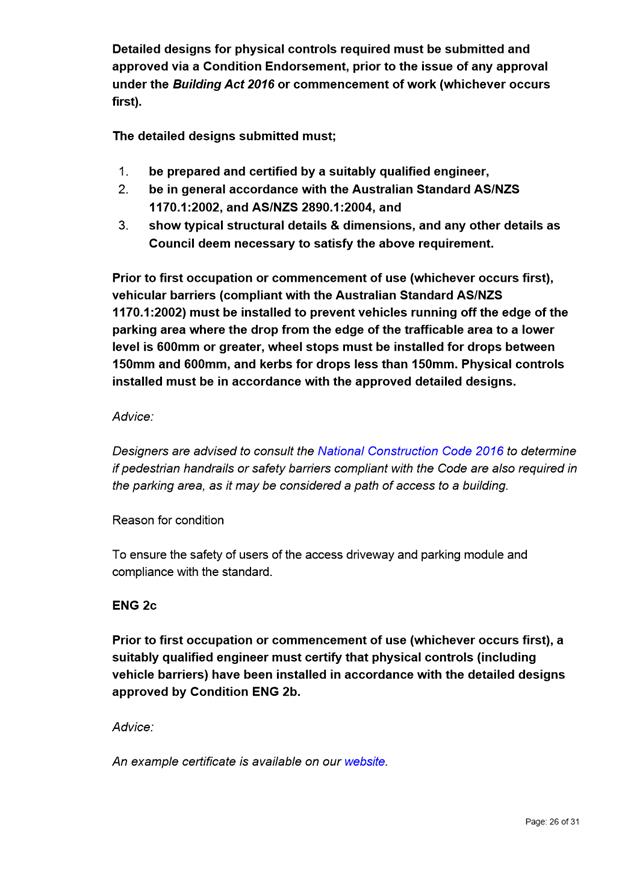
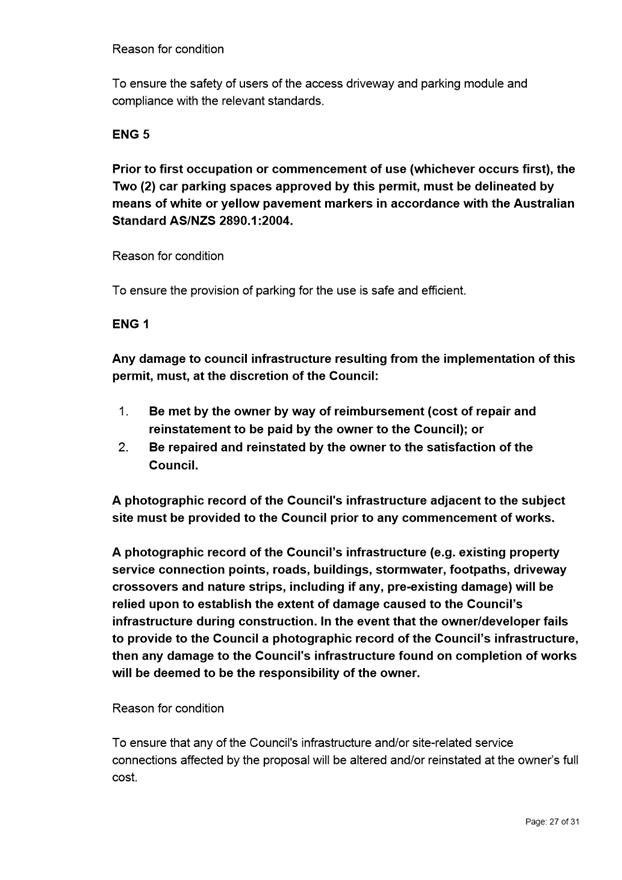
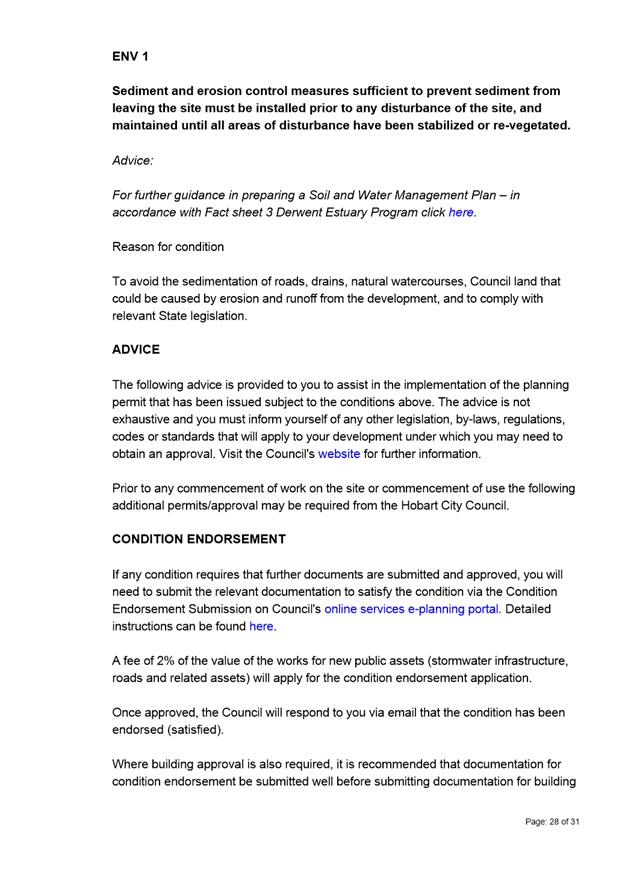
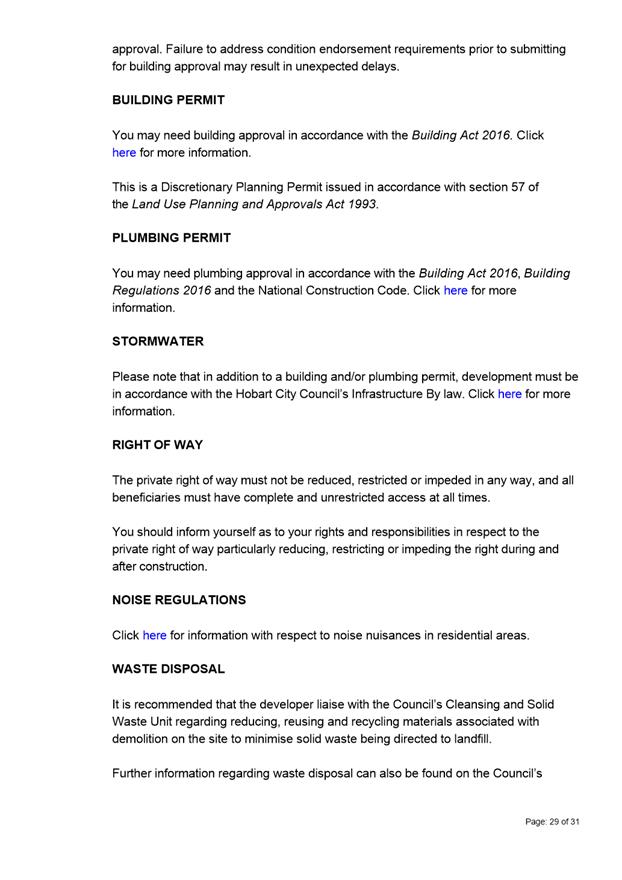
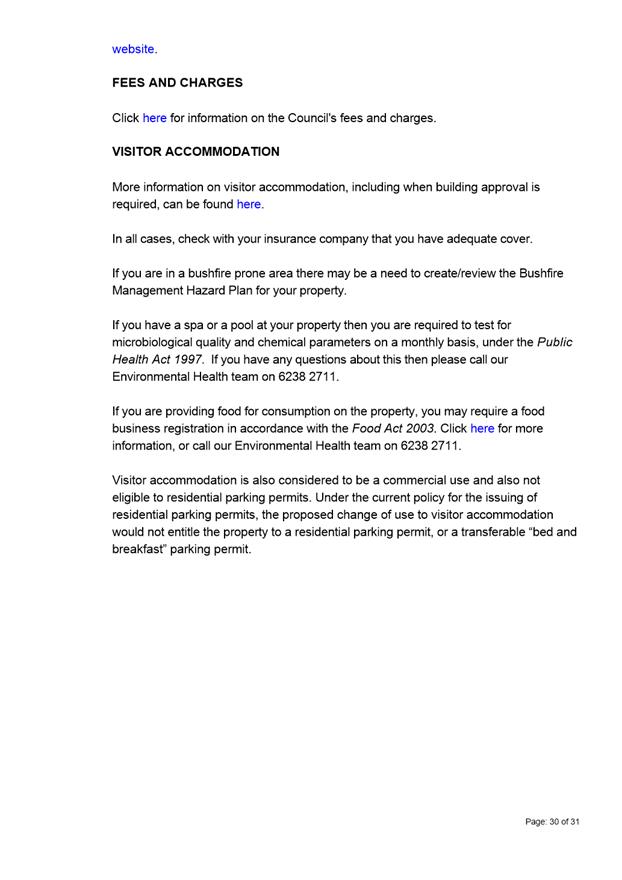
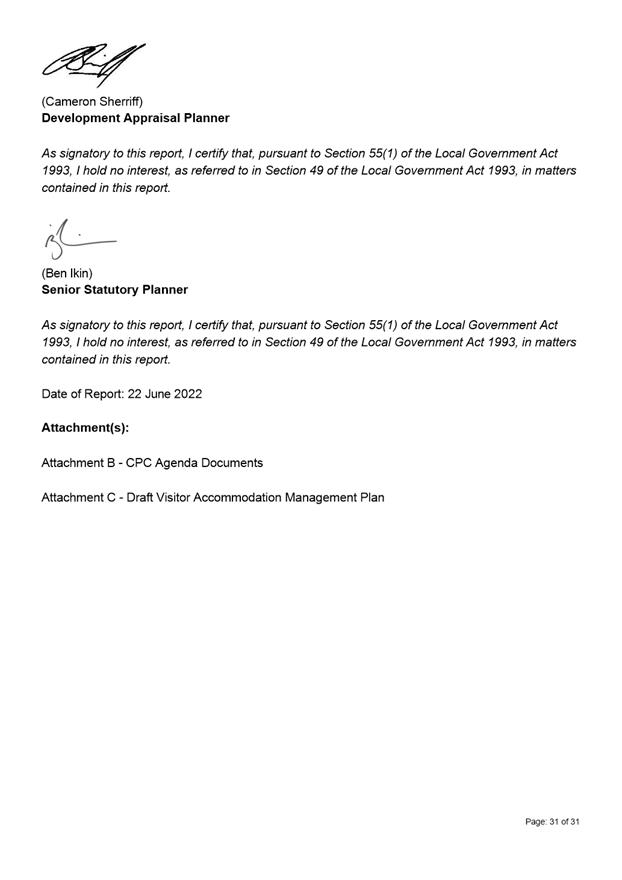
|
Agenda (Open Portion) City Planning Committee Meeting - 4/7/2022 |
Page 194 ATTACHMENT b |
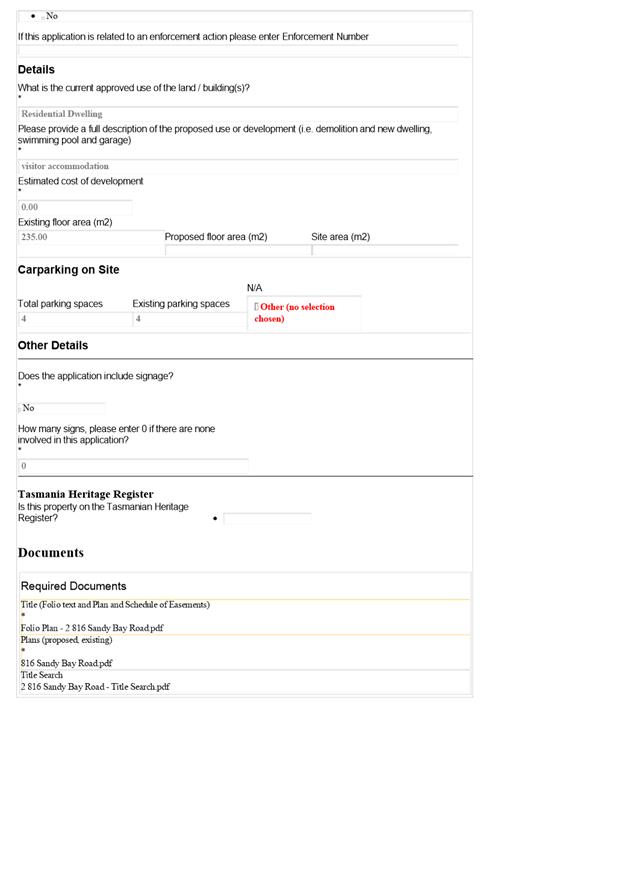
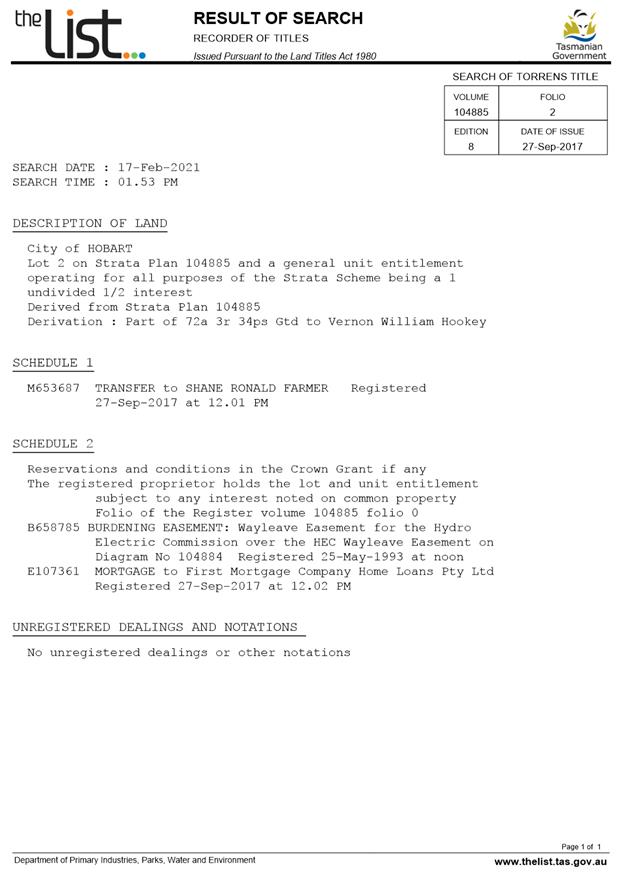
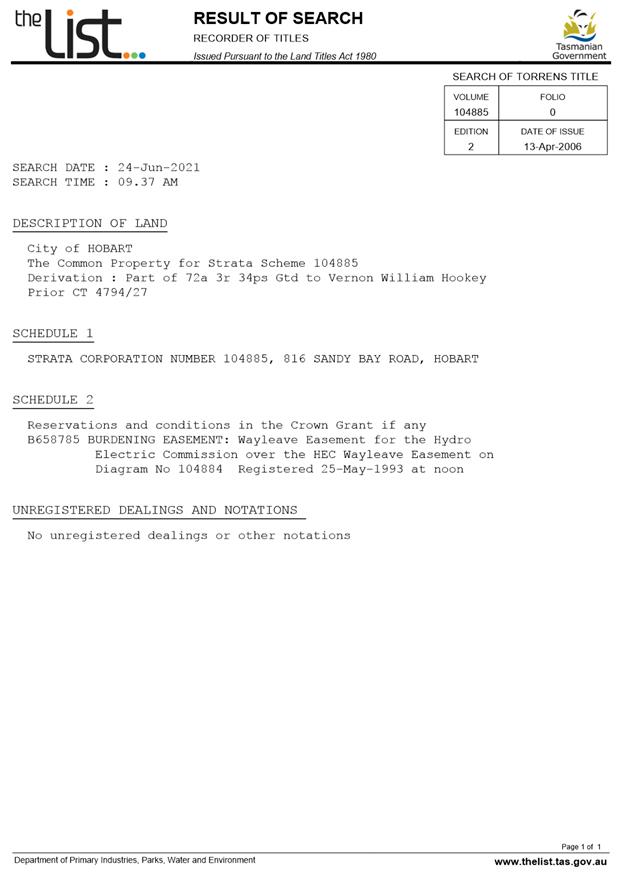
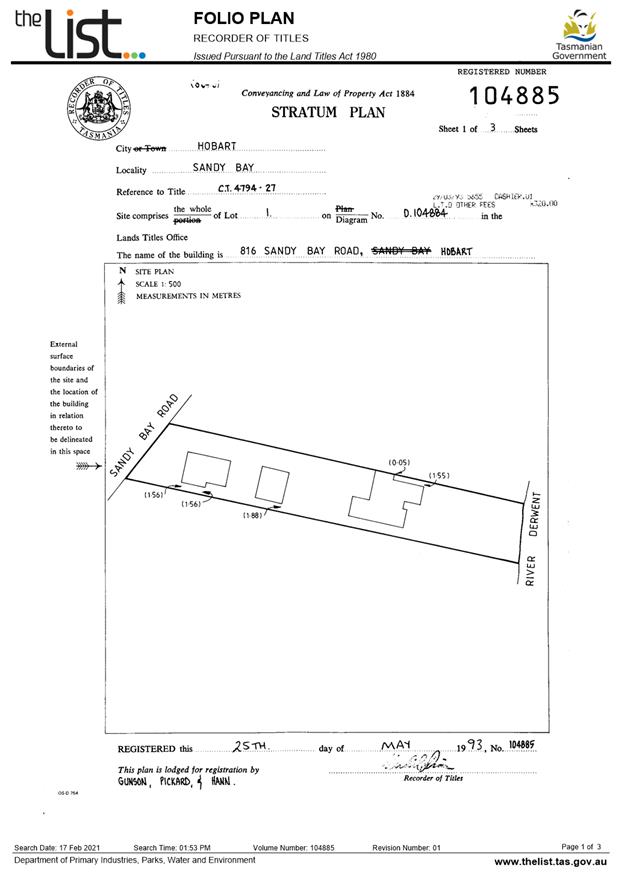
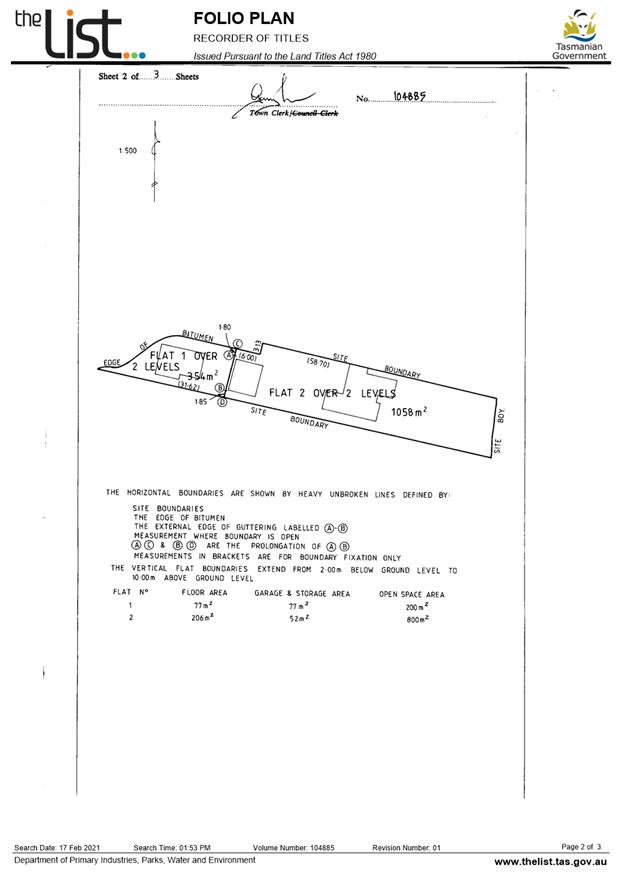
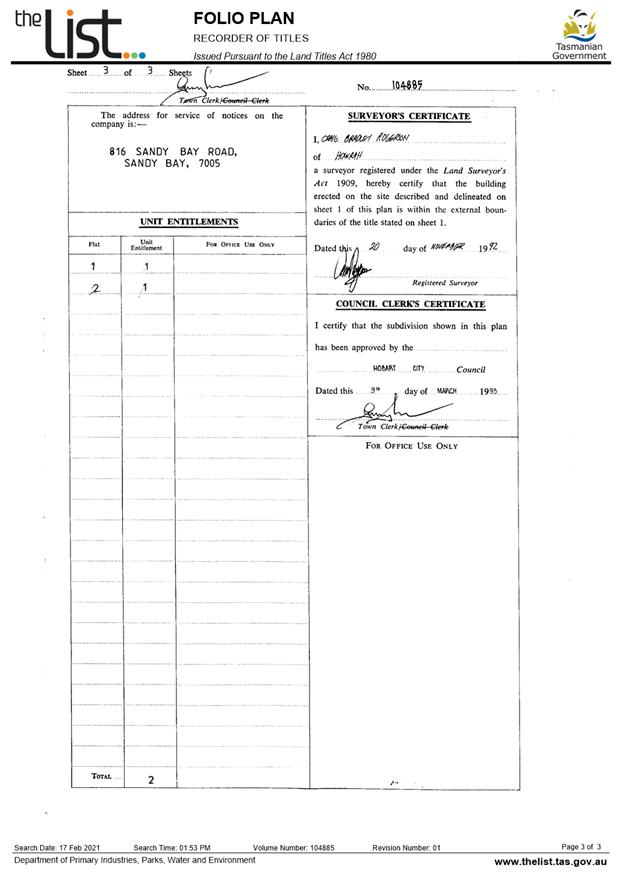
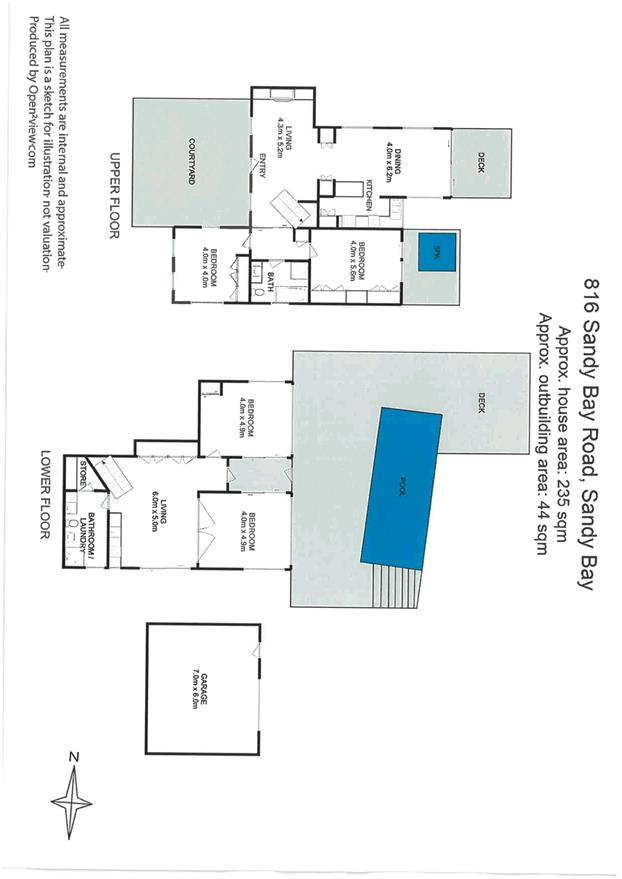

|
Agenda (Open Portion) City Planning Committee Meeting - 4/7/2022 |
Page 199 ATTACHMENT c |
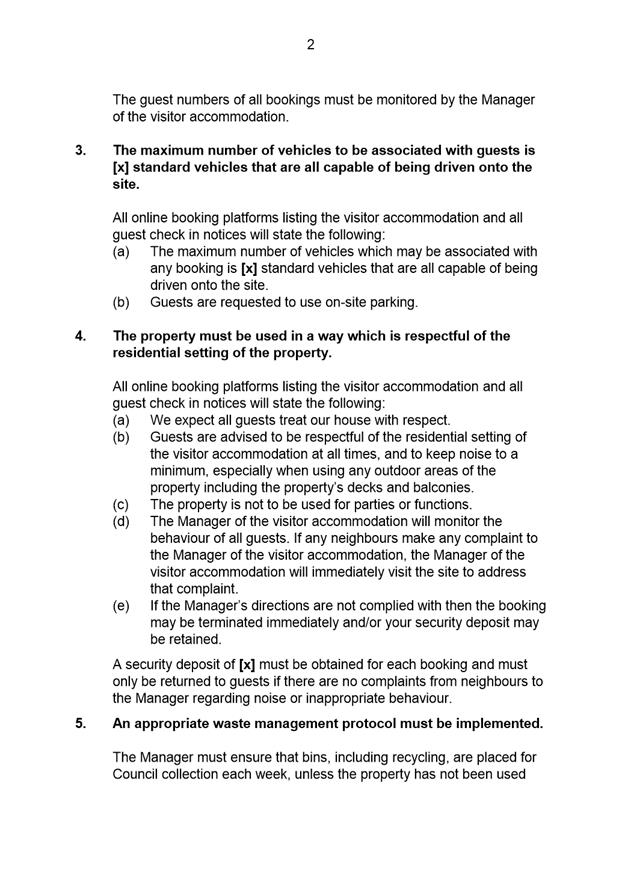
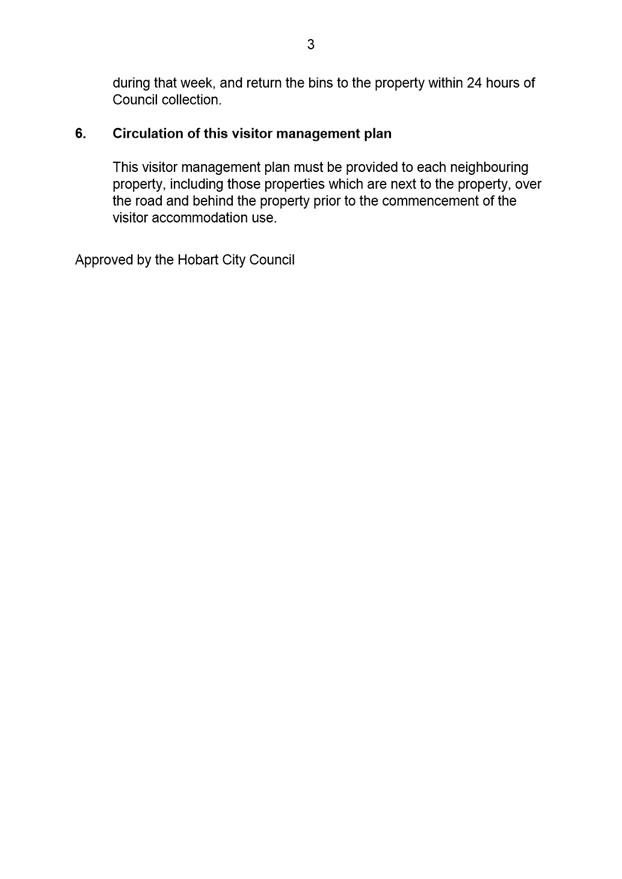
|
Agenda (Open Portion) City Planning Committee Meeting |
Page 202 |
|
|
|
4/7/2022 |
|
7.2.2 18 Grosvenor Street, Sandy Bay and Common Land of Parent Title - Change of Use to Visitor Accommodation
Address: 18 Grosvenor Street, Sandy Bay and Common Land of Parent Title
Proposal: Change of Use to Visitor Accommodation
Expiry Date: 11 July 2022
Extension of Time: No applicable
Author: Adam Smee
|
REcommendation That pursuant to the Hobart Interim Planning Scheme 2015, the Council approve the application for a change of use to visitor accommodation at 18 Grosvenor Street, Sandy Bay 7005 and the common land of the parent title for this property, for the reasons outlined in the officer’s report and a permit containing the following conditions be issued:
GEN
The use and/or development must be substantially in accordance with the documents and drawings that comprise PLN22328 18 GROSVENOR STREET SANDY BAY TAS 7005 Final Planning Documents.
Reason for condition
To clarify the scope of the permit.
PLN 18
Prior to the commencement of the approved use, a management plan for the operation of the visitor accommodation must be submitted and approved as a Condition Endorsement, to the satisfaction of the Council's Director City Life. The management plan must include measures to limit, manage and mitigate unreasonable impacts upon the amenity of long term residents. These measures must include, but are not limited to, the following requirements:
1. To limit, manage, and mitigate noise generated as a result of the visitor accommodation. 2. To limit, manage, and mitigate behaviour issues caused as a result of the visitor accommodation. 3. To maintain the security of the building where the visitor accommodation would be located, including managing and/or limiting access to shared areas and facilities. 4. To specify the maximum permitted occupancy of the visitor accommodation. 5. To provide a name and contact phone number of a person who will respond to any complaints regarding behaviour of guests. If the property is sold the Visitor Accommodation Management Plan (VAMP) must be updated with new contact details.
Once approved, the management plan must be implemented prior to the commencement of the approved use and must be maintained for as long as the visitor accommodation is in operation. The VAMP must be provided to adjacent property owners and occupiers within 14 days of being approved. If the property is sold, the updated VAMP (in accordance with 5. above) must be provided to adjacent property owners and occupiers within 10 business days of settlement.
Advice:
This condition requires further information to be submitted as a Condition Endorsement. Refer to the Condition Endorsement advice at the end of this permit.
Reason for condition
To ensure that visitor accommodation does not cause an unreasonable loss of residential amenity.
ADVICE
The following advice is provided to you to assist in the implementation of the planning permit that has been issued subject to the conditions above. The advice is not exhaustive and you must inform yourself of any other legislation, bylaws, regulations, codes or standards that will apply to your development under which you may need to obtain an approval. Visit the Council's website for further information.
VISITOR ACCOMMODATION
More information on visitor accommodation, including when building approval is required, can be found here.
In all cases, check with your insurance company that you have adequate cover. If you have a spa or a pool at your property then you are required to test for microbiological quality and chemical parameters on a monthly basis, under the Public Health Act 1997. If you have any questions about this then please call our Environmental Health team on 6238 2711.
If you are providing food for consumption on the property, you may require a food business registration in accordance with the Food Act 2003. Click here for more information, or call our Environmental Health team on 6238 2711.
Visitor accommodation is also considered to be a commercial use and also not eligible to residential parking permits. Under the current policy for the issuing of residential parking permits, the proposed change of use to visitor accommodation would not entitle the property to a residential parking permit, or a transferable “bed and breakfast” parking permit.
|
Attachment a: PLN-22-328
- 18 GROSVENOR STREET SANDY BAY TAS 7005 - Planning Committee or Delegated
Report ⇩ ![]()
Attachment
b: PLN-22-328
- 18 GROSVENOR STREET SANDY BAY TAS 7005 - CPC Agenda Documents ⇩ ![]()
|
Item No. 7.2.2 |
Agenda (Open Portion) City Planning Committee Meeting - 4/7/2022 |
Page 214 ATTACHMENT a |
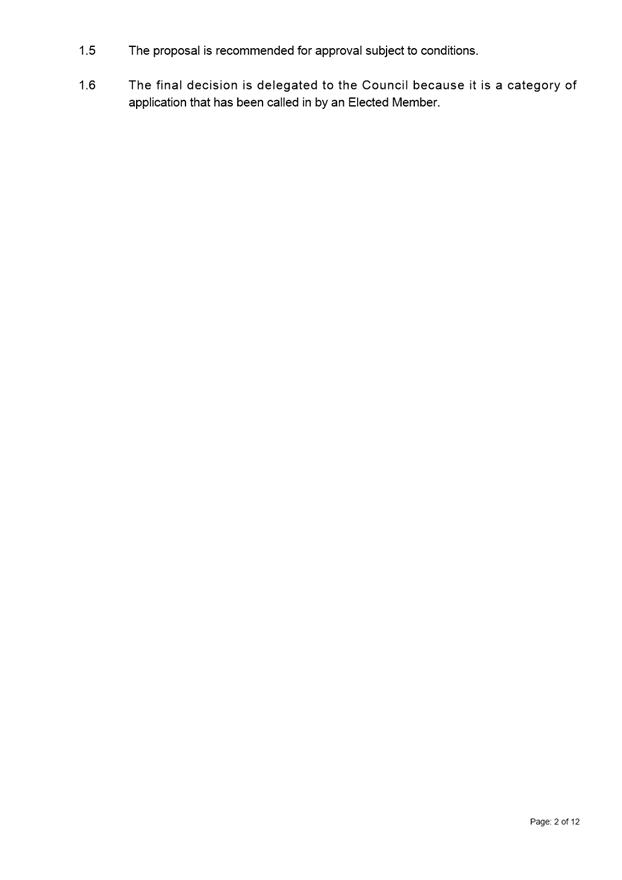
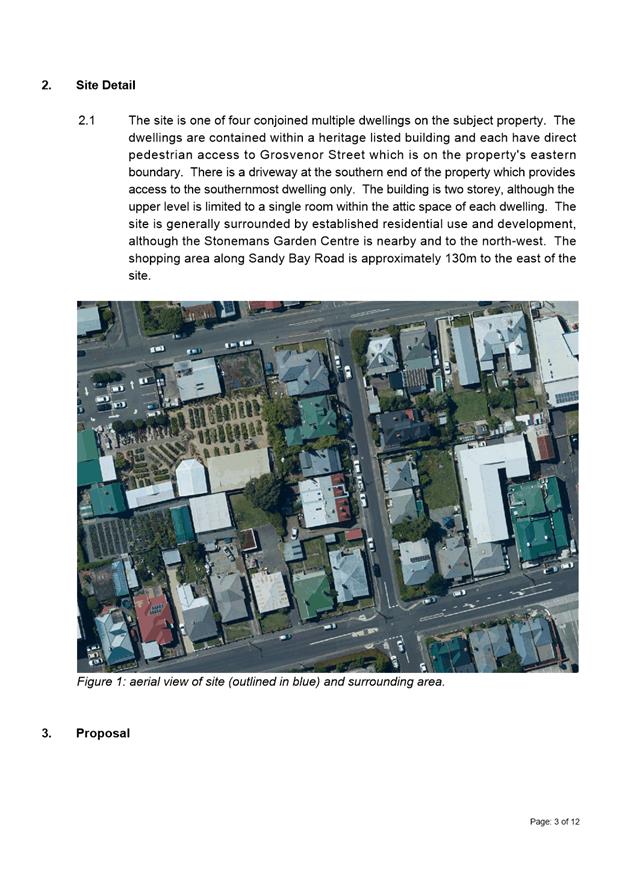
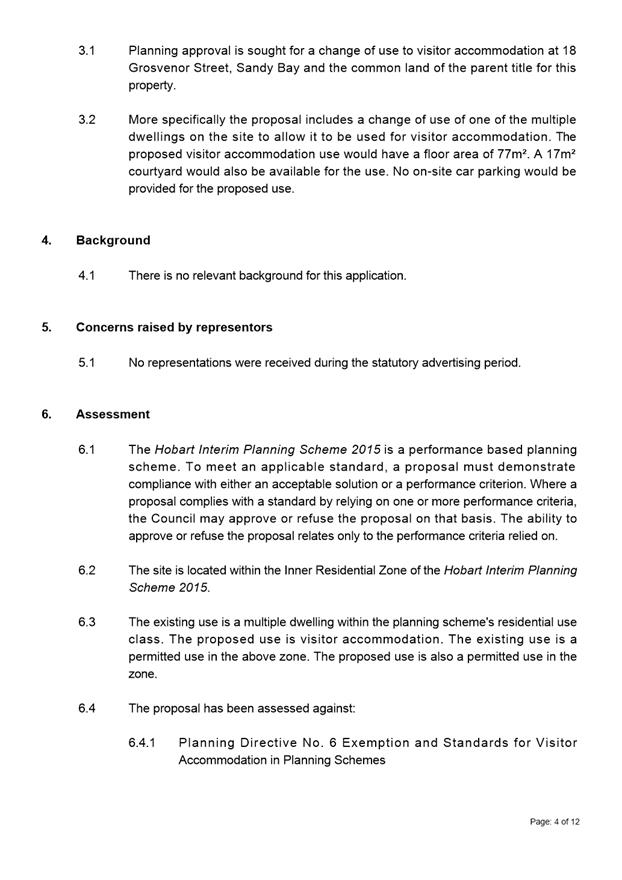
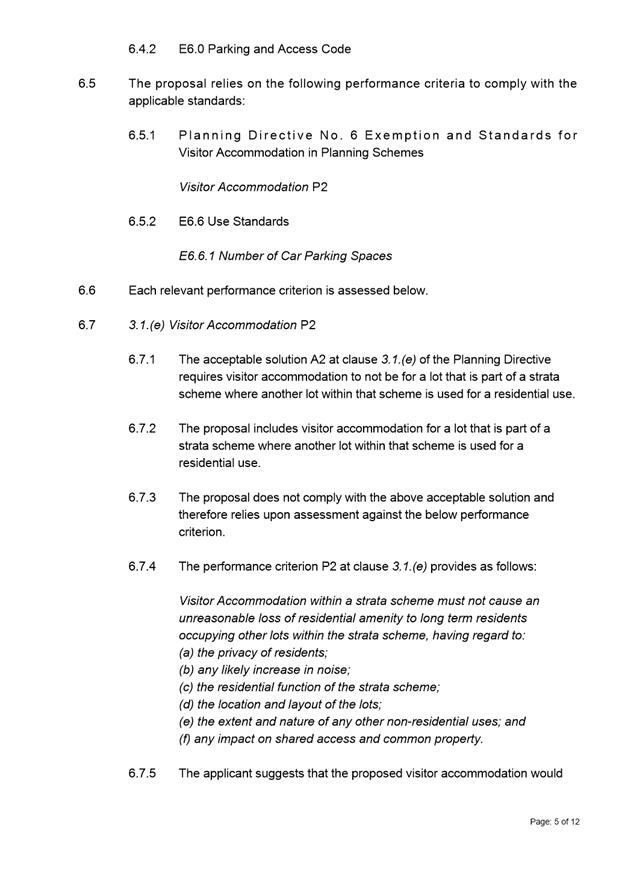
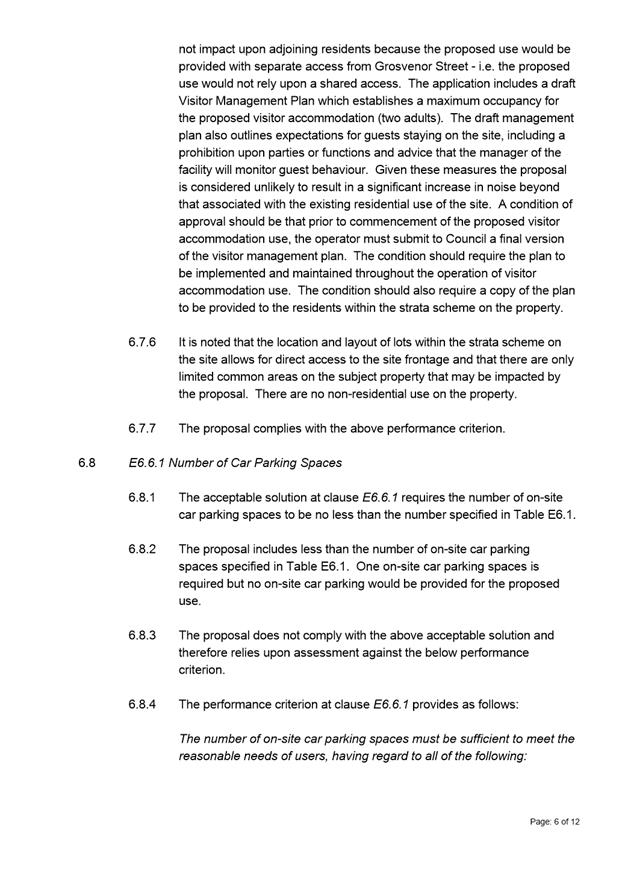
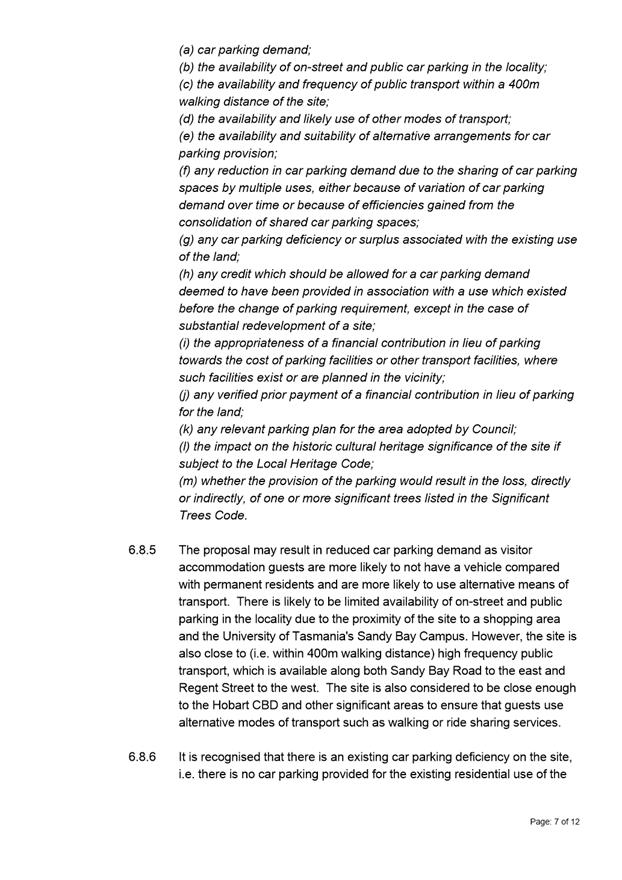
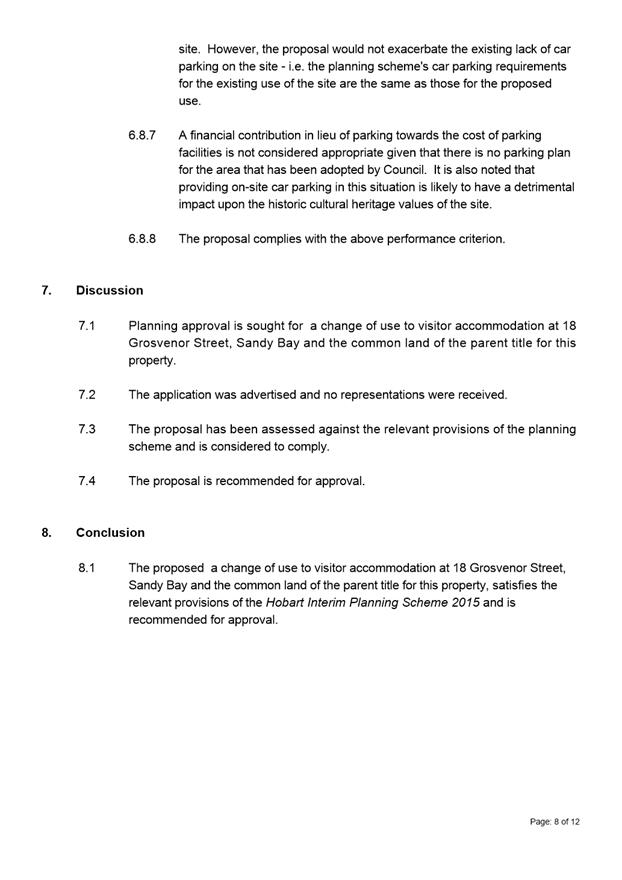

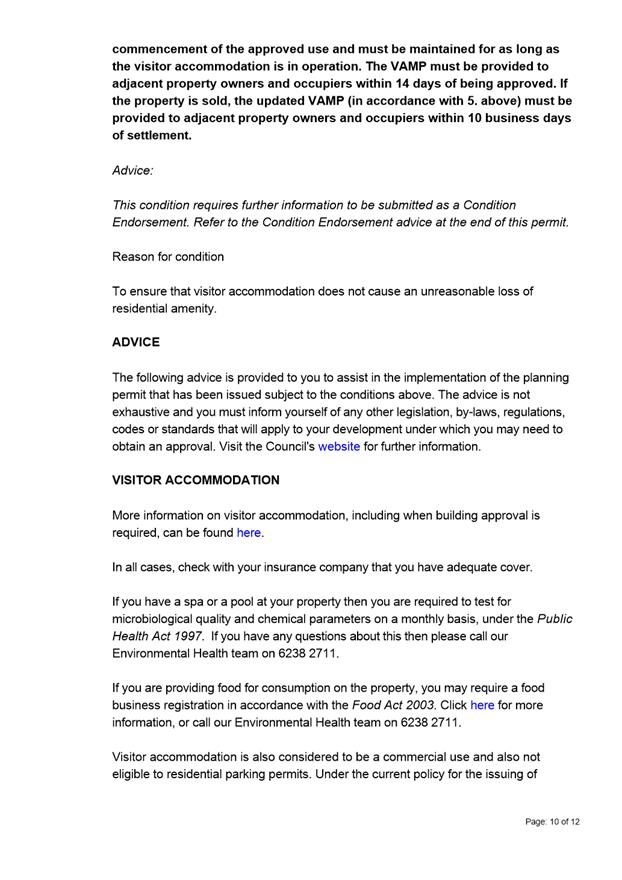
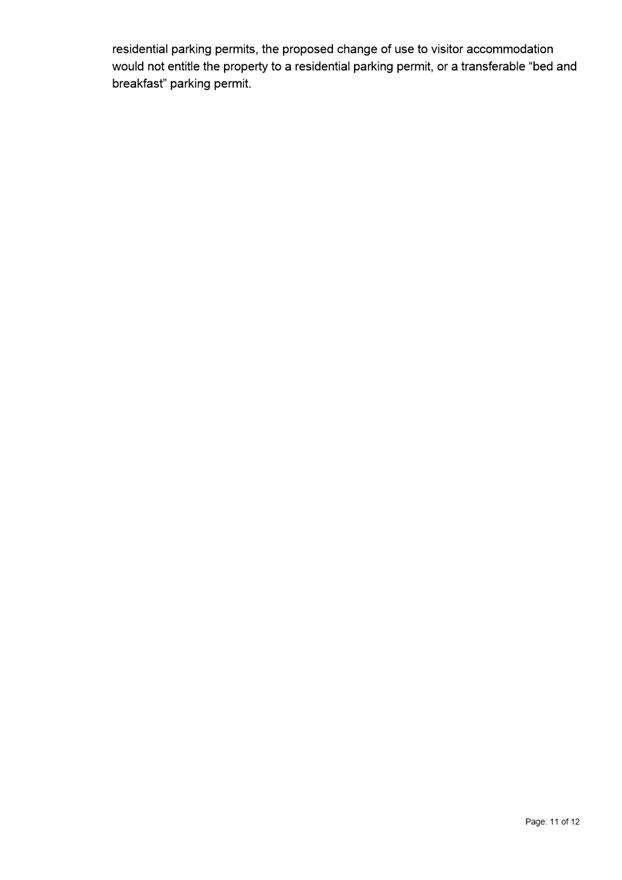
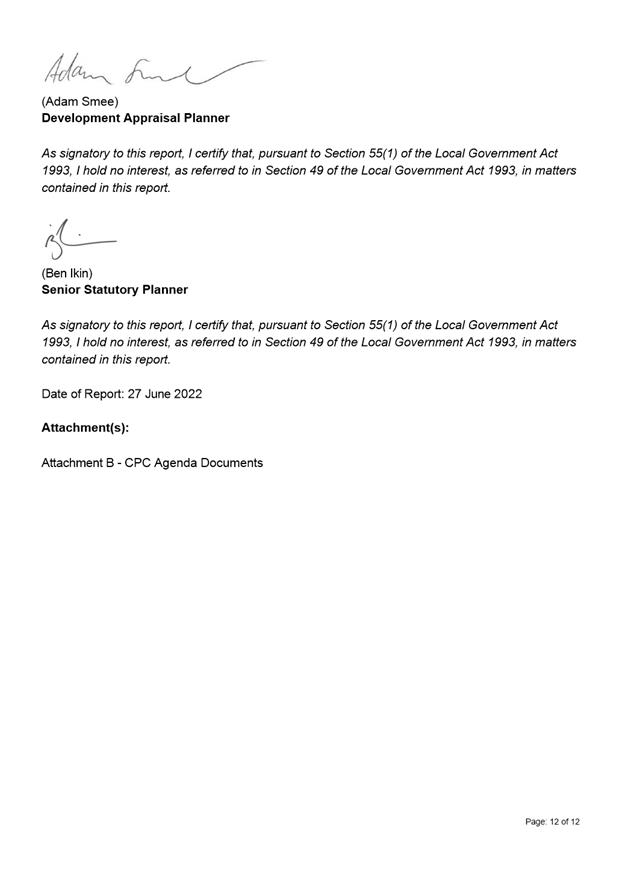
|
Agenda (Open Portion) City Planning Committee Meeting - 4/7/2022 |
Page 224 ATTACHMENT b |
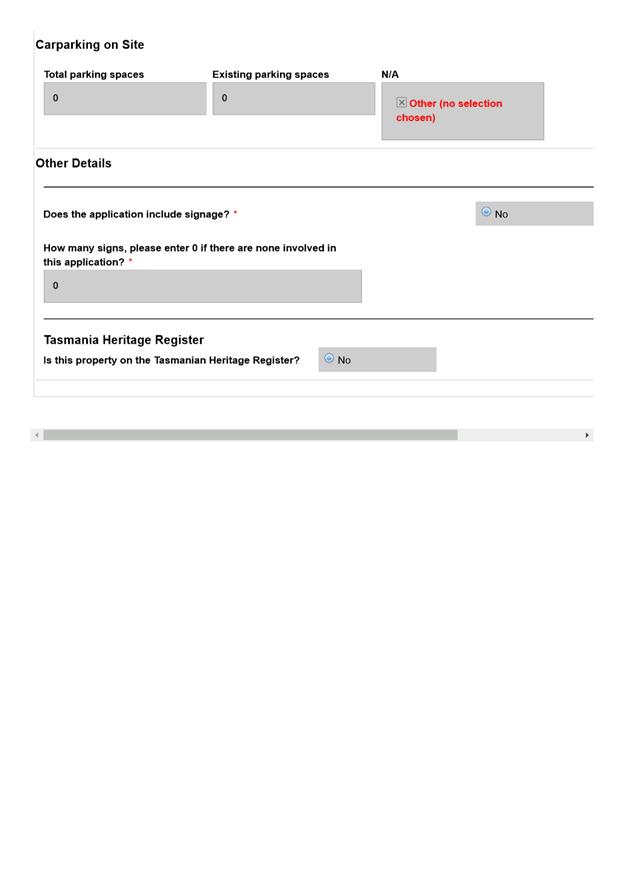
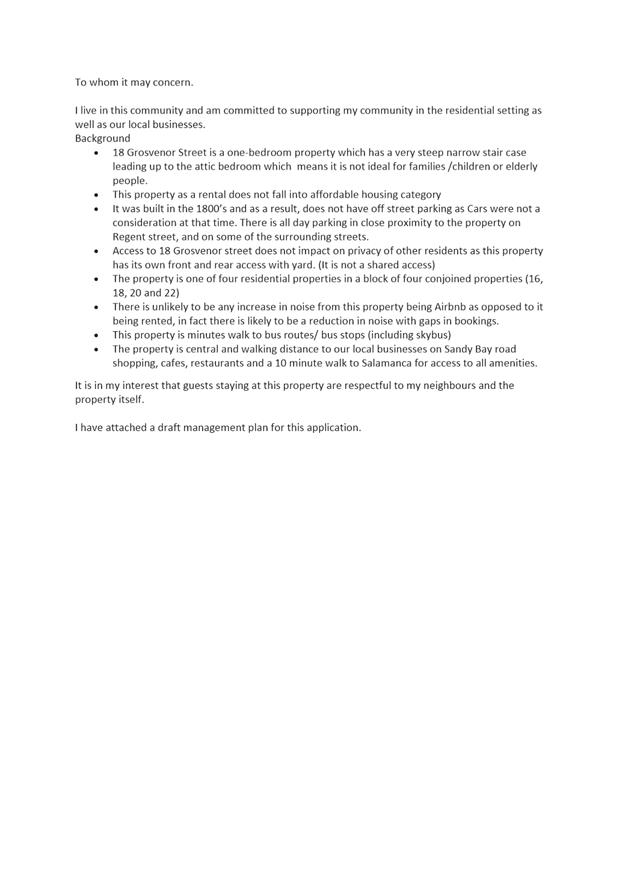
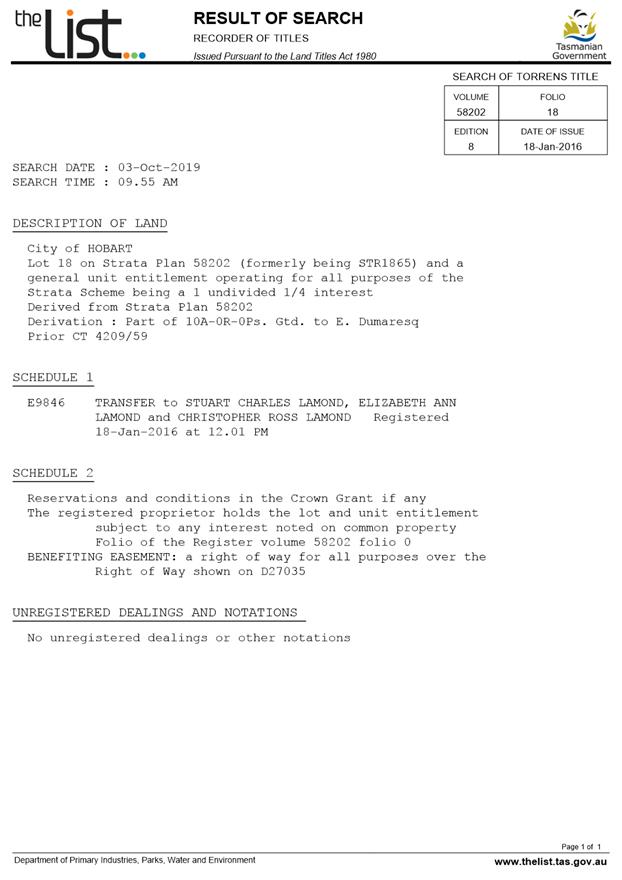
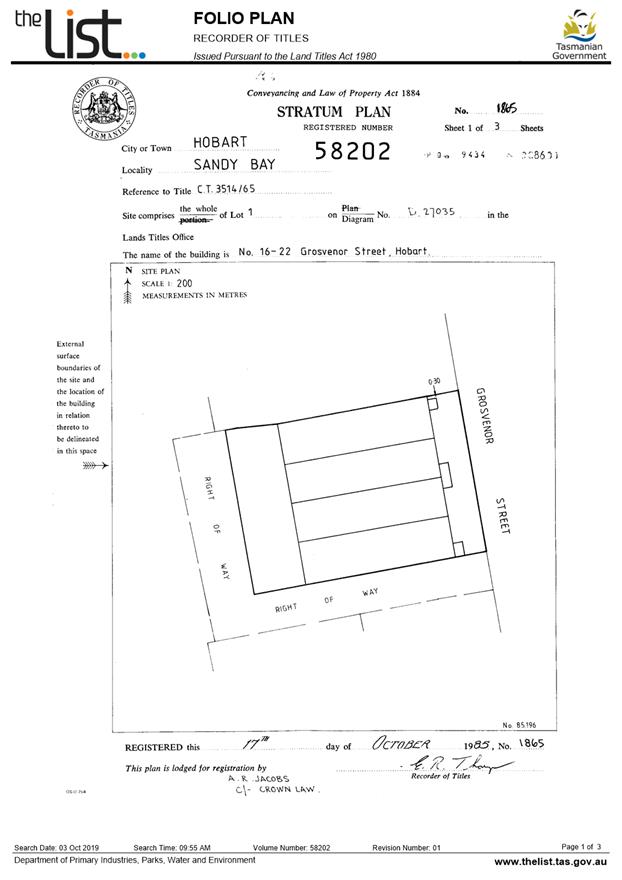
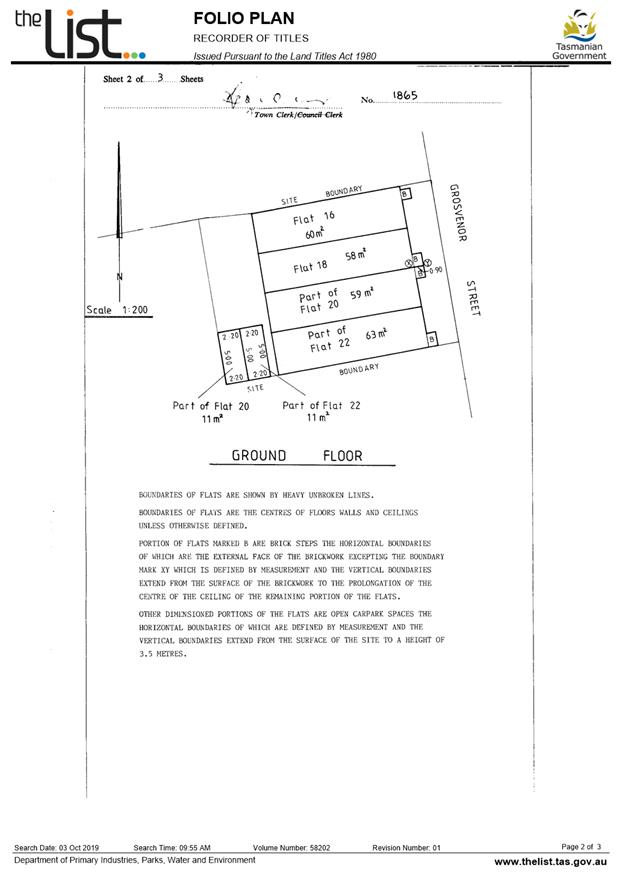
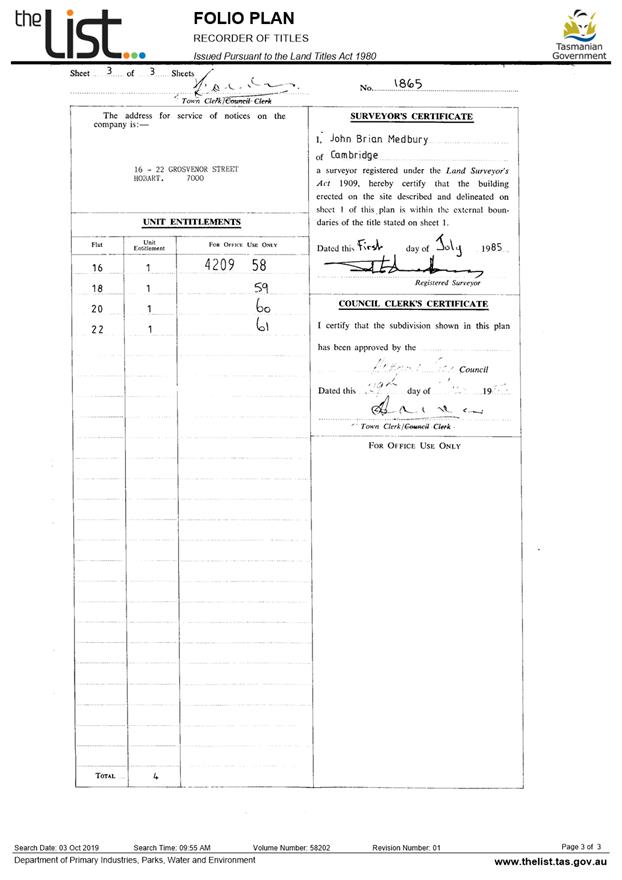
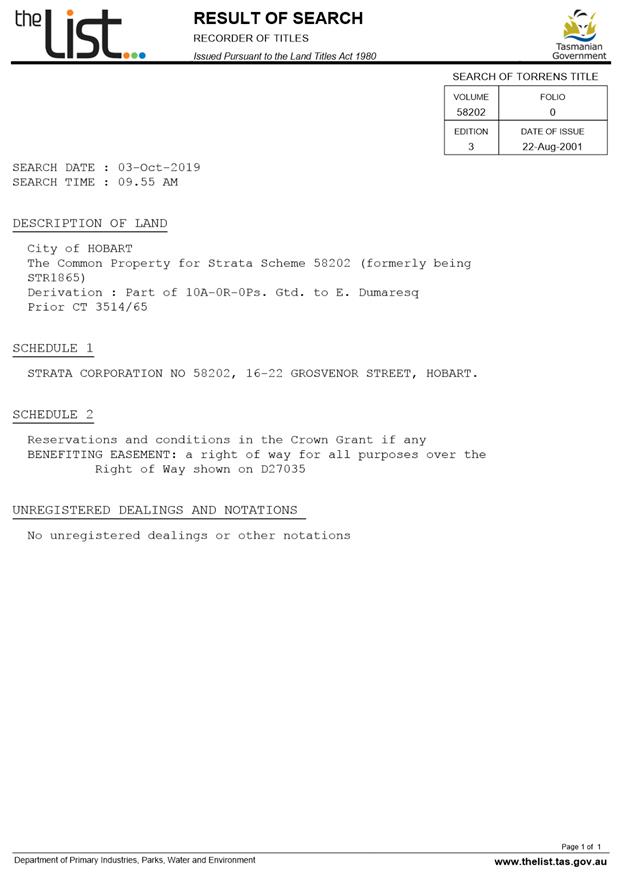
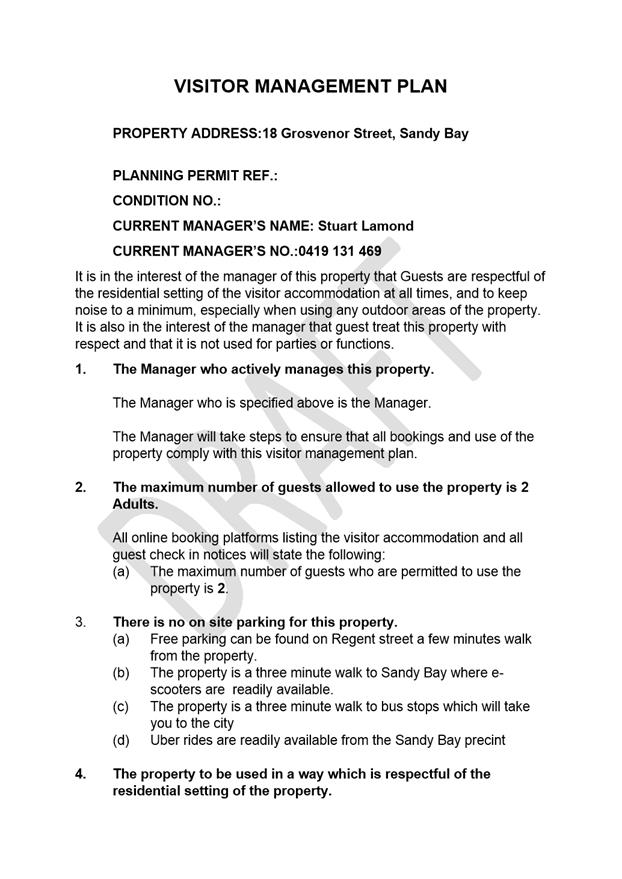
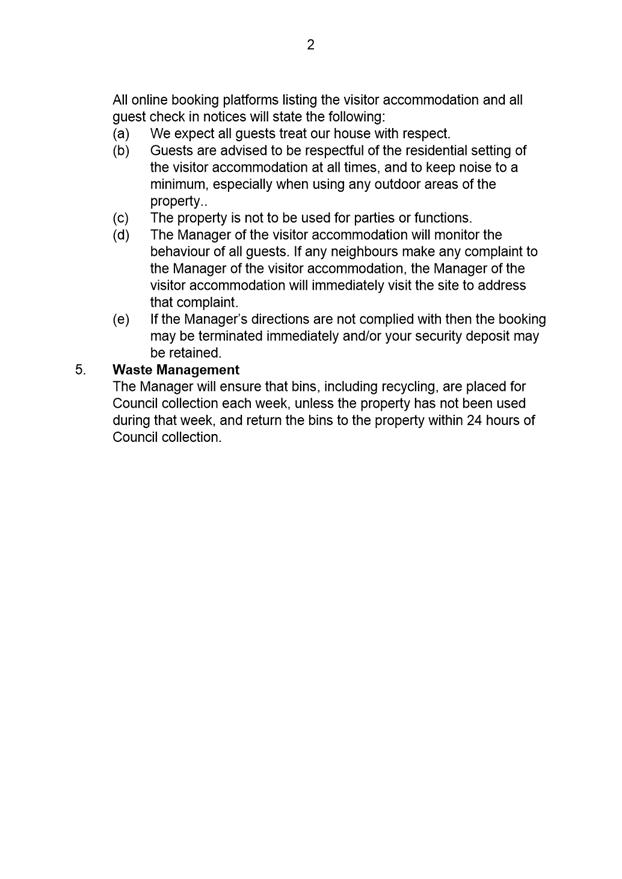
|
Item No. 7.2.3 |
Agenda (Open Portion) City Planning Committee Meeting |
Page 234 |
|
|
4/7/2022 |
|
7.2.3 110 Regent Street, Sandy Bay and Adjacent Road Reserve - Partial Demolition,Carport, Front Fencing and Work in Road Reserve
Address: 110 Regent Street, Sandy Bay and Adjacent Road Reserve
Proposal: Partial Demolition, Carport, Front Fencing and Work in Road Reserve
Expiry Date: 11 July 2022
Extension of Time: Not applicable
Author: Tristan Widdowson
|
REcommendation That pursuant to the Hobart Interim Planning Scheme 2015, the Council approve the application for partial demolition, carport, front fencing and work in the road reserve at 110 Regent Street, Sandy Bay 7005 for the reasons outlined in the officer’s report and a permit containing the following conditions be issued:
GEN
The use and/or development must be substantially in accordance with the documents and drawings that comprise PLN21881 110 REGENT STREET SANDY BAY TAS 7005 Final Planning Documents except where modified below.
Reason for condition
To clarify the scope of the permit.
ENG sw1
All stormwater from the proposed development (including but not limited to: roofed areas, ag drains, and impervious surfaces such as driveways and paved areas) must be drained to the Council’s stormwater infrastructure prior to first occupation or commencement of use (whichever occurs first).
Reason for condition
To ensure that stormwater from the site will be discharged to a suitable Council approved outlet.
SW 7
Prior to occupancy or the commencement of the use (whichever occurs first), any new or altered stormwater connection required must be constructed and existing redundant connection(s) be abandoned and sealed at the owner’s expense. No decrease in service to thirdparty properties may occur.
Prior to the issuing of any approval under the Building Act 2016 or commencement of works (whichever occurs first), detailed engineering drawings must be submitted and approved as a Condition Endorsement. The detailed engineering drawings must include:
1. the location of the proposed connections and all existing connections; 2. the size and design of the connection such that it is appropriate to safely service the development; 3. clearances from any nearby obstacles (eg services, crossovers, trees, poles, walls) 4. longsections of the proposed connection clearly showing cover, size, grade, material and delineation of public and private infrastructure; 5. connections which are freeflowing gravity driven. 6. be in general accordance with Council's departures from the LGAT Tasmanian Standard Drawings, available from here
All work required by this condition must be undertaken in accordance with the approved detailed engineering drawings.
Advice:
Upgraded or new connections can be approved separate from the CEP process, via the Application for New Connection form available from here. The approved stormwater connection documents must be included in your plumbing permit application document set and listed in accompanying forms. The affected connection for the neighbouring property must be of adequate size and level to maintain the level of service currently provided. Any works within the thirdparty land, or to their private infrastructure, must be clearly identified, and their permission sought in writing.
This condition requires further information to be submitted as a Condition Endorsement. Refer to the Condition Endorsement advice at the end of this permit.
SW 9
Prior to occupancy or the commencement of the approved use (whichever occurs first), stormwater detention for stormwater discharges from the development must be installed.
A stormwater management report and design must be submitted and approved as a Condition Endorsement, prior to the issue of any approval under the Building Act 2016 or the commencement of work on the site (whichever occurs first). The stormwater management report and design must be prepared by a suitably qualified engineer and must:
1. include detailed design and supporting calculations of the detention tank showing: 1. detention tank sizing such that there is no increase in flows from the developed site up to 5% AEP event and no worsening of flooding; 2. the layout, the inlet and outlet (including long section), outlet size, overflow mechanism and invert level; 3. the discharge rates and emptying times; and 4. all assumptions must be clearly stated;
2. include a supporting maintenance plan, which specifies the required maintenance measures to check and ensure the ongoing effective operation of all systems, such as: inspection frequency; cleanout procedures; descriptions and diagrams of how the installed systems operate; details of the life of assets and replacement requirements.
All work required by this condition must be undertaken and maintained in accordance with the approved stormwater management report and design.
Advice:
This condition requires further information to be submitted as a Condition Endorsement. Refer to the Condition Endorsement advice at the end of this permit.
ENG 3a
The parking area must be constructed in accordance with the following documentation which forms part of this permit: Preston Lane documentation received by the Council on 17 May 2022.
Any departure from that documentation and any works which are not detailed in the documentation must be either:
a) approved by the Director City Life, via a condition endorsement application; or b) designed and constructed in accordance with Australian Standard AS/NZ 2890.1:2004.
The works required by this condition must be completed prior to first occupation.
Reason for condition
To ensure the safety of users of the access and parking module, and compliance with the relevant Australian Standard.
ENG 4
The access driveway and parking module (car parking spaces, aisles and manoeuvring area) approved by this permit must be constructed to a sealed standard (spray seal, asphalt, concrete, pavers or equivalent Council approved) and surface drained to the Council's stormwater infrastructure prior to the commencement of use.
Reason for condition
To ensure the safety of users of the access driveway and parking module, and that it does not detract from the amenity of users, adjoining occupiers or the environment by preventing dust, mud and sediment transport.
ENG 1
Any damage to council infrastructure resulting from the implementation of this permit, must, at the discretion of the Council:
1. Be met by the owner by way of reimbursement (cost of repair and reinstatement to be paid by the owner to the Council); or 2. Be repaired and reinstated by the owner to the satisfaction of the Council.
A photographic record of the Council's infrastructure adjacent to the subject site must be provided to the Council prior to any commencement of works.
A photographic record of the Council’s infrastructure (e.g. existing property service connection points, roads, buildings, stormwater, footpaths, driveway crossovers and nature strips, including if any, preexisting damage) will be relied upon to establish the extent of damage caused to the Council’s infrastructure during construction. In the event that the owner/developer fails to provide to the Council a photographic record of the Council’s infrastructure, then any damage to the Council's infrastructure found on completion of works will be deemed to be the responsibility of the owner.
Reason for condition
To ensure that any of the Council's infrastructure and/or siterelated service connections affected by the proposal will be altered and/or reinstated at the owner’s full cost.
ENG r3
Prior to the commencement of use, the proposed driveway crossover on the Alexander Street highway reservation must be designed and constructed in general accordance with:
· Urban TSDR09v3 – Urban Roads Driveways and TSD R14v3 Type KC vehicular crossing;
Design drawings must be submitted and approved as a Condition Endorsement prior to any approval under the Building Act 2016. The design drawings must:
1. Show the cross and long section of the driveway crossover within the highway reservation and onto the property; 2. Detail any services or infrastructure (ie light poles, pits, awnings) at or near the proposed driveway crossover; 3. Show that vehicular and pedestrian sight lines are met as per AS/NZS 2890.1 2004. 4. Be prepared and certified by a suitable qualified person, to satisfy the above requirements.
All work required by this condition must be undertaken in accordance with the approved drawings.
Advice:
This condition requires further information to be submitted as a Condition Endorsement. Refer to the Condition Endorsement advice at the end of this permit.
Please note that your proposal does not include adjustment of footpath levels. Any adjustment to footpath levels necessary to suit the design of proposed floor, parking module or driveway levels will require separate agreement from Council's Program Leader Road Services and may require further planning approvals. It is advised to place a note to this affect on construction drawings for the site and/or other relevant engineering drawings to ensure that contractors are made aware of this requirement.
Reason for condition
To ensure that works will comply with the Council’s standard requirements.
ENV 1
Sediment and erosion control measures sufficient to prevent sediment from leaving the site must be installed prior to any disturbance of the site, and maintained until all areas of disturbance have been stabilized or revegetated.
Advice:
For further guidance in preparing a Soil and Water Management Plan – in accordance with Fact sheet 3 Derwent Estuary Program click here.
Reason for condition
To avoid the sedimentation of roads, drains, natural watercourses, Council land that could be caused by erosion and runoff from the development, and to comply with relevant State legislation.
ADVICE
The following advice is provided to you to assist in the implementation of the planning permit that has been issued subject to the conditions above. The advice is not exhaustive and you must inform yourself of any other legislation, bylaws, regulations, codes or standards that will apply to your development under which you may need to obtain an approval. Visit the Council's website for further information.
Prior to any commencement of work on the site or commencement of use the following additional permits/approval may be required from the Hobart City Council.
CONDITION ENDORSEMENT
If any condition requires that further documents are submitted and approved, you will need to submit the relevant documentation to satisfy the condition via the Condition Endorsement Submission on Council's online services eplanning portal. Detailed instructions can be found here.
A fee of 2% of the value of the works for new public assets (stormwater infrastructure, roads and related assets) will apply for the condition endorsement application.
Once approved, the Council will respond to you via email that the condition has been endorsed (satisfied).
Where building approval is also required, it is recommended that documentation for condition endorsement be submitted well before submitting documentation for building approval. Failure to address condition endorsement requirements prior to submitting for building approval may result in unexpected delays.
BUILDING PERMIT
You may need building approval in accordance with the Building Act 2016. Click here for more information.
This is a Discretionary Planning Permit issued in accordance with section 57 of the Land Use Planning and Approvals Act 1993.
PLUMBING PERMIT
You may need plumbing approval in accordance with the Building Act 2016, Building Regulations 2016 and the National Construction Code. Click here for more information.
OCCUPATION OF THE PUBLIC HIGHWAY
You may require a Permit to Open Up and Temporarily Occupy a Highway (for work in the road reserve). Click here for more information.
NEW SERVICE CONNECTION
Please contact the Hobart City Council's City Life Division to initiate the application process for your new stormwater connection.
STORMWATER
Please note that in addition to a building and/or plumbing permit, development must be in accordance with the Hobart City Council’s Infrastructure By law. Click here for more information.
WORK WITHIN THE HIGHWAY RESERVATION
Please note development must be in accordance with the Hobart City Council’s Infrastructure by law. Click here for more information.
DRIVEWAY SURFACING OVER HIGHWAY RESERVATION
If a coloured or textured surface is used for the driveway access within the Highway Reservation, the Council or other service provider will not match this on any reinstatement of the driveway access within the Highway Reservation required in the future.
FEES AND CHARGES
Click here for information on the Council's fees and charges.
DIAL BEFORE YOU DIG
Click here for dial before you dig information.
|
Attachment
a: PLN-21-881
- 110 REGENT STREET SANDY BAY TAS 7005 - Planning Committee or Delegated Report ⇩ ![]()
Attachment
b: PLN-21-881
- 110 REGENT STREET SANDY BAY TAS 7005 - CPC Agenda Documents ⇩ ![]()
Attachment
c: PLN-21-881
- 110 REGENT STREET SANDY BAY TAS 7005 - Planning Referral Officer Cultural
Heritage Report ⇩ ![]()
Attachment
d: PLN-21-881
- 110 REGENT STREET SANDY BAY TAS 7005 - Planning Referral Officer Development
Engineering Report ⇩ ![]()
|
Item No. 7.2.3 |
Agenda (Open Portion) City Planning Committee Meeting - 4/7/2022 |
Page 254 ATTACHMENT a |
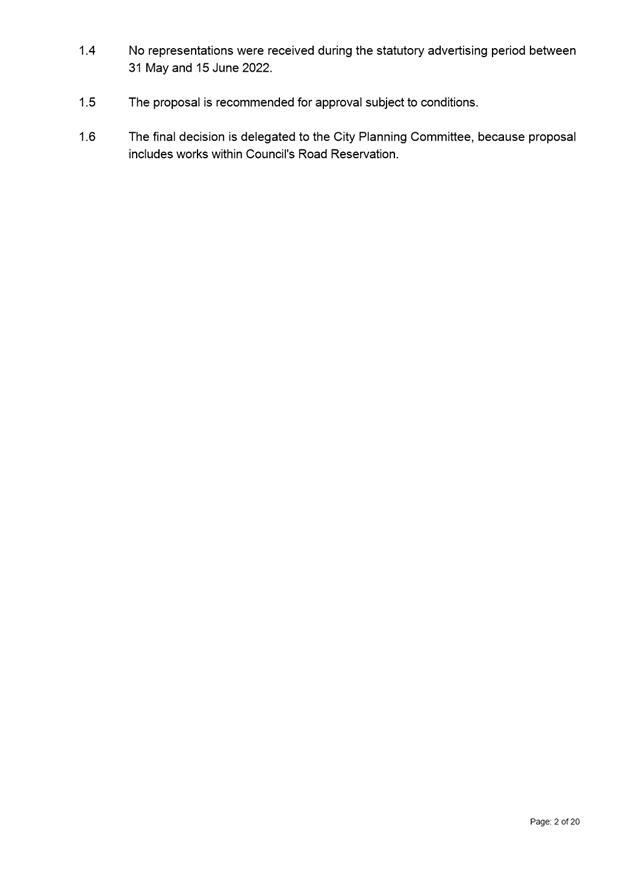
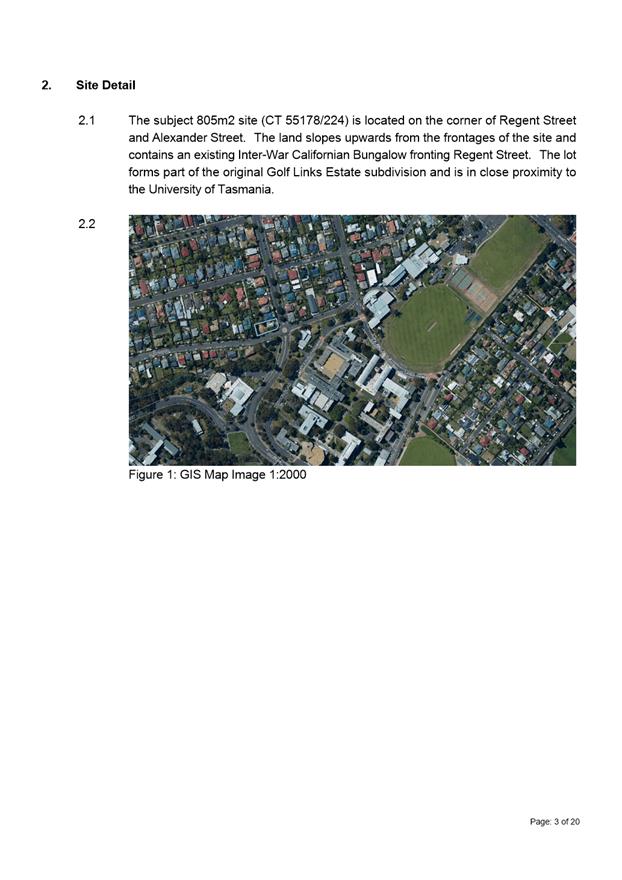
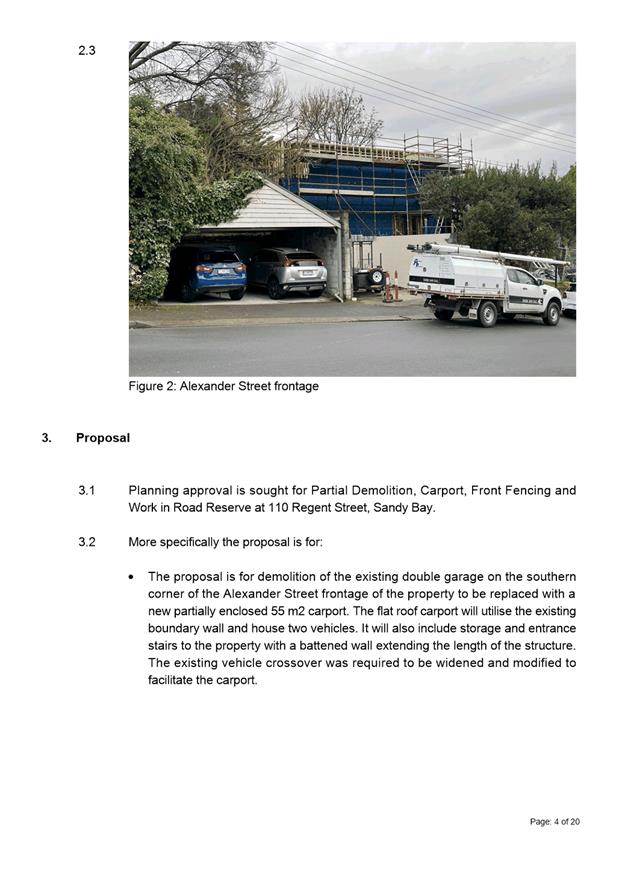
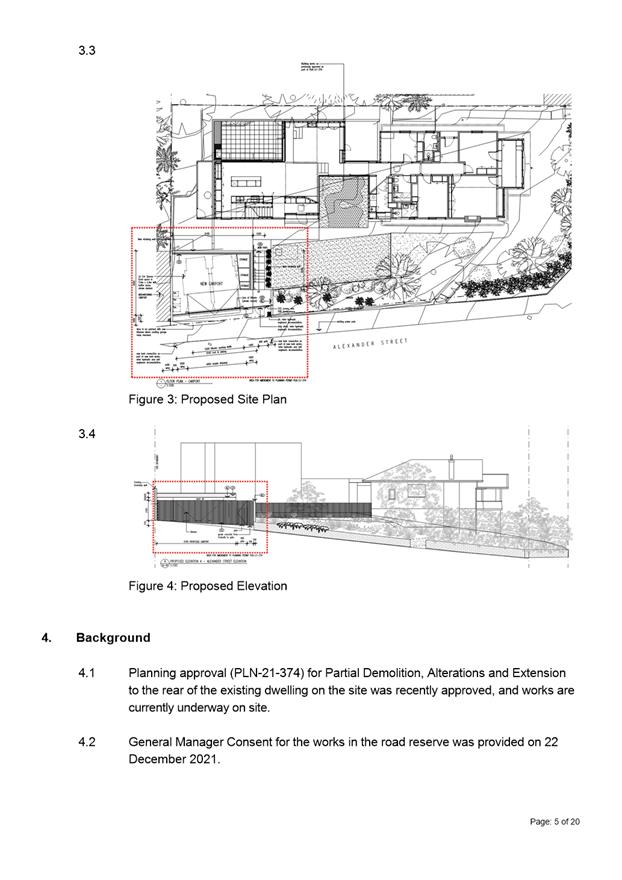
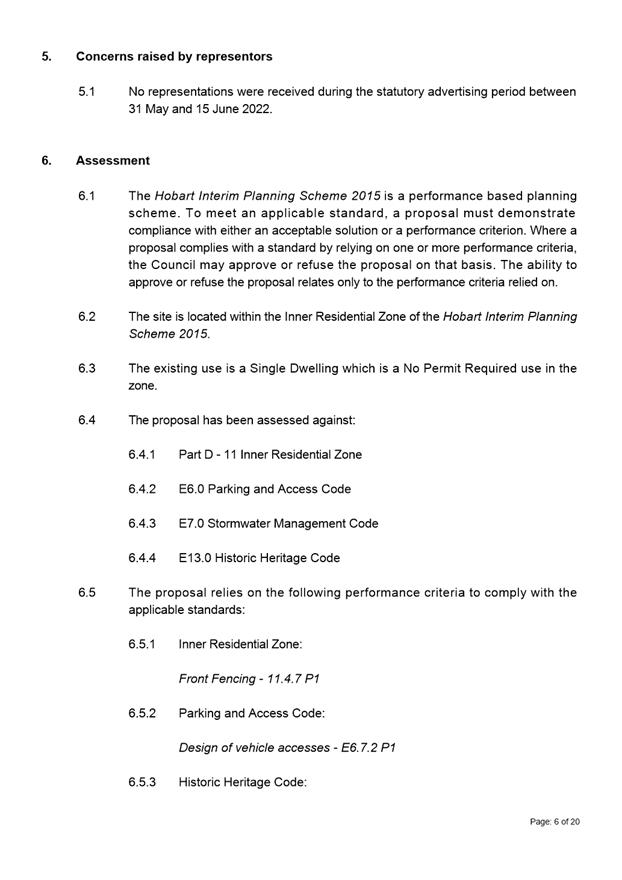
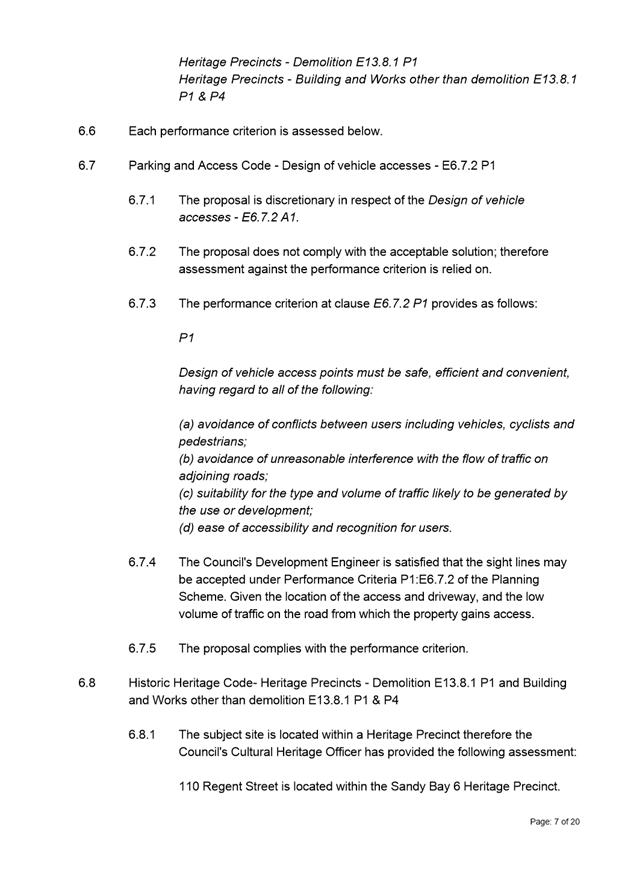
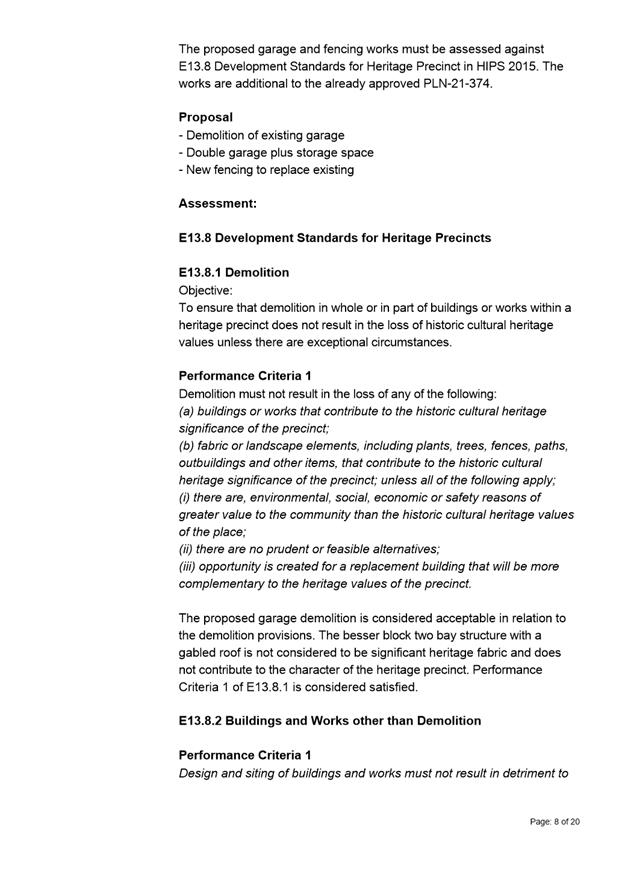
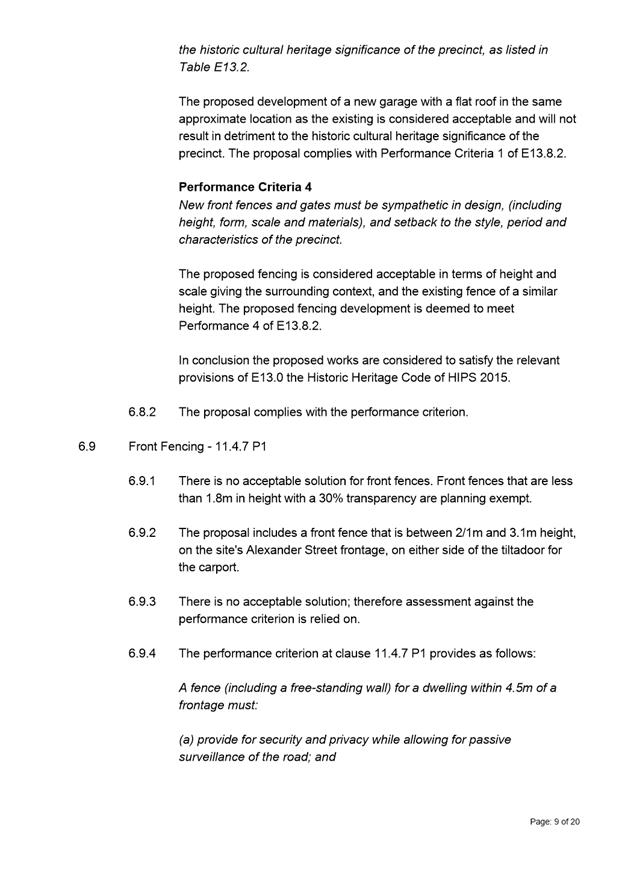
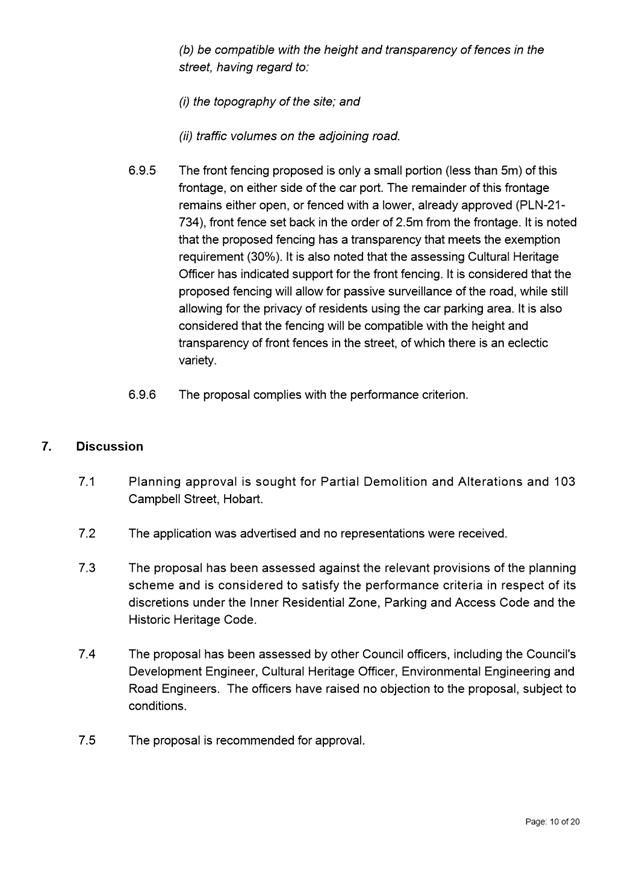
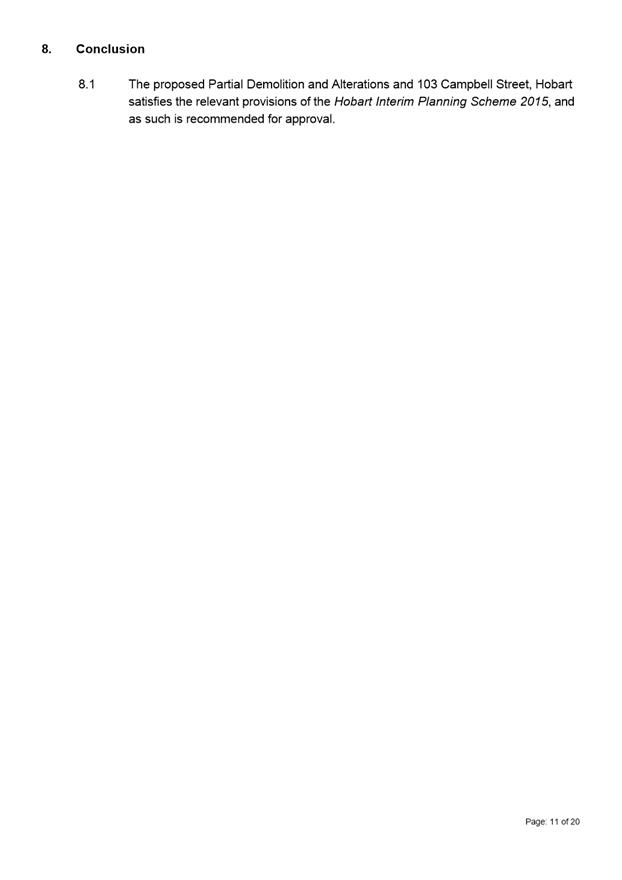
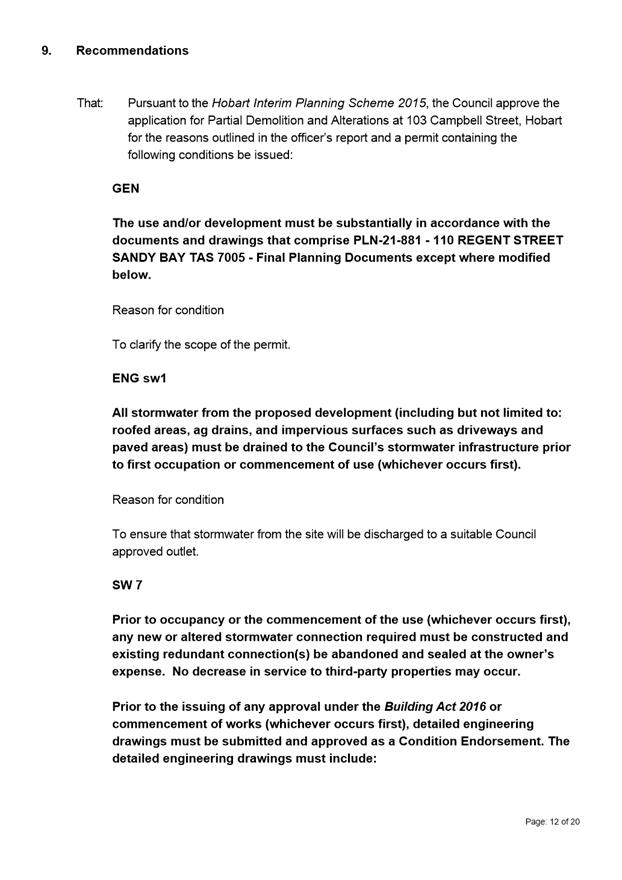
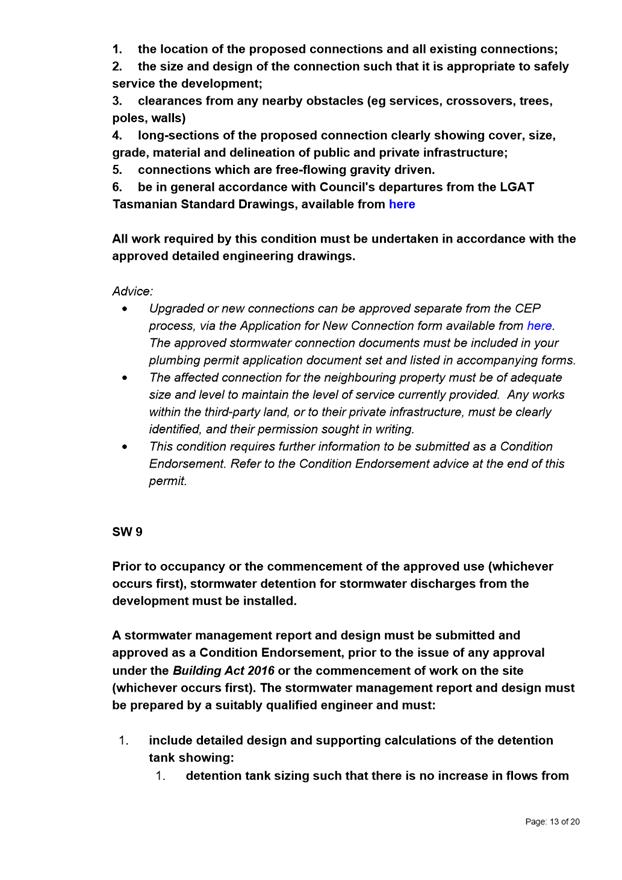
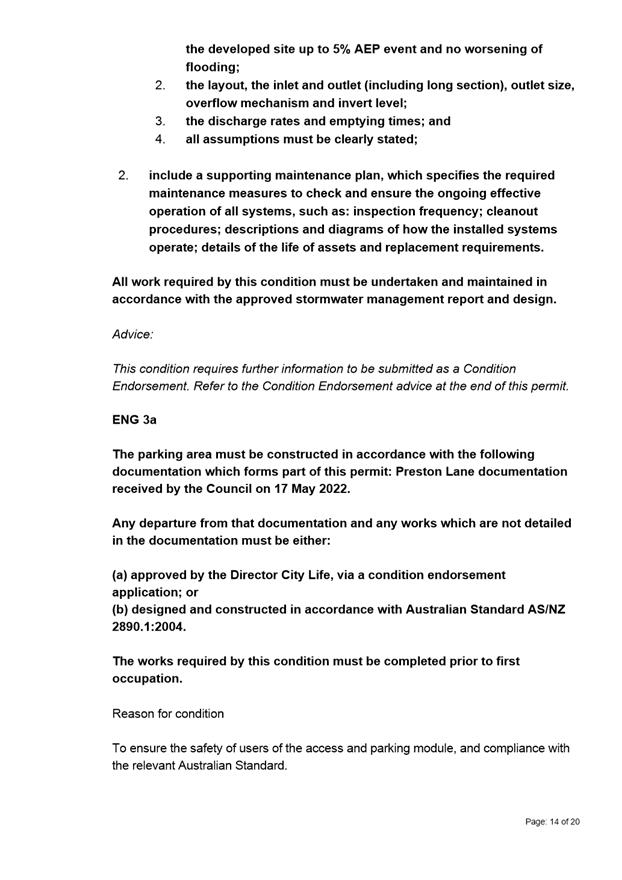
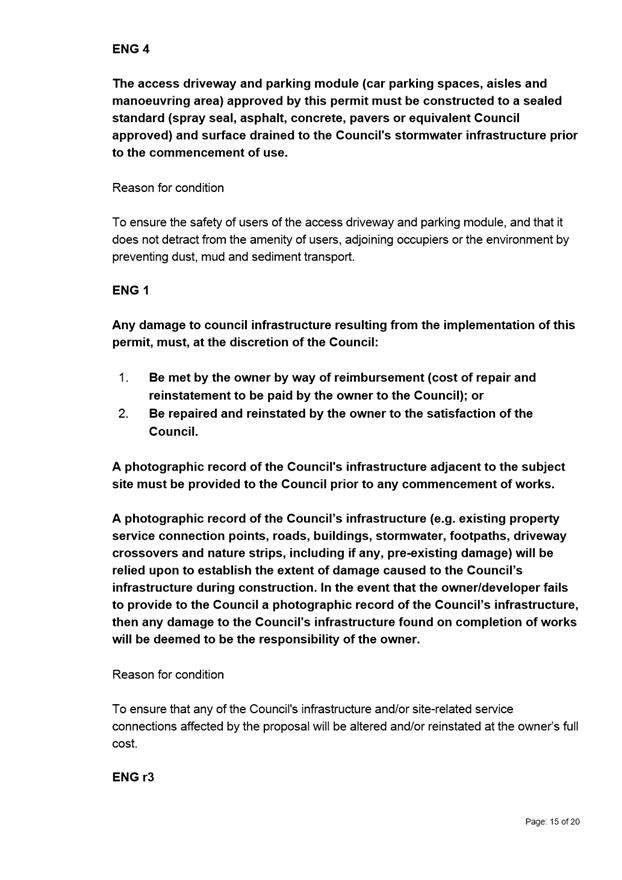
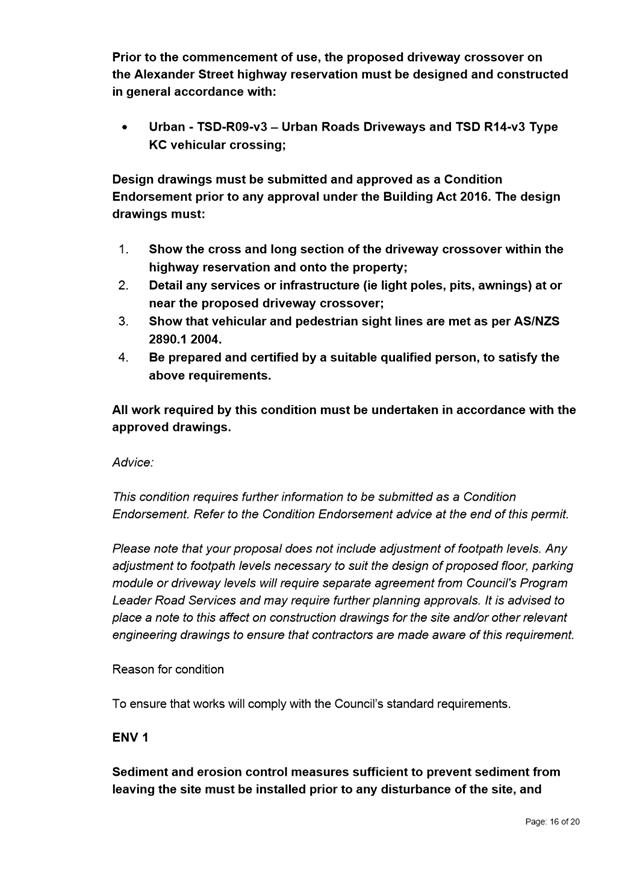
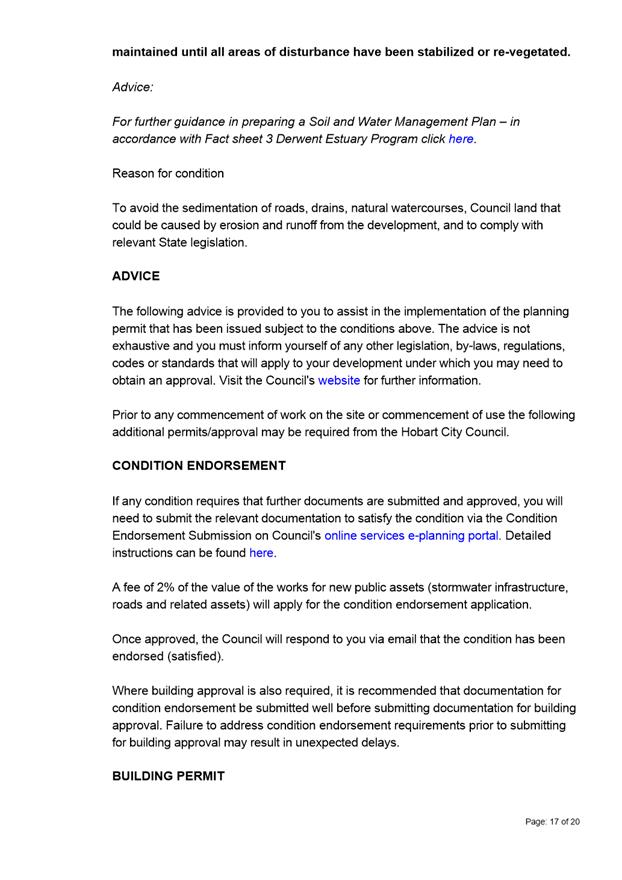
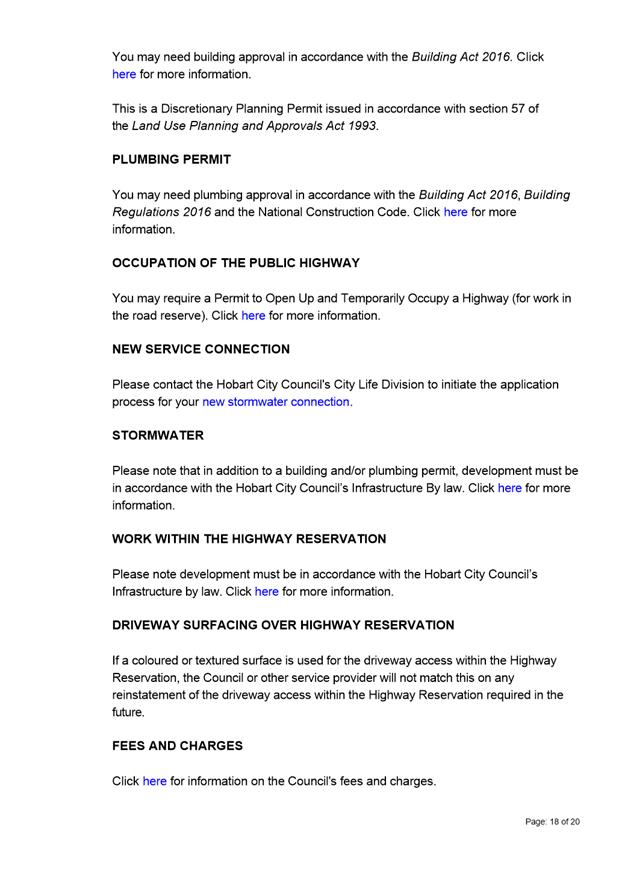

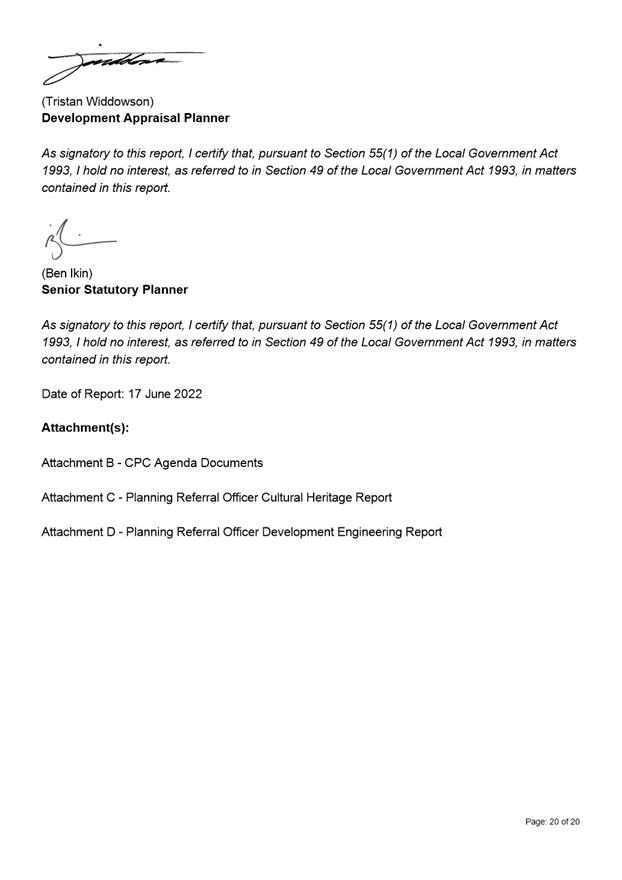
|
Agenda (Open Portion) City Planning Committee Meeting - 4/7/2022 |
Page 267 ATTACHMENT b |
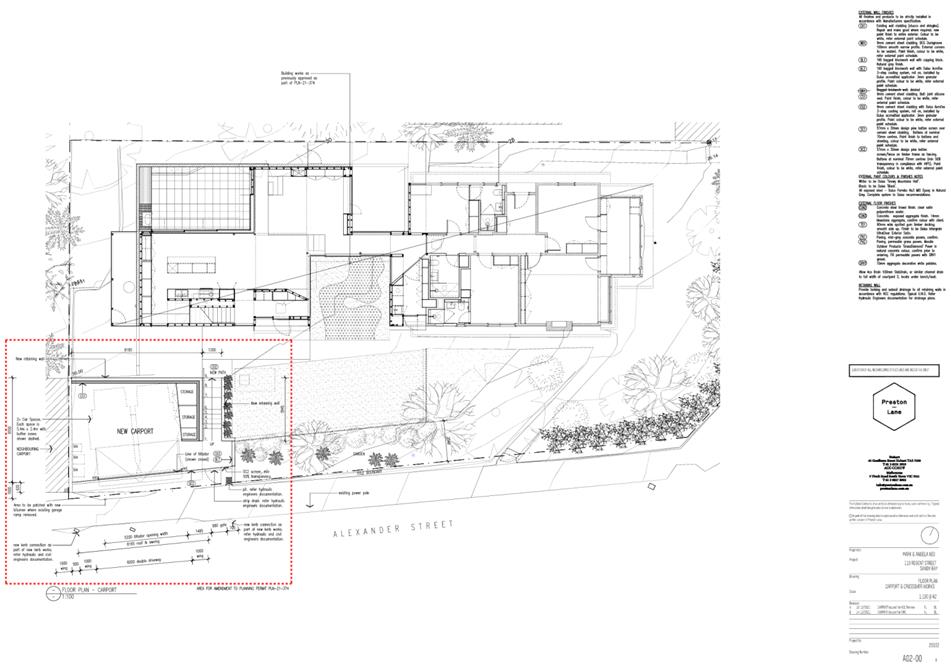
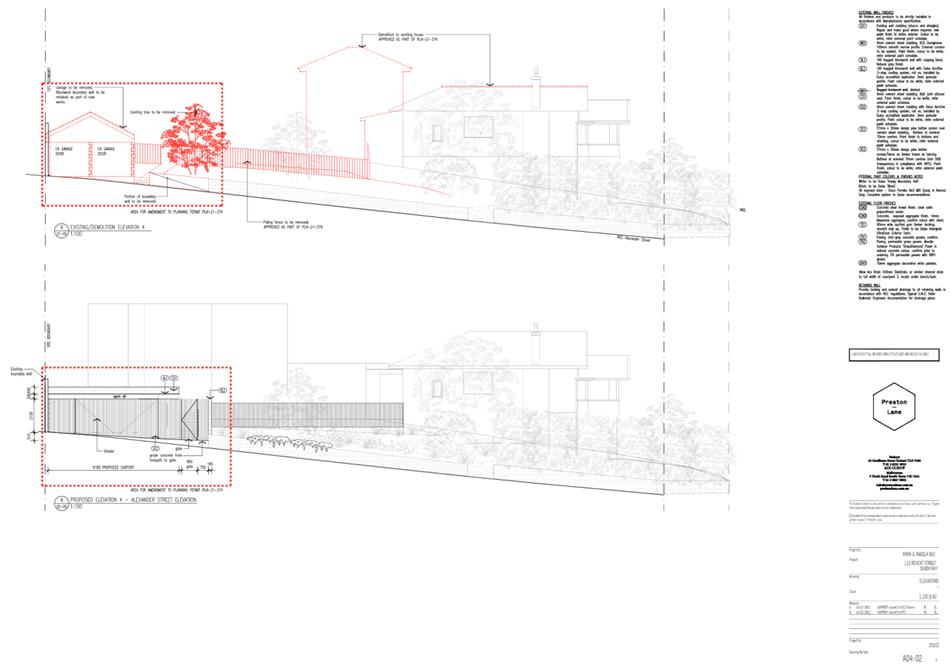
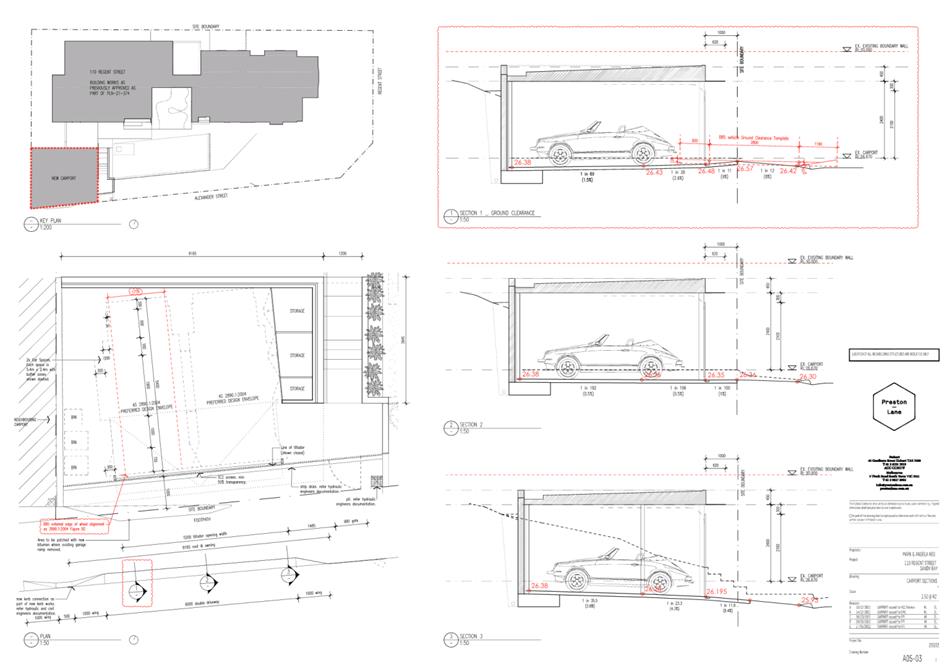
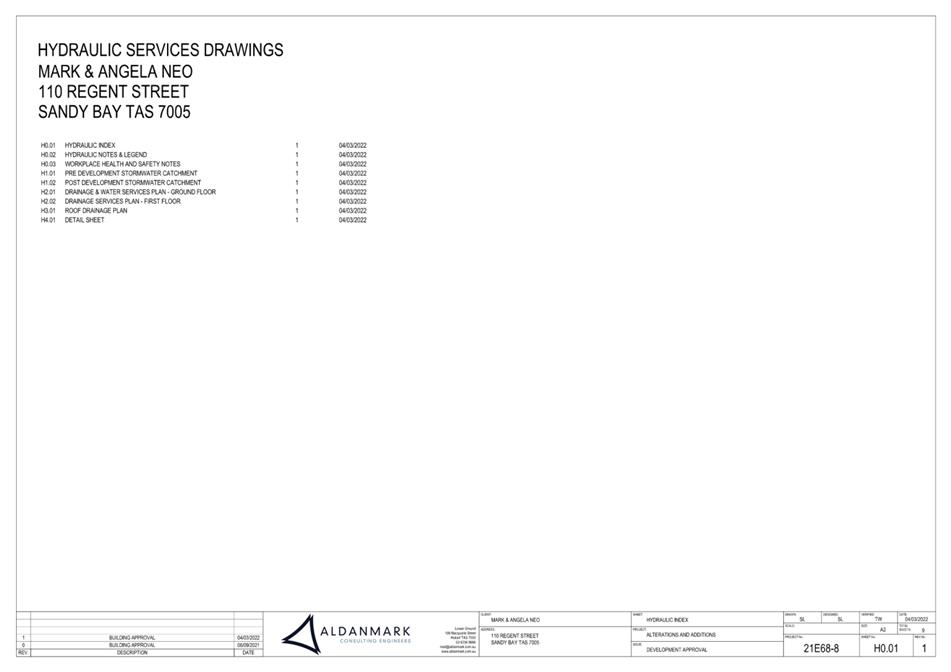
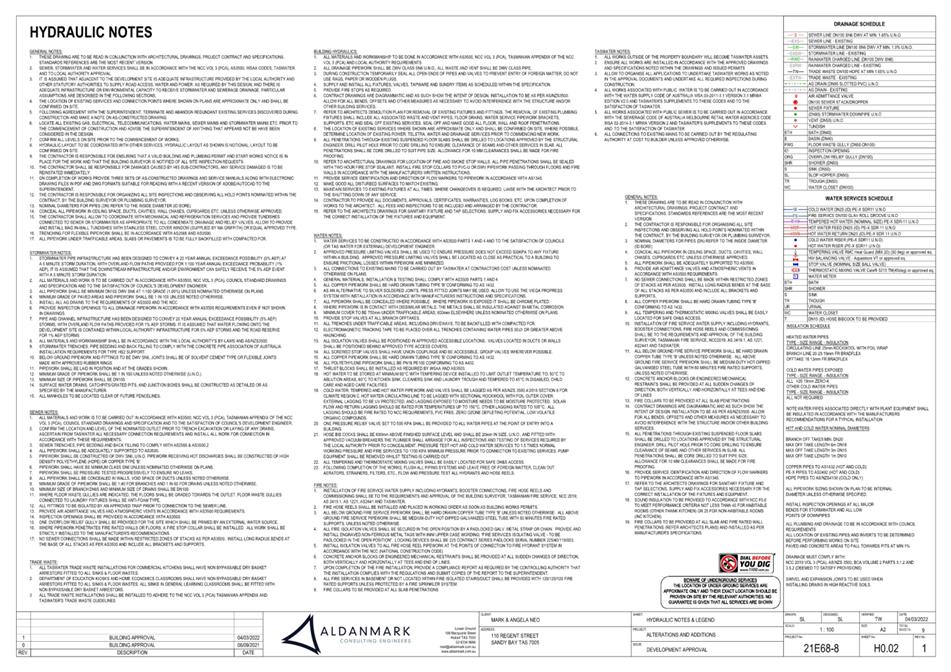
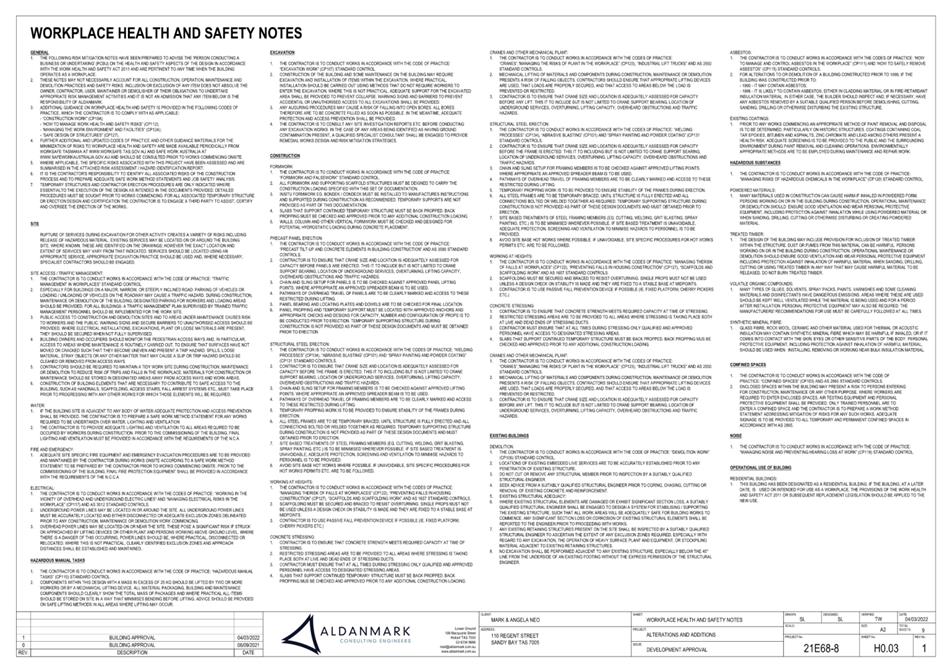
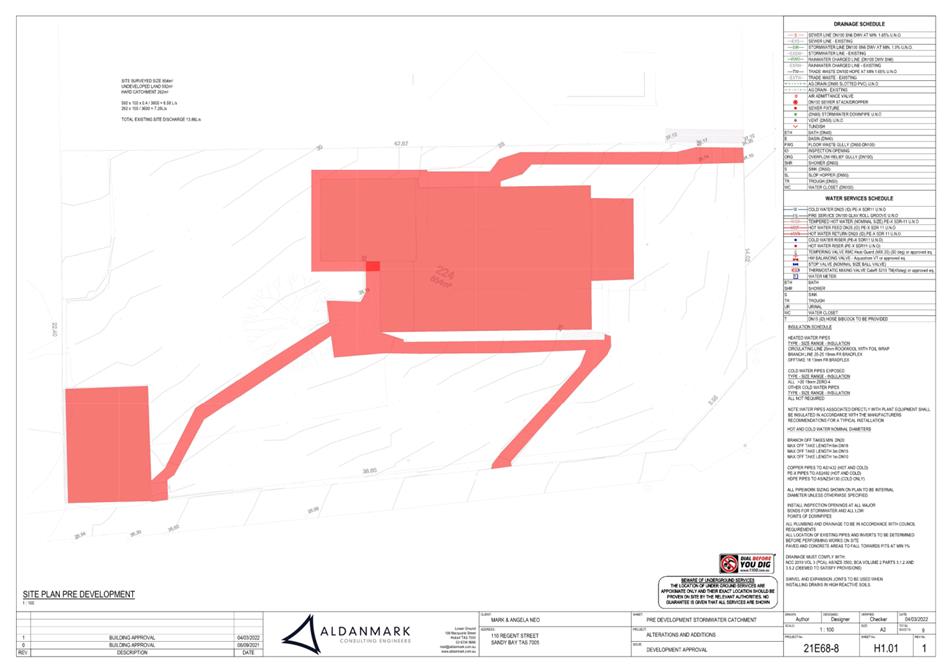
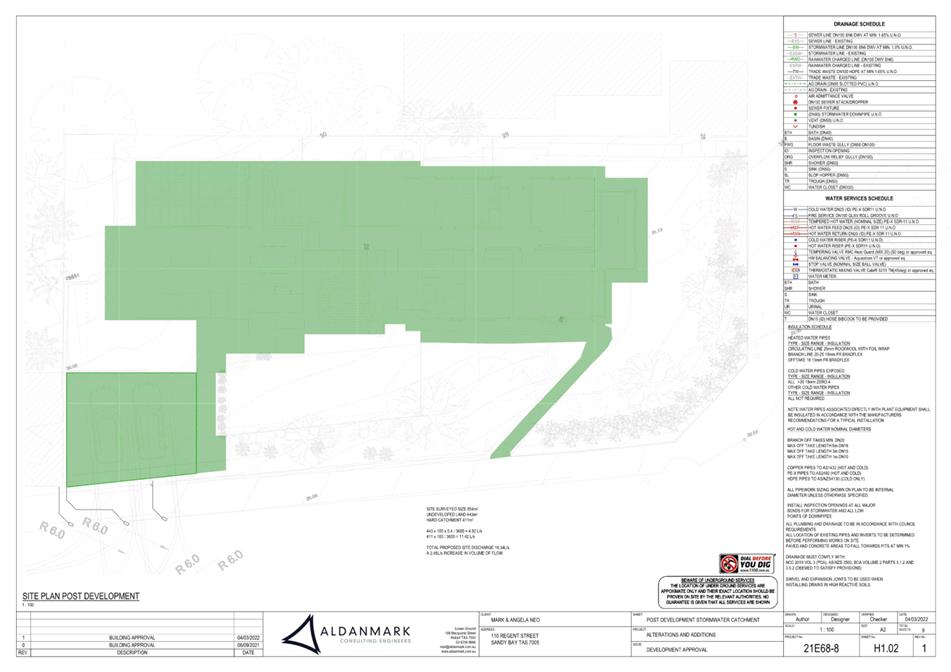
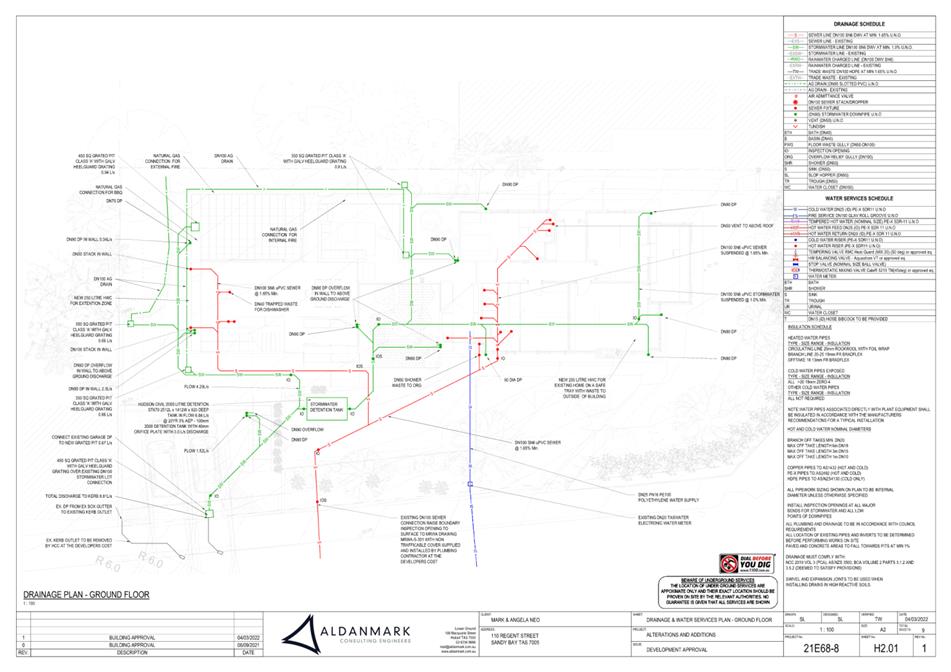
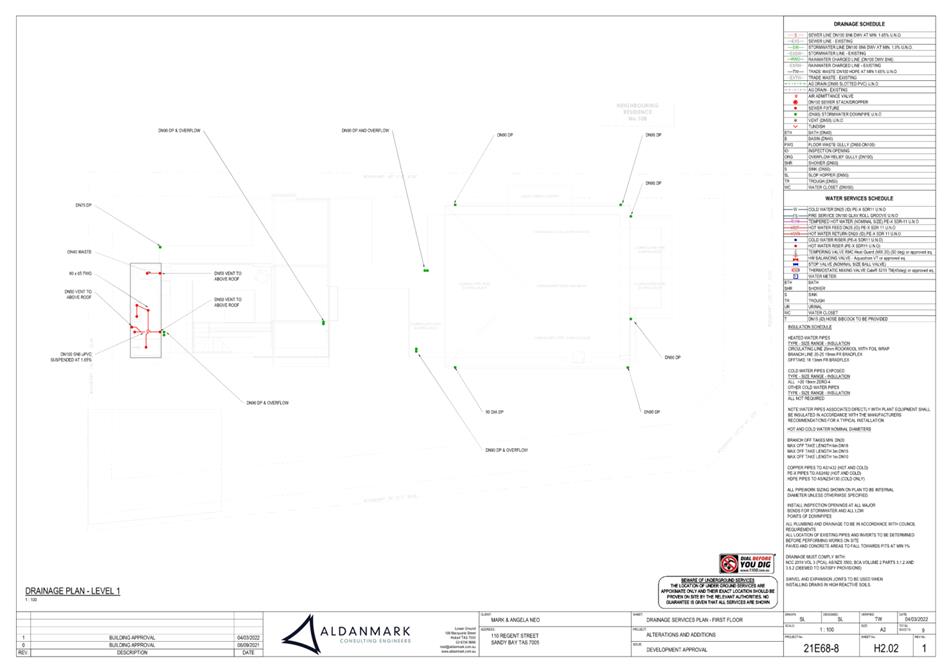
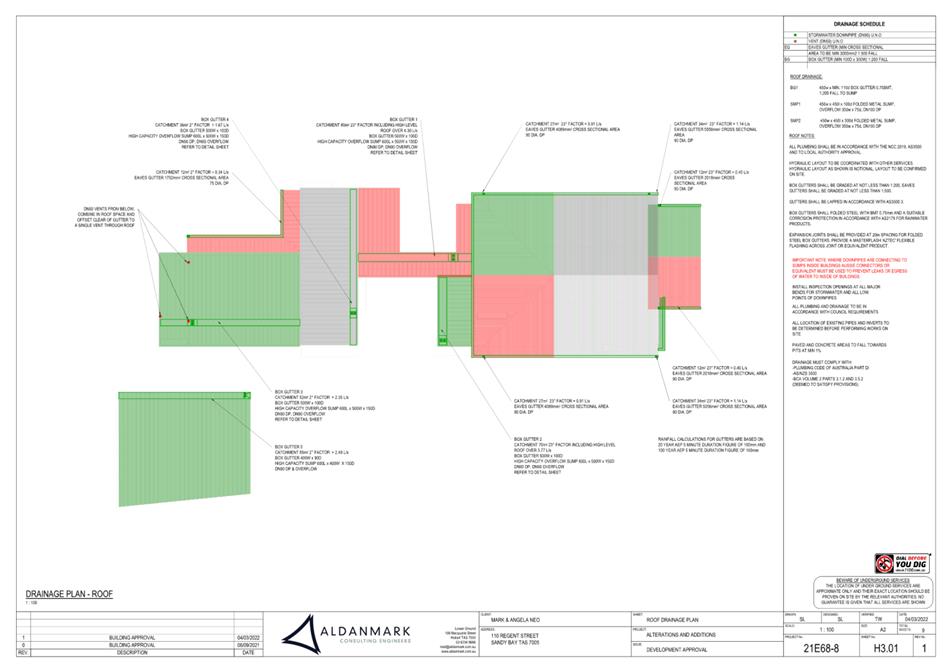
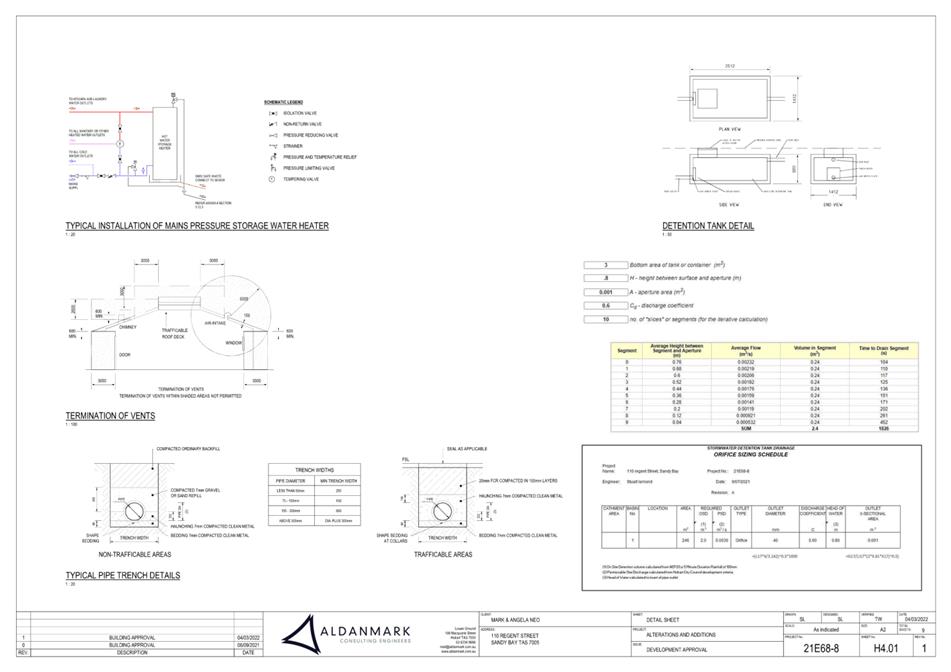
|
Agenda (Open Portion) City Planning Committee Meeting - 4/7/2022 |
Page 298 ATTACHMENT c |
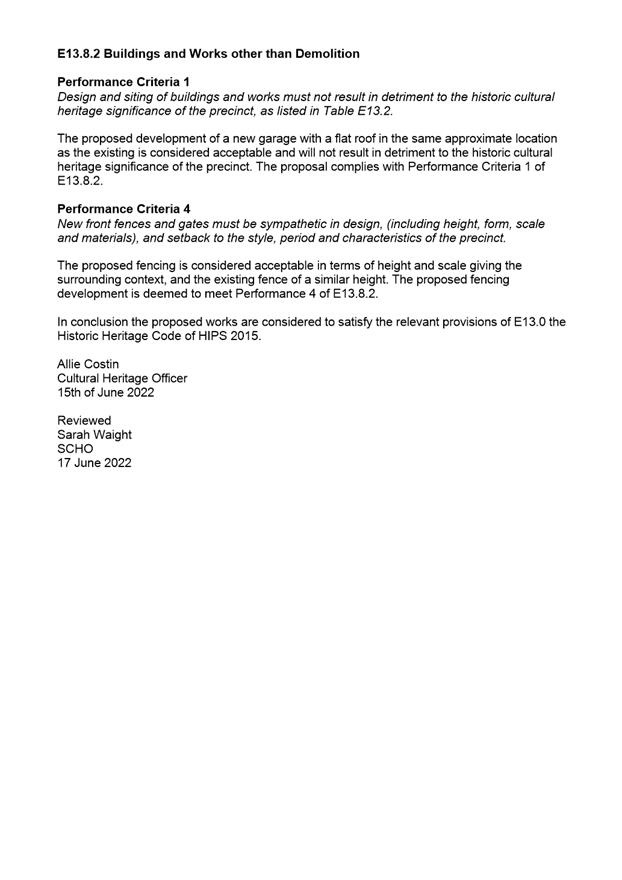
|
Agenda (Open Portion) City Planning Committee Meeting - 4/7/2022 |
Page 309 ATTACHMENT d |
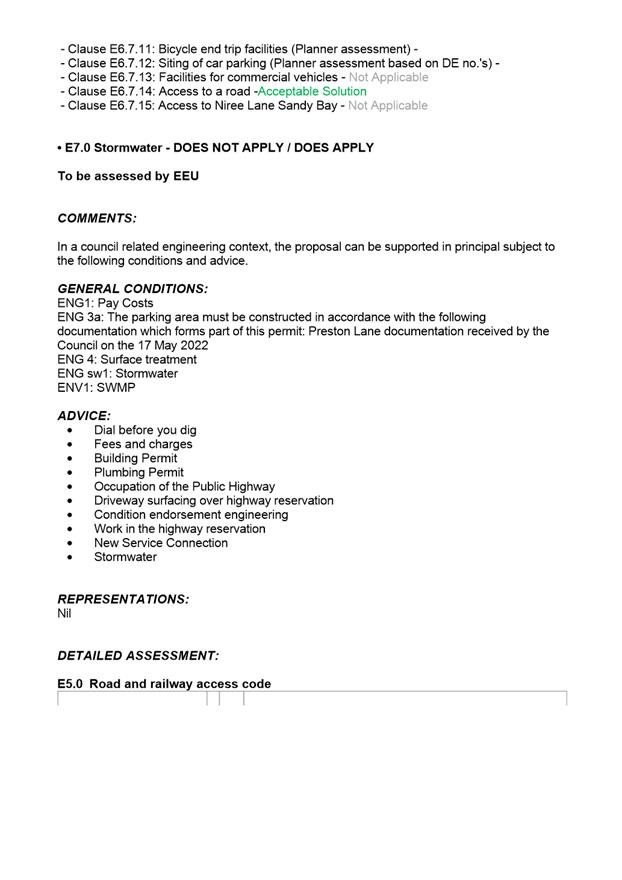
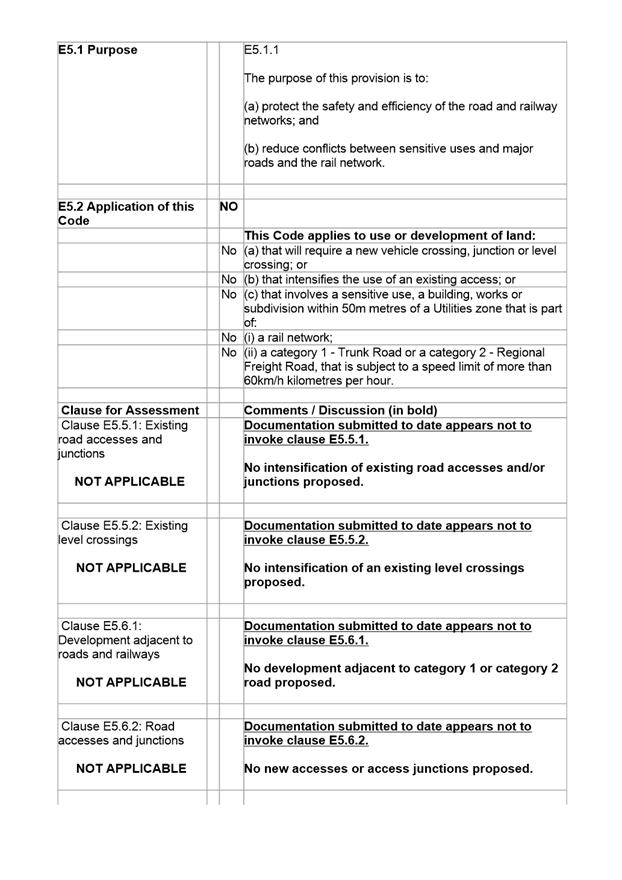
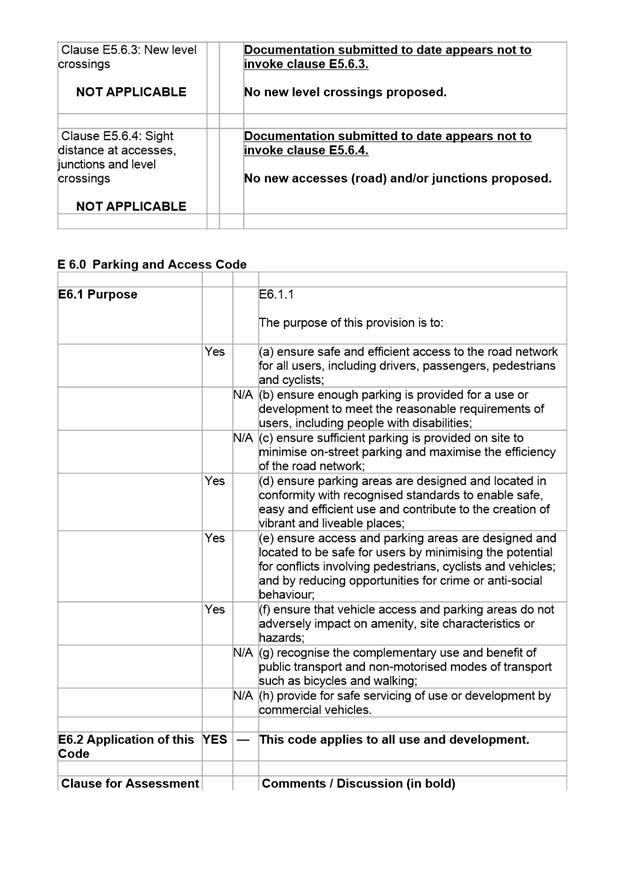
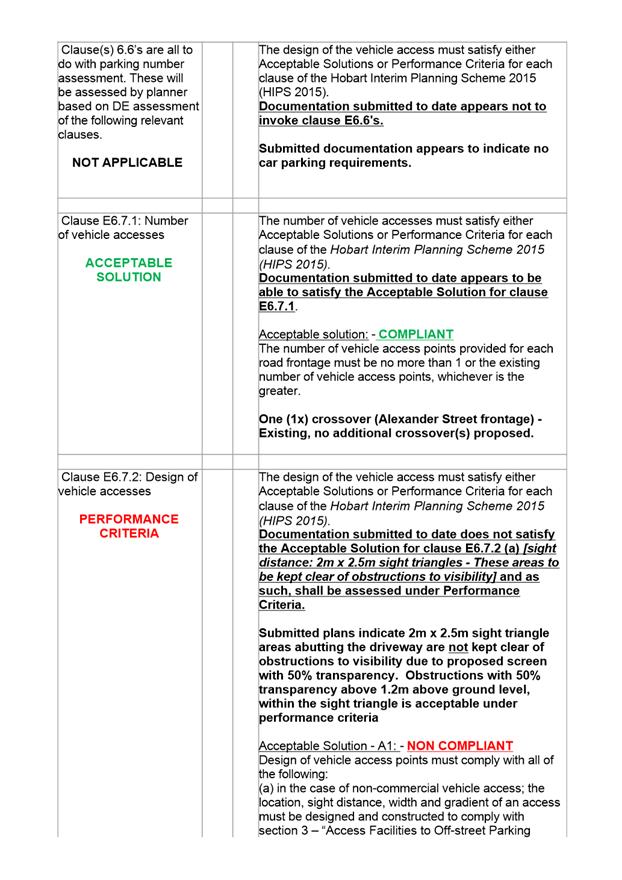
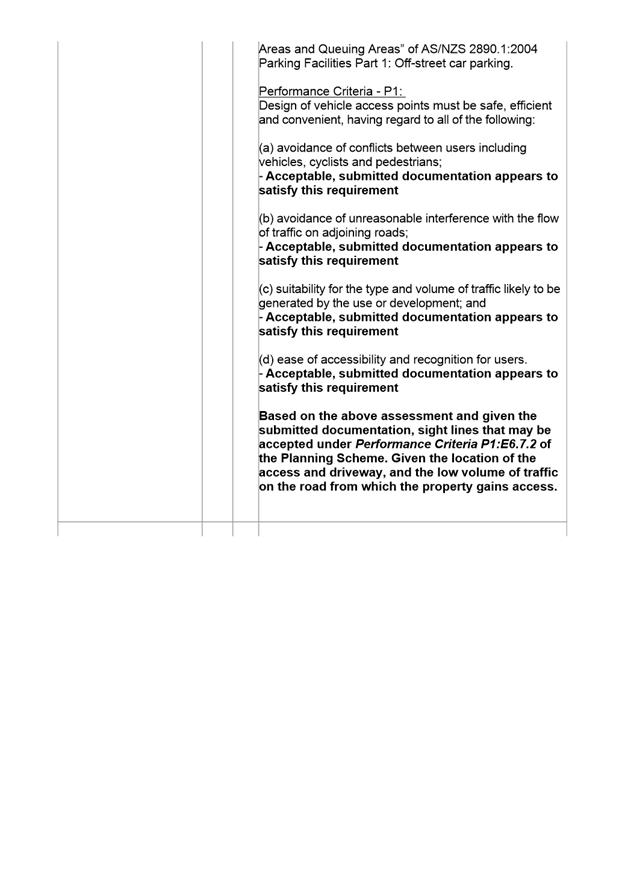
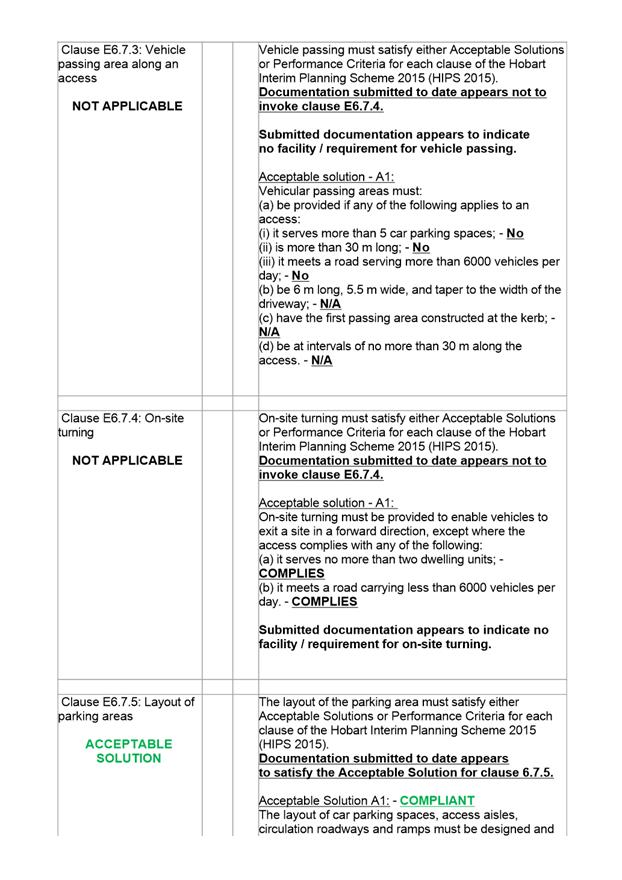
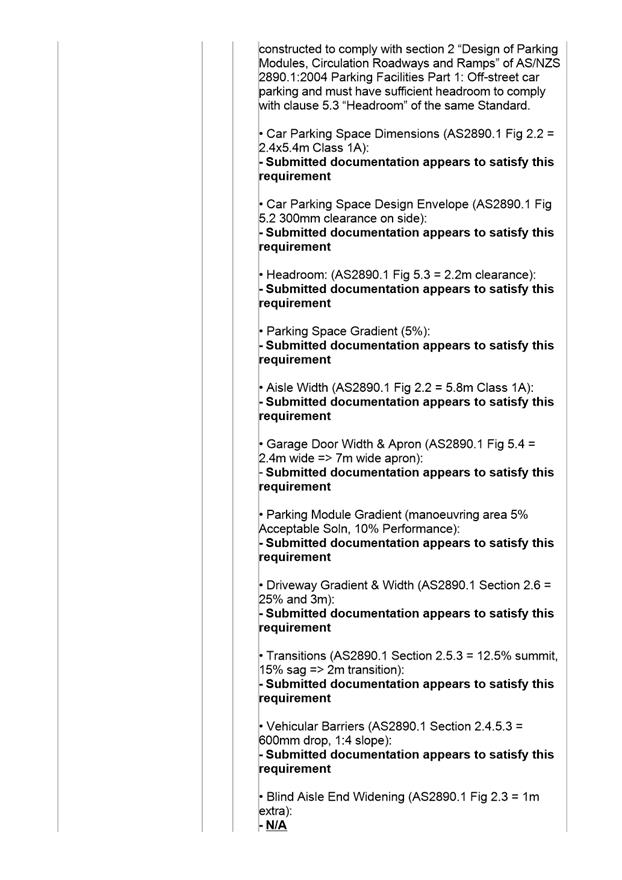
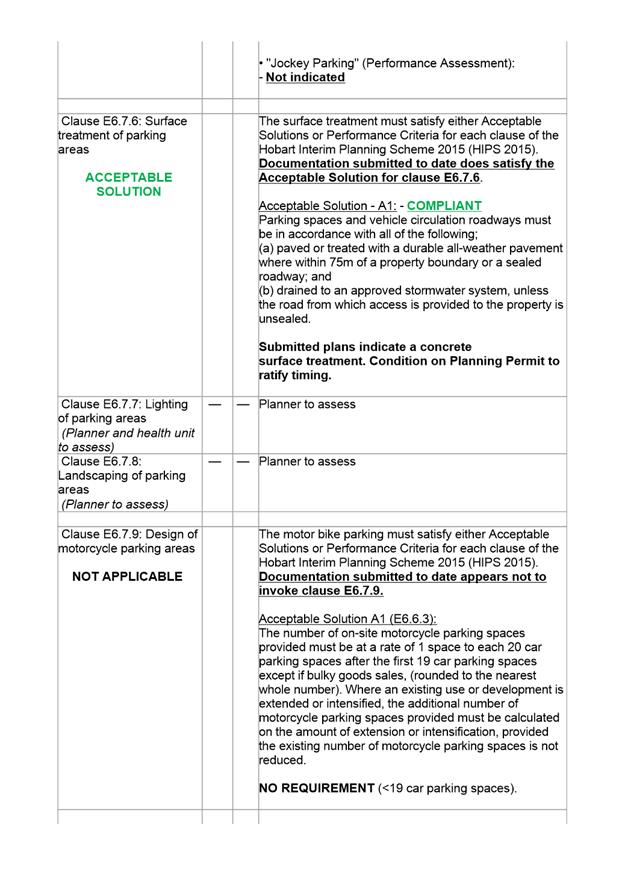

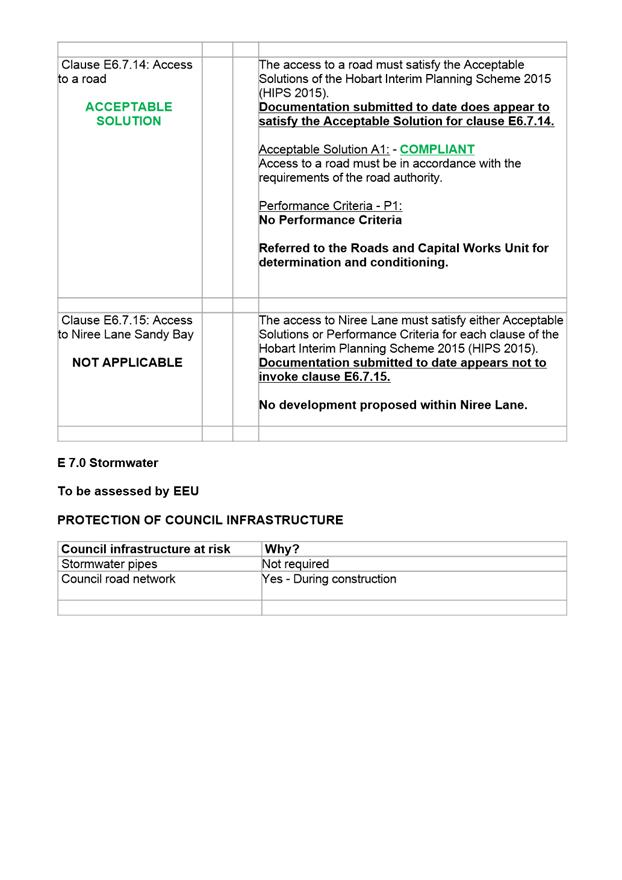
|
Agenda (Open Portion) City Planning Committee Meeting |
Page 310 |
|
|
|
4/7/2022 |
|
8. Reports
8.1 Submissions Received Public Notification Period for the Certified Amendment for Short Stay Visitor Accommodation
Report of the Strategic Planner City Futures, Manager City Futures and the Director City Life of 27 June 2022 and attachments.
Delegation: Council
|
Item No. 8.1 |
Agenda (Open Portion) City Planning Committee Meeting |
Page 345 |
|
|
4/7/2022 |
|
REPORT TITLE: Submissions Received Public Notification Period for the Certified Amendment for Short Stay Visitor Accommodation
REPORT PROVIDED BY: Strategic Planner City Futures
Manager City Futures
Director City Life
1. Report Purpose and Community Benefit
1.1. This report has been prepared to inform Council about the representations received during the public notification period for the certified amendment to the Hobart Interim Planning Scheme 2015 to add a specific qualification for Visitor Accommodation in the Use Table in each of the General Residential Zone, the Inner Residential Zone and the Low Density Residential Zone to restrict Visitor Accommodation use if the use is wholly within a single dwelling or dwelling (excluding for ‘ancillary dwellings’).
1.2. The report had been prepared in accordance with section 39 of the former provisions of the Land Use Planning and Approvals Act 1993 (LUPAA).
1.3. The report provides a community benefit by providing a summary analysis of the key themes in the representations and includes all the representations in Attachment A.
2. Report Summary
2.1. At its meeting on 28 March 2022, Council resolved to initiate the planning scheme amendment PSA-22-1 to the Hobart Interim Planning Scheme 2015 to the Use Table in each of the General Residential Zone, the Inner Residential Zone, and the Low Density Residential Zone for inclusion in the Hobart Interim Planning Scheme 2015, to restrict Visitor Accommodation use if the use is wholly within a single dwelling or dwelling (excluding for ‘ancillary dwellings’).
2.2. The certified amendment was placed on public exhibition from 2 April 2022 to 6 May 2022 (inclusive). In accordance with section 38 of the former provisions of LUPAA, extra days were included to allow for days on which the office of the planning authority was closed during normal business hours.
2.3. The representations received during the public exhibition period are provided in Attachment A.
2.4. Of the representations:
2.4.1. 119 statutory representations were received during the public exhibition period with one submission later withdrawn resulting in a total of 118 submissions.
2.4.2. 48 statutory representations were made in support of the certified amendment.
2.4.3. 70 statutory representations were made that are opposing the certified amendment.
2.4.4. One representation from TasWater stated ‘we have no formal comments for the Tasmanian Planning Commission in relation to this matter and we do not require to be notified of nor attend any subsequent hearings’.
2.4.5. Four non-statutory representations were received.
The most commonly raised representations in support of the certified amendment were the need for change due to; the housing, rental and homelessness crisis in Hobart and Tasmania,the amount of short stay visitor accommodation in Hobart and the impact on available housing and the cost of rental accommodation, the adverse impact on neighbours and local residents/community (and potential for a benefit to local economy from increase in number of local residents), that the original purpose of Airbnb was home sharing - not whole house sharing, that short stay visitor accommodation should be subject to a higher rates charge than a standard residential property, and that other cities place restrictions on short stay visitor accommodation.2.4.7. The most commonly raised representations opposing the certified amendment were;
2.4.7.1. opposition to a ban on Airbnb,
2.4.7.2. there would be a negative impact on tourism and the economy,
2.4.7.3. it is a restriction on property owner rights,
2.4.7.4. regulation of short stay visitor accommodation is not a matter for the City of Hobart,
2.4.7.5. families and groups use Airbnb properties to stay together, do their own cooking, etc. and this is not available in hotels,
2.4.7.6. hotels are not affordable and short stay visitor accommodation is more affordable,
2.4.7.7. owners would not put their property on the long term rental market,
2.4.7.8. the provision of affordable housing and social housing is not the responsibility of private property owners,
2.4.7.9. people use their property when they visit Tasmania for holiday/visit Hobart for work or to care for relatives,
2.4.7.10. negative impact on owners income, and
2.4.7.11. the government should do more to encourage the development of housing.
|
That: 1. Pursuant to section 39 (2) of the former provisions of the Land Use Planning and Approvals Act (LUPAA) 1993, that Council endorse this report as the formal statement of its opinion as to the merit of the representations received during the public exhibition of the certified amendment PSA-22-1. 2. Pursuant to section 39 (2) of the former provisions of the Land Use Planning and Approvals Act (LUPAA) 1993, that Council recommend to the Tasmanian Planning Commission that PSA-22-1 to the Hobart Interim Planning Scheme be approved as certified. |
4. Background
4.1. At its meeting on 28 March 2022, Council resolved that:
1. Council endorse the draft amendment to the Use Table in each of the General Residential Zone, the Inner Residential Zone, and the Low Density Residential Zone for inclusion in the Hobart Interim Planning Scheme 2015 to restrict entire home Visitor Accommodation use (excluding for ‘ancillary dwellings’) in specified zones of the Hobart Interim Planning Scheme 2015 as detailed in Attachment A to item 7.1.4 of the Open City Planning Committee agenda of 21 March 2022.
2. Under section 35 of the former provisions of the Land Use Planning and Approvals Act 1993, Council certify that amendment PSA-22-1 to the Hobart Interim Planning Scheme 2015 meets the requirements of section 32 of the former provisions of the Land Use Planning and Approvals Act 1993 and authorise the Chief Executive Officer and Lord Mayor to sign the Instrument of Certification marked as Attachment A to item 7.1.3 of the Open City Planning Committee agenda of 21 March 2022.
3. Under section 38 of the former provisions of the Land Use Planning and Approvals Act 1993, the Council place the amendment to the Hobart Interim Planning Scheme 2015 on public exhibition for a 28 day period.
4.2. At its meeting on 23 August 2021, Council resolved as follows:
That:
1. Council pursue inserting one or more specific area plans into the Hobart Local Provisions Schedule that prohibit entire home short stay accommodation use (excluding for ‘secondary residences’).
2. Council advocate to the Minister for Planning to issue a planning directive that immediately prohibits new permits for entire home short stay accommodation within the Hobart Local Government Area;
3. Council advocate for statewide regulations, similar to those in New South Wales, that enable councils to make decisions about properties within their local government area; and
4. Council advocate to the Tasmanian Government to form a ‘Housing Supply Forecasting Council’ in line with Recommendation 5 of the report Regulating Short-Stay Accommodation in Tasmania: Issues to consider and options for reform.
4.3. At its meeting on 9 February 2021, the Council resolved inter alia that:
(a) A report be prepared on the possible amendments, their merits and potential consequences, to the planning regulations to implement the following recommendations made in the UTAS Report titled: Regulating Short-Stay Accommodation in Tasmania: Issues to consider and options for reform:
Recommendation 3: That the Tasmanian Government amend the current planning scheme to allow consideration of housing market conditions when making planning decisions.
Recommendation 4: That the current planning scheme include provisions so that it can respond to community-level housing needs in a timely manner.
(b) Advice be prepared as to the merits and potential consequences of endorsing Recommendation 5 of the same report
Recommendation 5: That the Tasmanian Government establish a Housing Supply Forecasting Council to collect and analyse housing supply and demand drivers, including the impact of the short stay visitor accommodation sector, and provide policy recommendations.
4.4. At its meeting on 17 December 2020, Council resolved inter alia that:
A report be prepared on the possible amendments, and their merits, to the planning regulations to more appropriately control the number of private properties being converted to whole home short stay accommodation.
5. Proposal and Implementation
5.1. This report has been prepared to summarise the representations received during the public exhibition period for the certified amendment.
5.2. Representations, received during the public notification period, in support of the certified amendment included letters from organisations, including National Shelter, Shelter Tasmania, the Salvation Army, TasCOSS, The Tenants’ Union of Tasmania, Catholic Care Tasmania, Ella Haddad MP and submissions from many residents of Hobart, including one person who stated that their ‘responses are generated from a prompt from the Airbnb group’.
5.3. A non-statutory representation in support of the certified amendment was received from Andrew Wilkie MP.
5.4. Key themes emerged in support of the certified amendment and included, reference to a housing and rental crisis, high rents forcing people into homelessness, detrimental impacts on neighbours and local communities, whereby local residents felt that there was a loss of community due to the lack of local residents. Several submissions stated that the proposals should be applied to all new properties and retrospectively to existing properties and that short stay Visitor accommodation should be subject to a higher rates charge than a standard residential property.
5.5. Representations that opposed the certified amendment included a letter from Airbnb and representations from owners of Airbnb properties.
5.6. Key themes in opposition to the certified amendment included, reference to a ban on Airbnb, negative impact on tourism and the economy, restriction on property owner rights, negative impact on owners income, families and groups use Airbnb properties to stay together, hotels are not affordable, affordable housing and social housing is not the responsibility of private property owners, people use their property when they visit Tasmania for holiday/visit Hobart for work or to care for relatives, and the government should do more to encourage the development of housing.
5.7. Table 1 provides a summary of the matters raised in the representations. It includes extracts from some but not all representations with regard to the summary matter; these extracts are intended to evidence the summarised matter and are extracted as written.
5.8. Table 1 is not an exhaustive account of every single representation, the full detail of the representations, as they were submitted, is available in Attachment A.
Table 1
|
Summary of Matter Raised (Bold) |
Representor Comment(s) (Italics) |
Response |
|
Representations in support of the proposal |
||
|
Reference to a housing, rental and homelessness crisis in Hobart and Tasmania, was a theme in the majority of representations in support of the certified amendment. This theme was common to submissions from organisations including Shelter, the Salvation Army, TasCOSS, Tenants' Union of Tasmania and the Youth Network of Tasmania, and many individual residents of Hobart. Comments included: ‘As the cost of housing outstrips people’s incomes, more and more households are left in rental stress and facing the risk of homelessness. This problem is amplified in Tasmania because the private rental market is shrinking.’ ‘There is no doubt that the 10% loss of residential rental homes to the short-stay sector has deepened housing stress and homelessness in our community.’ ‘As you know, the Hobart local government area and Tasmania more generally, is experiencing a housing crisis with housing being neither affordable nor available’ ‘There are too many people without basic homes, to be allowing for any more short stay accommodation to be allowed in Tasmania.’ ‘Housing is a human right, but rents are rising so thousands of Tasmanians are experiencing housing financial stress, forcing them to choose between a roof over their heads and paying for other essentials such as food and healthcare as well as leading to tenuous tenancies.’ ‘The Anglicare Rental affordability snapshot for 2022, found that on one weekend in March, NOT A SINGLE rental property in the Hobart LGA was deemed affordable for a person on a pension.’ ‘attempting to negotiate and enter the rental market is daunting as many young people are priced out of the market. Median rental prices in our major cities exceed youth allowance by $140 per week and Job Seeker by $85 per week.’ ‘This year, Hobart has recorded a rental vacancy rate three times worse than the national average and rent increases more than double the national average.’ ‘In Hobart's current rental crisis, it is vital to prioritise the use of properties for long term rental homes for local people.’ ‘My main areas of concern are the displacement of renters in a time of severe housing undersupply, the effect on house prices and rentals,..’ ‘Even households on average incomes, including key workers such as nurses, teachers and officers in police and emergency services, are paying over 30%, and up to 80% of their income in rent.’ |
It is evident that there is a shortage of rental housing in Hobart with vacancy rates in the private rental market (the vacancy rate is the number of vacant properties as a proportion of the overall number of properties in the rental market) consistently below 0.5%; in April 2022, the vacancy rate in the private rental market in Hobart was 0.4%[1], which highlights how few properties are available in the private rental market. The number of properties being used for short stay visitor accommodation does remove housing stock from the market that might otherwise be available to long term tenants.[2] In May 2022, the median weekly rental rate for Hobart (all dwellings) was $532 per week and over the previous 12 months, the change in the rent level in Hobart was an increase of 8.7%[3]. With real average wage growth falling due to a combination of low wage growth (in March quarter 2022 the seasonally adjusted wage price index was 2.4% over the year[4]) and inflation (in the 12 month to March 2022 at 5.1%)[5]. In addition, Tasmania has the lowest level of average weekly ordinary time earnings in Australia[6]. All these factors contribute to the housing and rental crisis and the flow on effects from this, including an increase in the number of people at risk of homelessness. |
|
|
Many representations referred to the amount of short stay visitor accommodation in the city and the impact of this land use on the long term rental market. Representors made reference to studies and presentations that identify a direct link between a reduction of properties on the short stay visitor accommodation market and the availability and cost of rental properties. Comments included: ‘Dr Peter Phibbs suggests a direct relationship between a reduction of short stay accommodation and a decrease in rent, presumably because the short stay properties were added to the longer term rental market, adding to supply and thereby putting downward pressure on prices.6’ This echoes research by the Reserve Bank of Australia that the dominant influence on real rents is the vacancy rate.7’ ‘I have read plenty of articles by housing experts that clearly prove that short stay accommodation has had a detrimental effect on availability of long term rentals.’ ‘Our previous research has provided evidence that the growth of SSA has benefited travellers, property owners, and investors in Tasmania, but has also accentuated Tasmania’s significant housing access and affordability challenges. ‘The density of short stay accommodation in Hobart is the highest of any capital city in Australia, and one of the highest in the world.’ ‘There is no doubt that the 10% loss of residential rental homes to the short-stay sector has deepened housing stress and homelessness in our community.’ ‘Skyrocketing rents and the lack of affordable rental properties is likely to have played a role in Hobartians being forced to move further away from their workplaces, extended families and friends and essential services located in the Hobart City Council municipality.’ ‘Hobart’s rental market remains one of the tightest in the country, with rents above pre-pandemic levels (De Vries et al., 2021) (Figure 1). Private rental costs are driven in part by the low vacancy rate, measured at 0.3% in March 2022 (SQM Research, 2022) (Figure 1). Housing analysts suggest that a vacancy rate of 3% is desirable and a vacancy rate below this indicates that demand for rental housing is unlikely to be met, leaving many prospective tenants unable to secure suitable accommodation (De Vries et al., 2021).’ ‘..rich investors grow ever richer by exploiting loopholes in our beautiful home City’s planning laws, and buy up ever more homes that come onto the market.’ ‘Housing affordability and private rental availability has significantly deteriorated in Tasmania, especially in the Greater Hobart Region, since 2015. SSA is one of the factors that has contributed to this outcome by effectively reducing housing supply by approximately 600 homes in the City of Hobart.’ ‘..increase of Short stay visitor accommodation (SSVA) is furthering the already diminishing long term rental market and contributing to the rising cost of housing..’ ‘Demand for social housing has increased, with over 4 000 households on the Housing Register since March 2021 (with 4 407 households registered as at February 2022.’ ‘I am a renter and have seen many friends struggle to even secure a home regardless of the price.’ ‘During the lockdown in March 2019 I watched an increase of 500 homes listed on Domain.com in the Hobart area within a week of the borders closing and again within a couple of weeks the average price dropped by nearly $100pw. This was directly related to the loss of the tourist industry and the demand, or lack of demand for short stay accommodation. The numbers don’t lie (and neither do I).’ |
As noted above, it is evident that there is a rental housing shortage in Hobart with vacancy rates in the private rental market at or below 0.5% in the last 12 months. In April 2022, the residential vacancy rate in Hobart was 0.4%[7] which highlights how few properties are available in the private rental market. Fewer residential properties being used for short stay Visitor Accommodation is likely to lead to an increase in the number of properties in the long term rental market, as evidenced by The Tasmanian Planning Commission finding that (slightly edited for ease of reading): While exempt Visitor Accommodation is unlikely to impact housing affordability and availability, Visitor Accommodation in a single ‘dwelling’ on a lot that comprises the likes of an investment property or commercial operation or business, where the owners are permanently absent; and Guests staying in a dwelling that is part of a strata scheme that contains permanent residents but where the owners of the property (or investment property or commercial operation or business) are permanently absent does remove housing stock from the market that might otherwise be available to long term tenants.[8] Furthermore, the UTAS report Regulating Short-Stay Accommodation in Tasmania: Issues to consider and options for reform [9] states: ‘Our conservative estimate (See Table 2 on page 6) is that between 2016 and 2018 SSA growth contributed to a loss of about 393 residential dwellings in the Hobart LGA and 667 dwellings in greater Hobart. This is about 5.6% of the Hobart LGA rental market. It suggests SSA use is having a significant impact on rental supply and housing affordability in Tasmania.’
|
|
|
Short stay Visitor Accommodation has affected not just the cost of rental properties but also made it very difficult for locals to afford to buy property. Comments included: ‘Whole houses being let as short stay accommodation also contributes to this problem, as the lure of high profits draws more mainland and overseas investors to buy houses in Hobart in order to let them out as accommodation. This further increases demand for properties for sale, and thus makes it even harder and more expensive for the few locals who can still afford to buy them.’ ‘their actions have also sent property prices in Hobart soaring to sky-high levels – effectively locking average Tasmanian wage earners out of the property market completely.’ |
There are many factors that contribute to the cost of housing with supply and demand being an important contributor. As noted above, the number of properties being used for short stay accommodation in Hobart has increased in recent years. The Hobart median house price in the last 12 months is $927,000 and the median unit price is $651,000[10].
|
|
|
That the original purpose of Airbnb was home sharing and that home sharing is different to owning a house to rent as short stay visitor accommodation. Comments included: ‘We consider the origin of Airbnb is of crucial importance in its impact on our city, in that it is about sharing your property and the local lore. It is NOT about renting out your shack in a coastal resort or buying up housing to make money short term letting to tourists at the expense of housing for locals. So, I agree with the Council’s plan to disallow whole house renting on Airbnb. They are NOT, as far as I understand it, stopping people from letting a unit or room in your house..’ ‘AirBnB was never meant to be used for whole properties – it is for people to share either part of their home or a granny flat with visitors.’ ‘I support the concept of the shared economy, and of homes being shared with visitors for short stays, but I do not support whole homes being made over to short term visitors over long periods of time.’ ‘I have absolutely nothing against people who rent out only part of their property on a short-stay platform.’ ‘The present Air BnB model does not represent the intention and spirit of the original design.’ |
It is important to note that people home sharing (i.e. sharing part of their home) in the Inner Residential Zone, the General Residential Zone and Low Density Residential Zones will not be affected by the proposed amendment. In addition, in these zones, the use of an ancillary dwelling for short stay Visitor Accommodation will still be possible.
|
|
|
Representors suggested that the certified amendment should not be limited to what is currently proposed and provided suggestions for additional measures. These suggestions included; that the certified amendment should be modified to be applicable to existing properties and ancillary dwellings, and that there be an amendment to the Sullivans Cove Planning Scheme to restrict short stay visitor accommodation. Comments included: ‘I believe that the regulations should apply to all properties, not just new builds,..’ ‘Regulation SHOULD apply to existing whole properties to reduce the housing crisis and to prevent inequities where one group of landlords is favoured over another.’ ‘Further I would ask the council to consider stopping short stay accommodation permits from being transferred when a house or apartment sells.’ ‘Given that the policy rationale for restricting future visitor accommodation is in part to "increase availability of dwellings for occupation by permanent residents" it is unclear why the draft amendments would exclude ancillary dwellings. Ancillary dwellings have a floor area not greater than 60m2 making them a desirable accommodation option, particularly for single persons and older people. By also excluding ancillary dwellings, the Hobart City Council would be increasing accommodation options for permanent residents.’ ‘This amendment should also be expanded to cover the Sullivans cove planning scheme, as this amendment is too important to not include all areas of residence throughout the HCC area.’ ‘I suggest it go further so that any entire home that is currently on the short-term accommodation list that is not rented for a certain period, say two, three or four weeks, be automatically dropped off the list.’ |
Tasmanian legislation does not allow for a retrospective, forced change of use and revoking of permits. It is not considered expedient to make any changes to the certified amendment. |
|
|
That the certified amendment will result in benefit to the local economy. Comments included: ‘restricting the practice of using housing stock as visitor accommodation would also support Hobart’s economy in terms of driving tourists towards hotels, restaurants, etc. as well as ensuring that the city’s suburbs retain their sense of community.’ ‘We need to consider and care for permanent Tasmanian residents who support our local economy all year round.’ ‘my local shops and businesses will benefit from having the steady custom of permanent residents.’ |
An increase in visitors using hotels, other Visitor Accommodation and restaurants is likely to result in these businesses generating additional income and requiring additional employees/supplies and thereby creating more local jobs, which in turn will result in more money in the year round local economy with spending benefitting local businesses.
|
|
|
The disruption to neighbours/local residents and the impact on the local community, as a result of short stay Visitor Accommodation in residential areas. Comments included: ‘It is difficult to understand why commercial activities with short-stay are allowed to be in almost any suburban residential location. The constant comings and goings of neighbours is not helping family environments.’ ‘General Residential Zone, Inner Residential Zone and Low Density Zones are where people live, they are not a holiday resort.’ ‘A corrosive impact on local communities (such as Glebe) by having short stays replace local residents and thereby ‘hollowing out’ neighbourhoods; ‘There is just this soul-less in-out of the booked ghosts in what is a residential area. This house could be lived in by people contributing to a sense of neighbourhood.’ ‘All people deserve to live in a street that feels safe, with continuity of residents surrounding them, and an opportunity for our local population to thrive, not just the passing trade of tourists. We need to consider and care for permanent Tasmanian residents who support our local economy all year round.’ ‘while people I know struggle to find a home to rent. When they leave for outlying areas they take their businesses, their kids leave local schools, they sometimes stop contributing to clubs or volunteer roles and they stop shopping here...the businesses they frequent die out because they can’t be sustained in between tourist seasons.’ ‘AirB&B erodes community. Where once there were neighbours, now there are passing strangers’ |
It is clear from the zone purpose statements that a significant level of commercial use is not an intended outcome in either the General Residential Zone, the Inner Residential Zone or the Low Density Residential Zone of the Hobart Interim Planning Scheme. A significant number of properties being used for short stay Visitor Accommodation in residential neighbourhoods will result in a decline in the number of local residents, which is likely to impact community cohesion, local businesses and demand for other services (e.g. schools). |
|
|
Representors suggested that higher rates/charges should apply to Airbnb properties than those rates/charges that apply to residential dwellings. Comments included: ‘Any investor who chooses to lock up their otherwise vacant property solely for profiting from high short-stay accommodation prices, should pay much higher rates and other charges for the privilege of doing so.’ ‘..other measures being applied to existing whole house short stay accommodation places, for example higher rates being applied to such properties, as they are operating as businesses.’ ‘Council could consider applying commercial rates to already-approved dwellings used entirely for this purpose.’ ‘I also approve of charging extra rates to these operators, since they are essentially running a commercial operation like a hotel. If hotels are charges commercial rates then so should these AirBnB operators.’ |
This is a matter for consideration under a different function of the City of Hobart. It is understood that a separate report will be brought to Council on this matter. |
|
|
One representation referred to regulation of short stay Visitor Accommodation. Comments included: ‘The lack of regulation is downright dangerous and for those in the tourist industry that have done the right thing in their b&b accommodation by adhering to all the fire and safety regulations it is an unfair playing field. I read this week that after the “Childers” backpacker fire in the 90s, all accommodation businesses must have fire alarms and sprinklers fitted. How many shortstay properties have this? Has the council inspected any of these properties for safety? Is there even a system in place for this? Do we need to wait until lives are lost due to the inaction of the government bodies entrusted to keep us safe by regulating this industry? ‘ |
From July 2018 to February 2019, the Tasmanian Government Consumer, Building and Occupational Services (CBOS) undertook an audit of short and medium term Visitor Accommodation throughout Tasmania. The audit ‘..aimed to ensure safety of those visitors utilising short and medium term visitor accommodation within Tasmania.’ The final audit report can be found on the CBOS website.
|
|
|
The impact on essential workers and those without private motor vehicles due to the cost and limited availability of housing. Comments included: ‘Essential workers in the city are finding it very hard and expensive to find places to live in reasonable proximity to where they work.’
‘This is particularly important in accessing essential services and sustaining engagement in education, training and employment.’
‘Hobartians being forced to move further away from their workplaces, extended families and friends and essential services..’
|
It is evident that there is a rental housing shortage in Hobart with vacancy rates in the private rental market consistently below 0.5%; as noted above, in April 2022, the residential vacancy rate in Hobart was 0.4% which highlights how few properties are available in the private rental market. Fewer residential properties being used for short stay Visitor Accommodation is likely to lead to an increase in the number of properties in the long term rental market. Again, as noted above, The Hobart median house price in the last 12 months is $927,000 and the median unit price is $651,000. |
|
|
Hobart has a high proportion of short stay Visitor Accommodation in properties that were previously used for long term rental accommodation. Comments included: ‘Key evidence showing the need to manage short stay accommodation includes: · The density of short stay accommodation in Hobart, which is 9.33% of the private rental market, compared with Sydney’s 2.08% and Melbourne’s 3.82%.. · The identification of a high proportion of properties currently used for short stay visitor accommodation that had previously been used for long-term rentals.’ ‘This finding would suggest that the majority of the properties in the STR market in Hobart City were previously in the longer-term rental market..’ |
According to the City of Hobart Social Inclusion dashboards, short term rental accommodation accounts for 9.7% of dwellings in the suburb of Hobart, 7% of dwellings in Battery Point, 4.7% of dwellings in North Hobart, 4.4% of dwellings in Glebe and 2.7% of dwellings in West Hobart and 2% of dwellings in South Hobart. |
|
|
Other cities place restrictions on the use of properties for short stay Visitor Accommodation. Comments included: ‘Many other progressive cities across the world are also responding to the same issue that's affect their communities and economies.’ ‘..Spain.. some years ago. Their government had to finally step in to restrict and curtail all AirBnB..’ ‘Many other cities around the world have introduced various restrictions including caps on visitor nights, banning whole home listings, using zoning laws to prohibit short stay activity in certain areas, as well as taxes and fees designed to reduce short stay activity, with growing evidence that regulatory interventions are effective.’ ‘There is emerging evidence that carefully designed regulation – such as permits, licences, and caps - would have little impact on the visitor economy and established SSA operators, but could improve housing outcomes for low-income Tasmanians reliant on the rental market for their accommodation (Verdouw & Eccleston, 2019).’ ‘As more is understood about the detrimental effects of the SSA sector on local housing markets in jurisdictions around the world, local councils and governments (particularly in highly urbanized or popular vacation areas) have found it necessary to redress the imbalance, resulting in a range of tried and evidence-informed policies internationally..’ |
Many cities around the world have measures in place to restrict the use of properties for short stay Visitor Accommodation including, London, New York, Barcelona, Amsterdam San Francisco and Christchurch (NZ). San Francisco has a 90 day limit on short term rentals where the owner is not present. Since 2015, short-term lets in London are capped at a total of 90 nights per year to help protect long-term rented housing. In Australia, parts of New South Wales (NSW) have a cap of 180 days on letting a property for non-hosted short term Visitor Accommodation and recently, the NSW Department of Planning approved a Gateway Determination for a planning proposal to reduce the number of days, of non-hosted short-term rental accommodation in parts of the Byron Shire, from 180 days to 90 days. The certified amendment to the Use Table in each of the General Residential Zone, the Inner Residential Zone, and the Low Density Residential Zone of the Hobart Interim Planning Scheme 2015 will restrict Visitor Accommodation wholly with a single dwelling or dwelling (excluding for ‘ancillary dwellings’). |
|
|
That the certified amendment is in accordance with the Land Use Planning and Approvals Act. Comment included: “It will clearly: further the objectives of LUPAA 1993, not conflict with the (pretty irrelevant) State Policies, and support the principles of STRLUS 2010-2035’
|
As detailed in the report recommending the initiation of the amendment, it is considered that the certified amendment complies with and meets the intent of the relevant considerations under the former provisions of LUPAA. |
|
|
Submissions Opposing the proposal |
||
|
Reference to a ban on short stay accommodation or a ban on Airbnb, featured in 25 representations.
Comments included: ‘A ban on home sharing just makes the international hotel chains richer and the local community poorer.’ ‘A ban on short stay accommodation in Hobart will dilute the diverse offering that Tasmania provides.’ ‘A ban on short stay accommodation will ruin the tourism industry.’ An Airbnb ban will reduce availability of accommodation and will negatively impact tourism. ‘As per previous response. This is a ridiculous knee-jerk reaction to a problem which won't be solved as a result of the ban.’ ‘A decision to overturn and change Home Sharing would be a disaster..’ ‘The ban would see an immediate decline in tourism and associated spending.’ |
From the detail of many of these representations, it appears that many of the responders were unaware of the detail of the amendment.
The certified amendment is not a ban on Airbnb in Hobart, nor is it a ban on Airbnb in Tasmania.
The certified amendment will restrict Visitor Accommodation wholly within a single dwelling or dwelling (excluding ‘ancillary dwellings’) in three zones of the Hobart Interim Planning Scheme. These zones are the Inner Residential Zone, the General Residential Zone and the Low Density Residential Zone. All other zones will be unaffected by the certified amendment.
|
|
|
The certified amendment will have a negative impact on tourism and the economy. Comments included: ‘Restricting options on visitor accomodation will hurt our tourism economy..’ ‘..this may adversely affect the level of visitation to Hobart..’ ‘Home sharing is great for Tasmanian tourism’ ‘The ban will kill the tourism industry in Hobart.’ ‘Banning short stay accommodation will have a significant negative impact on Tasmanian tourism and the economy.’ ‘A ban on short stay accommodation in Hobart will be to the detriment of the tourist industry there..’ |
Visitors to the Hobart Local Government Area (LGA) will still have the option to stay in properties, with a permit for short stay Visitor Accommodation use including in properties issued permits in zones other zones, and in those properties that offer home sharing. Visitors will have plenty of options for staying in a variety of hotels, other serviced accommodation, B&B’s, backpackers, etc.
It should be noted that the certified amendment applies to three residential zones in the Hobart Interim Planning Scheme and does not apply to the area covered by the Sullivans Cove Planning Scheme.
|
|
|
Responders suggested that the amendment will inflate the price of properties that have a permit for short stay Visitor Accommodation. Comment included: ‘The proposed amendment artificially constrains the market and is likely to have a number of unintended consequences including inflating the prices of properties that already have permits and creating a rush on new permits.’ |
It is not possible to forecast how the market will react to the certified amendment if approved, particularly given the global financial uncertainty. |
|
|
The certified amendment will place Hobart and Tasmania on a unequal footing Comment included: ‘The proposed amendment to the Hobart Interim Planning Scheme 2015 will place Hobart and Tasmania on a vastly unequal footing and ultimately hurt guests, local businesses and communities across the city by reducing choice, availability and affordability of accommodation.’
|
The certified amendment will only apply to specified zones of the Hobart LGA.
Many cities around the world have measures in place to restrict the use of properties for short stay Visitor Accommodation, including London, New York, Barcelona, Amsterdam, Christchurch (NZ). San Francisco has a 90 day limit on short term rentals where the owner is not present. Since 2015, short-term lets in London are capped at a total of 90 nights per year to help protect long-term rented housing. In Australia, parts of New South Wales (NSW) have a cap of 180 days on letting a property for non-hosted short term visitor accommodation and recently the NSW Department of Planning approved a Gateway Determination for a planning proposal to reduce the number of days of non-hosted short-term rental accommodation in parts of the Byron Shire from 180 days to 90 days.
All these cities and places remain very popular tourist destinations.
Visitors will still have the option to use properties, with a permit for short stay Visitor Accommodation use, for staying in residential zones and in those properties that offer home sharing rather than whole house short stay visitor accommodation. Visitors will have plenty of options for staying in a variety of hotels, serviced accommodation, B&B’s, backpackers, etc. It should be noted that the certified amendment does not apply to the area covered by the Sullivans Cove Planning Scheme.
Prices of accommodation varies depending on the establishment, location and time of year. This is true for Airbnb properties and hotels. According to AirDNA, the average daily rate in Hobart (average booked nightly rate +cleaning fees for all booked days over the last year) is $238. |
|
|
Concern with the data on the City of Hobart Social Inclusion dashboards.
Comment included: ‘The Hobart City Council’s Social Inclusion Dashboard uses short-stay data sourced from a third-party service that scrapes information from online booking platforms and paints a misleading picture of the sector. Booking platforms such as Airbnb share data with the Tasmanian Government quarterly under the current statewide regulatory framework to support common sense policy outcomes and avoid the need for reliance upon unreliable data.’
|
The data on the dashboard titled ‘Short-term Rental Accommodation’ is from a company called AllTheRooms. The AllTheRooms webpage indicates that they are ‘trusted by’ by a number of major organisations including visitor/tourism agencies in Los Angeles, Florida, Brussels, South Africa, and ‘trusted by’ Netflix.
It should be noted that the most recently available Tasmanian Government Report on data collection for the Short Stay Accommodation Act 2019 (Q3 2021) includes the following wording: ‘As highlighted above, reports have included data that is not required under the Act, and issues regarding data quality remain. Data quality will improve as the reporting requirements, and data collection processes become part of the platforms business processes, and reporting is refined over time.’ |
|
|
A restriction on property owner rights and that the certified amendment causes disadvantage to owners. Comments included: ‘The amendment seeks to penalise property owners only in the City of Hobart and only in certain Zones..’ ‘Any consideration to ban or limit short stay rentals is a restriction of property owner rights..’ ‘The amendment will eliminate an existing right of owners not presently providing SSA to utilise their properties as they see fit..’ ‘It should be an owners decision of what they wish to do with their home not be dictated to as what they can and can't do.’
|
Many differing policy positions and requirements affect how land (and ultimately property) is used within the Hobart Local Government Area. Furthermore, the Hobart Interim Planning Scheme includes the following in the Planning Scheme Purpose: ‘2.1 Purpose 2.1.1 The purpose of this planning scheme is: (a) To further the Objectives of the Resource Management and Planning System and of the Planning Process as set out in Parts 1 and 2 of Schedule 1 of the Act; and (b) To achieve the planning scheme objectives set out in clause 3.0 by regulating or prohibiting the use or development of land in the planning scheme area.’
The certified amendment is not a ban on Airbnb in Hobart, nor is it a ban on Airbnb in Tasmania. |
|
|
Some responders advised that they lease their homes whilst away. Comments included: ‘It’s also a way for families to help fund their occasional holidays away, for people who travel regularly for work to ensure their home isn’t left empty in their absence,..’
‘I live in Hobart City however travel the mainland to work 6 time’s a year. During my time away, I let my home to families and couples who are seeking a city retreat.’
|
The existing situation will remain unchanged for these owners. Planning Directive 6 states: ‘the following use is exempt from requiring a planning permit: Visitor Accommodation in a dwelling (including an ancillary dwelling) if: (i) the dwelling is used by the owner or occupier as their main place of residence, and only let while the owner or occupier is on vacation or temporarily absent; or (ii) the dwelling is used by the owner or occupier as their main place of residence, and visitors are accommodated in not more than 4 bedrooms.’ |
|
|
Hosts and guests contribute to the Tasmanian and local economy. Comments included: ‘Our community of Hosts and guests are important contributors to the Tasmanian economy.’ ‘And the guests contribute large amounts of money to the local business owner..’ ‘..guests contribute significantly to the local economy..’ ‘We pay a cleaner, we buy fresh fruit and flowers, Tassie wine for each guest, all contributing to the local economy.’ ‘Airbnb’s community continues to support the growth of the visitor economy in Hobart..’ ‘..pre-pandemic research shows that in one year..Airbnb guests in Hobart contributed $113 million to the local economy and supported 900 jobs. ‘Home sharing is fundamental to Hobart as is the tourism industry.’ ‘Using my family cottage as short stay accommodation when we are not in Hobart means also providing jobs for housekeeper, laundry, gardener etc’ ‘sharing has provide an economic injection into the local neighbourhood and greater Hobart via tourism dollars,’ ‘Our guests often shop at the Farmers Market, Salamanca and local wineries to have meals prepared in home at the bnb.’
|
The amendment will not affect existing approved use of property as short stay Visitor Accommodation. The certified amendment to the Use Table in each of the General Residential Zone, the Inner Residential Zone, and the Low Density Residential Zone of the Hobart Interim Planning Scheme 2015 will restrict Visitor Accommodation wholly with a single dwelling or dwelling (excluding for ‘ancillary dwellings’). Accordingly, it should be noted that the certified amendment applies to three zones within the Hobart LGA.
People staying in other forms of accommodation such as hotels and bed and breakfast accommodation contribute to the local economy.
Whilst some of the temporary causal work might be attributed to whole house dwellings, it would be disingenuous to ignore the impact on more secure full time and part-time employment that a similar worker might receive working at hotels, serviced accommodation and other businesses within the city.
The Australian Taxation Office provides advice on renting out all or part of your residential house or unit via Airbnb. Advice includes:
‘When you rent out all or part of your residential house or unit through a digital platform, like Airbnb, Home Away or Flipkey, you: · need to keep records of all income earned and declare it in your income tax return · need to keep records of expenses you can claim as deductions · don't need to pay GST on amounts of residential rent you earn.’
Income tax is collected by the Australian Government and distributed to the States. State and Territory governments receive 45 per cent of their revenue through transfers from the Australian Government, including all GST revenue[11]. As noted above, Airbnb hosts do not need to pay GST on amounts of residential rent. |
|
|
Responders refer to the sharing rooms at their property. Comments included: ‘I host an apartment downstairs in our home and I’ve provided a personalised accommodation option for travelers..’
‘Lumière Lodge is our only home, but we choose to share it with others.’
‘Thankfully through the pandemic with loss of income we have been able to make ends meet by air b n bing our granny flat.’ ‘Our platform plays a crucial role in helping people remain in their homes and communities by providing them with the ability to supplement their income by turning their greatest asset – their home – into a source of revenue that assists with cost of living pressures.’
|
The certified amendment does not propose to restrict genuine home sharing, nor does it propose to restrict the use of an ancilliary dwelling for short stay Visitor Accommodation.
The certified amendment is to restrict Visitor Accommodation wholly with a single dwelling or dwelling (excluding for ‘ancillary dwellings’) in three of the zones in the Hobart Interim Planning Scheme.
|
|
|
A representation was made that the regulation of short stay Visitor Accommodation is not a matter for the City of Hobart. Comments included: ‘It is my view that the amendment has been initiated on behalf of political interests and views of Aldermen and seeks to address an issue beyond the realm of the planning system to solve and by doing so, disadvantage property owners in the City of Hobart.’ ‘The amendment proposed by Council is unreasonable to City of Hobart property owners of residential zoned land and unfairly disadvantages them when it comes to options for the use of their properties.’ ‘Council is attempting to circumvent the planning process that has resulted in the implementation of the Tasmanian Planning Scheme by ‘going its own way’ and choosing to make up its own regulations outside of State Planning Provisions where a particular use class is otherwise No Permit Required or Permitted. Any changes or introductions to planning policy should only be made on the back of significant and substantiated claims that apply across the board in Tasmania and to be applied consistently within the planning process.’
|
Many policy positions affect how property is used within the city. Furthermore, this is stated in the Planning Scheme Purpose: ‘2.1 Purpose 2.1.1 The purpose of this planning scheme is: (a) To further the Objectives of the Resource Management and Planning System and of the Planning Process as set out in Parts 1 and 2 of Schedule 1 of the Act; and (b) To achieve the planning scheme objectives set out in clause 3.0 by regulating or prohibiting the use or development of land in the planning scheme area.’ As is detailed in the report to City Planning Committee on 21 March 2022, the City of Hobart received a letter from the Minister for Local Government and Planning in which, the Minister stated: ‘I am advised that, it is also possible for your Council to seek an amendment to its Interim Planning Scheme and, if supported by the Commission, a Planning Purposes Notice can be issued to 'relieve' the Scheme from the mandatory application of PD6.
This has occurred on a number of occasions in relation to other planning directives. I understand that such an amendment to the interim planning scheme would be able to be transitioned through to the draft Hobart LPS.’
Many cities around the world have measures in place to restrict the use of properties for short stay Visitor Accommodation, including London, New York, Barcelona, San Francisco, Amsterdam, Christchurch (NZ). San Francisco has a 90 day limit on short term rentals where the owner is not present. Since 2015, short-term lets in London are capped at a total of 90 nights per year to help protect long-term rented housing. In Australia, parts of New South Wales (NSW) have a cap of 180 days on letting a property for non-hosted short term Visitor Accommodation and recently the NSW Department of Planning approved a Gateway Determination for a planning proposal to reduce the number of days of non-hosted short-term rental accommodation in parts of the Byron Shire from 180 days to 90 days. |
|
|
The matter of evidence to support the amendment is raised by one respondent. Comments included: ‘Furthermore, the application has been prepared without any strategic planning merit and comprises a series of assumptions and claims not backed by any evidence, studies or statistics and submits a Council report peppered with motherhood statements to justify the proposed amendment. |
The certified amendment was initiated following a series of reports to Council that date back to December 2020. These reports contained a significant amount of research and evidence. These reports are referenced in the report to Council that recommended that Council initiate the amendment, dated 28 March 2022.
|
|
|
Families and groups use Airbnb properties to stay together, do their own cooking, etc. and that this is not available in hotels. Comments included: ‘There are many guests that I have hosted that do not want the plain white room and want to make their own meals,..’ ‘..seek this type of accommodation which is not generally available through other forms of visitor accommodation through fully furnished spacious indoor and outdoor living areas.’ ‘I believe it encourages more families to be able to travel and have a different type of holiday..’ ‘Families like to cook their own food as well as eating out.’ ‘..very popular with large family groups and wedding groups in particular. For these groups, staying in a house with all the amenities they need and be able to share a home during their stay..’ |
It should be noted that there are many apartment hotels and hotels in Hobart that offer serviced apartment style accommodation, which include cooking facilities and options for accommodation with more than one room per apartment or suite. The certified amendment will not affect existing approved use of property as short stay Visitor Accommodation. The certified amendment to the Use Table in each of the General Residential Zone, the Inner Residential Zone, and the Low Density Residential Zone of the Hobart Interim Planning Scheme 2015 will restrict Visitor Accommodation wholly with a single dwelling or dwelling (excluding for ‘ancillary dwellings’). Accordingly, it should be noted that the certified amendment applies to three zones within the Hobart LGA. |
|
|
Some responders contend that hotels are not affordable and that short stay Visitor Accommodation is more affordable. Comments included: ‘not everyone wants to, or can afford to, stay in hotels. Particularly ones (I'm thinking of places like the Grand Chancellor) that offer poor value for money.’ ‘..people traveling in groups may be less likely to want to stay in hotels (and pay for hotels) during their time in Hobart.’ ‘..families worldwide prefer to stay in Airbnb accommodation with children as most hotels only have a double bed option or the fees are exorbitant for a dual bedroom room.’ ‘..most people and families I know won’t travel to Tasmania anymore, as the accommodation in hotels is very, very expensive..’ ‘There is not enough accommodation for families at a reasonable rate.’ ‘Hobart stands to lose affordable, family-appropriate accommodation options and this will reduce opportunities for intergenerational travel’ ‘Especially for families where hotel accommodation is very expensive and not ideal.’ |
Prices of accommodation varies depending on the establishment, location and time of year. This is true for Airbnb properties and hotels. According to AirDNA, the average daily rate in Hobart (average booked nightly rate +cleaning fees for all booked days over the last year) is $238. |
|
|
Owners of properties who use the property when they visit the city and lease the property at other times. Comments included: ‘..I love the experience of it, and it allows me to have friends and family stay at our holiday house while we're not using it.’ ‘All of the homeowners I manage properties for live interstate. They won't put their properties on the long- term market as they use the properties themselves when visiting Hobart..’ ‘Hobart is our second home. We have a fantastic apartment that we get to use ourselves, and share it with other people that love it just as much.’ ‘I host so that I can come to Hobart to see my family, to provide accommodation options to travelers..’ ‘My cottage in Hobart is our home away from home. My family and I love Tasmania and visit our own heritage cottage as much as we can.’ ‘This is my only property as I rent in Sydney, where I have work.’ ‘My husband & I bought 2 properties in Hobart, as we love the city and have intention of one day retiring down here.’ |
The certified amendment will not change the existing situation for those property owners with a permit for short stay Visitor Accommodation. |
|
|
Owners mentioned that they would not put their property on the long term rental market even if they could not let it out as short term Visitor Accommodation. Comments included: ‘We would not rent it if we could not share it,..’ ‘my place was purpose built ; never intended as a permanent home !’ ‘If a ban was to be placed on my property I believe I would seriously consider selling the property..’ ‘More than likely it would end with yet another property sitting empty.’ ‘..personally we may have to consider our investment in Hobart and look to pull out.. |
The certified amendment will not change the existing situation for those property owners with a permit for short stay Visitor Accommodation. If someone decides to sell their property that is their choice.
|
|
|
That the purpose of the amendment is to provide affordable or social housing and that this is not the responsibility of private property owners. Comments included: ‘The provision of available and affordable housing and social housing is not the responsibility of private property owners. It is the responsibility of government to facilitate and provide affordable housing and social housing.’ ‘Over the last 30 years government has dropped the ball and not provided new low cost rental opportunities.’ ‘To help alleviate housing pressures and encourage longer-term solutions, Airbnb urges the City of Hobart to consider opportunities to grow the supply of new social and affordable housing in the local area.’ ‘The amendment effectively seeks to force the owners of investment properties to have no other alternatives for use of their properties other than offering these properties for private rental, thus forcing them to compensate for the government’s systematic failure to provide adequate social or affordable housing.’ ‘..it is ridiculous to think that a 4 bedroom home in Sandy bay that will rent for $1,200 a week in the rental market is affordable to those looking for welfare housing.’ ‘The goverment has failed in providing social housing..This should not fall back on private owners to provide social housing.’ ‘It is not my responsibility to provide social housing.’ ‘I urge the HCC to look long term and lobby the government for social housing,..’ |
The Tasmanian Government and other local organisations, including, not for profit housing providers, provide social and managed affordable housing.
It should be noted that the people seeking long term rental accommodation include professionals who have moved to Hobart for employment reasons and need to find somewhere to live. Often a rental property is the best option, particularly in the short term. These people contribute to local communities, support local business by their productive effort and by contributing to the viability of these local businesses on a day to day basis, and contribute to the vibrancy and growth of central Hobart.
Many people are priced out of the property market including key workers such as, those who work for the emergency services and those who provide key municipal services. The certified amendment is one tool that can be used to influence the supply of properties and as noted elsewhere, the short term Visitor Accommodation market does remove properties from the market that might otherwise be available on the long term rental market.
|
|
|
The amendment does not have strategic planning merit Comment included: ‘Furthermore, the application has been prepared without any strategic planning merit and comprises a series of assumptions and claims not backed by any evidence, studies or statistics and submits a Council report peppered with motherhood statements to justify the proposed amendment.’
|
It is noted in the report to the City Planning Committee on 21 March 2022, that the report was in a response to Council’s resolution (in part) of 23 August 2021 that: ‘Council pursue inserting one or more specific area plans into the Hobart Local Provisions Schedule that prohibit entire home short stay accommodation use (SSA) (excluding for ‘secondary residences’).’ The report to City Planning Committee noted that: ‘While Council’s previous resolution referred to introducing one or more specific area plans, after further consideration of the potential mechanisms in the interim planning scheme, it is considered that adding a specific qualification for ‘Visitor accommodation’ to various residential zones is the most effective way to achieve the policy intent.’ Furthermore, as detailed in the report that was subject to the resolution on 28 March 2022, the resolution of Council on 23 August 2021 was informed by a report to City Planning Committee in response to two separate Council resolutions on 17 December 2020 and 9 February 2021. To conclude, the justification for the certified amendment had been established prior to the report to Council that recommended certification of the amendment and as detailed in the report, the report was in response to a previous resolution.
|
|
|
Some responders stated that they use income to preserve heritage properties Comments included: ‘it is maintaining a heritage house which would not be maintained but for this income stream.’ The 2nd property we bought was an old stone cottage that we lovingly renovated. These are beautiful spaces full of history and a real asset to Hobart. It is only because we have made it our business that we could afford to undertake these projects. |
Many people in Hobart live in and maintain, heritage properties. |
|
|
Impact on a property owner/business owners income. Comments included: ‘Without that income, I won’t be able to afford all Bills relating to the house. I still work and live in Sydney to keep up with mortgage before I migrate to Tasmania In future.’ ‘home sharing provides an economic lifeline for everyday Tasmanians in helping to make ends meet’ ‘..guests contribute large amounts of money to the local business owner, far more than 6 people in a share house would ever contribute.’ ‘We run a college and outside semesters we rely heavily on short-stay accommodation for income over the breaks’ ‘If I should lose my airbnb in Hobart I will be forced out of retirement.’ ‘..i myself have had 2 periods of unemployment. The income from the bnb has enabled me to pay my rates, land tax..’ |
As noted above, home sharing is still possible under the certified amendment. The certified amendment will not affect existing permits for short stay Visitor Accommodation. Personal income can be generated through different means. |
|
|
People/Hosts use their property to visit for work or to care for relatives and let the property on Airbnb the rest of the time. Comments included: ‘..I travel to Hobart on a regular basis to see him.’ ‘I come down to take care of my mother who is on her own..’ ‘ I also have another unit close to the hospital that my parents uses..’ ‘Hosts and guests utilise this vital form of accommodation and the impacts on everyday Tasmanians. This includes, but is not limited to, accessing essential health care, education or work opportunities, to attend major events or conferences, during emergencies, and visiting friends and family from regional and remote areas of the state.’ |
The certified amendment will not affect existing permits for short stay Visitor Accommodation or for those that meet the requirements for exempt use and development because they are let out only part of the time.
|
|
|
That UTAS was ‘allowed’ to buy accommodation buildings in the city. Comments included: ‘The HCC has allowed Utas to buy hotels in Hobart and convert to student accommodation’ ‘Also, is this because of the University of Tasmania being allowed to buy out most of Hobart and add accommodation all around Hobart. Because it certainly seems that way.’ ‘I note with interest the government has allowed UTAS to buy up many accommodation building in Hobart..’ |
The City of Hobart is not responsible for the property market, nor investment decisions by other organisations. |
|
|
That the City of Hobart/Tasmanian Government should do more by encouraging the development of more housing Comments included: ‘should encourage development of new affordable housing..’ ‘If we need more affordable housing, free up land for public and private development.’ ‘By taking aim at short stay, the HCC is absolving the state government from their responsibility to provide social housing.’ |
The Tasmanian Government recently announced funding for more social and affordable housing across the State, and a Tasmanian Housing Strategy. |
|
|
Alternative Suggestions including cutting rates for long term rental properties and limits on the number of days in a year that a whole house can be available for home sharing: Comments included: ‘Prohibiting hosts from offering their properties on Airbnb won’t solve the housing crisis. That issue requires a policy approach that targets the unfair distribution of wealth that puts more and more properties into the hands of “mum & dad” investors and out of reach for young first home buyers..’ ‘If the HCC really wants to make an impact on affordable accommodation, they should give incentives to owners to rent by cutting HCC rates (lower landlord costs also means lower costs to recoup = lower rents),’ ‘I might suggest that maybe some Hotels with self contained facilities might also be approached to offer some of their suites for longer term accommodation to relieve the current shortage..’ ‘As a planner I would suggest that there are other policies that Council and the State Government could consider to initially address housing affordability and shortages including penalising the owners of long term vacant housing and residential zoned land, reduced rates for rental properties, and Council owned land and vacant properties being developed for low cost housing.’ ‘I am certainly open to some limit on the number of days in a year that a whole house can be available for home sharing (e.g. 6-months) but a full ban leaves no room open for the many people who do not offer their home for permanent short-Term sharing.’ |
Most of these suggestions are not directly relevant to the certified amendment and others are the responsibility of other levels of government.
The certified amendment is to restrict Visitor Accommodation wholly with a single dwelling or dwelling (excluding for ‘ancillary dwellings’) in three of the zones in the Hobart Interim Planning Scheme. These zones are the Inner Residential Zone, the General Residential Zone and the Low Density Residential Zone. It is not considered expedient to make any changes to the certified amendment.
|
|
|
One submission raised an objection to the certified amendment but stated support for regulation of short stay Visitor Accommodation Comment included: ‘The level of the SSA permit charge could be calculated to encourage the availability of LTRA. A starting charge level, as a minimum, should reflect the enhanced annual rental value that a SSA property owner enjoys. The proceeds of the SSA permit charges would be in addition to the normal property rates and could be applied by Council to the provision of affordable housing.’ |
The certified amendment is to restrict Visitor Accommodation wholly with a single dwelling or dwelling (excluding for ‘ancillary dwellings’) in three of the zones in the Hobart Interim Planning Scheme. These zones are the Inner Residential Zone, the General Residential Zone and the Low Density Residential Zone. Rates and charges are a responsibility of a different area of City of Hobart.
|
|
5.9. The certified amendment will not impact existing use rights, nor exempt development. Having regard to the information in this report, it is not considered necessary to make any changes to the certified amendment in response to the representations.
6. Strategic Planning and Policy Considerations
6.1. The proposed amendment is consistent with the objectives of the Capital City Strategy Plan 2019-29, in particular with the following outcomes:
6.1.1. Hobart keeps a strong sense of place and identity, even as the city changes.
6.1.2. Hobart’s cityscape reflects the heritage, culture and natural environment that make it special.
6.1.3. In City decision-making, we consider how different aspects of Hobart life connect and contribute to sense of place.
6.1.4. Hobart is a place where diversity is celebrated and everyone can belong, and where people have opportunities to learn about one another and participate in city life.
6.1.5. Hobart’s economy is strong diverse and resilient.
6.1.6. Hobart has a diverse supply of housing and affordable homes.
6.1.7. Development enhances Hobart’s unique identity, human scale and built heritage.
6.1.8. Community involvement and an understanding of future needs help guide changes to Hobart’s built environment.
6.1.9. Hobart is a city of best practice, ethical governance and transparent decision-making.
7. Financial Implications
7.1. Funding Source and Impact on Current Year Operating Result
7.1.1. None
7.2. Impact on Future Years’ Financial Result
7.2.1. None
7.3. Asset Related Implications
7.3.1. None
8. Legal, Risk and Legislative Considerations
8.1. Under the former provisions of the Land Use Planning and Approvals Act 1993 (the Act), planning scheme amendments must:
· seek to further the objectives set out in Schedule 1 of the Act;
· be prepared in accordance with State Policies; and
· be consistent, as far as is practicable, with the Southern Tasmania Regional Land Use Strategy 2010-2035 (the regional strategy).
8.2. The Objectives of the Act require use and development to occur in a fair, orderly and sustainable manner and for the planning process to facilitate economic development in accordance with other Schedule 1 objectives.
Objectives of the Act
8.3. Part 1 of the objectives of the Act state:
The objectives of the resource management and planning system of Tasmania are –
a) To promote the sustainable development of natural and physical resources and the maintenance of ecological processes and genetic diversity; and
b) To provide for the fair, orderly and sustainable use and development of air, land and water; and
c) To encourage public involvement in resource management and planning; and
d) To facilitate economic development in accordance with the objectives set out in paragraphs (a), (b) and (c); and
e) To promote the sharing responsibility for resource management and planning between the different spheres of Government, the community and industry in the State.
8.4. It is considered that changing the Use Table would further objectives (a), (b), (c) and (e) of Schedule 1 of the Act for the following reasons:
8.4.1. As evidenced previously, by providing increased availability of dwellings for occupation by permanent residents rather than sporadic occupation by visitors, ensuring more efficient use of land and resources.
8.4.2. As evidenced previously, the increased availability of properties in the long-term rental market.
8.4.3. An increase in visitors using hotels, other visitor accommodation and restaurants is likely to result in these businesses generating additional income and requiring additional employees/supplies and thereby creating more local jobs, which in turn will result in more money in the year round local economy.
8.4.4. The certified amendment does not affect existing use rights.
8.4.5. The benefits to local business and communities from having additional permanent residents in local suburbs, thereby benefiting the sustainability of local businesses and services.
8.4.6. The certified amendment was initiated following concerns raised by Council, the community, and organisations such as Shelter Tasmania.
8.5. It is considered that the certified amendment is consistent with the State Policy on Water Quality Management 1997 and the State Coastal Policy 1996. The State Policy for the Protection of Agricultural Land 2009 is not relevant and neither are any National Environmental Protection Measures.
8.6. It is considered that the certified amendment is, as far as is practical, consistent with relevant strategic directions and regional policies of the Southern Tasmania Regional Land Use Strategy 2010–2035 (STRLUS), as it will facilitate the retention of dwellings for residential use, reduce the need for development of greenfield land and result in a greater proportion of the population living in proximity to services and employment opportunities.
8.7. In particular, the proposal is consistent with the intent of STRLUS State Policy SRD 2 ‘Manage residential growth for Greater Hobart on a whole of settlement basis and in a manner that balances the needs for greater sustainability, housing choice and affordability’.
8.8. Section 32(e) of the Act requires that planning scheme amendments must, as far as practicable, avoid the potential for land use conflicts with use and development permissible under the planning scheme applying to the adjacent area. As the amendment does not alter the underlying zoning of land adjoining land zoned under another different planning scheme it is considered that this requirement is met.
9. Environmental Considerations
9.1. The certified amendment has been considered in terms of its impacts on the environmental values of the site.
9.2. Short stay Visitor Accommodation has an impact on the environment to the extent that it affects the location and distribution of tourism accommodation and restricts the use of dwellings by permanent residents in more sustainable locations close to employment and services. Urban renewal might be affected as fewer year round local residents result in reduced viability of local businesses and services.
9.3. There is evidence that the use of whole dwellings for short stay Visitor Accommodation has an effect on housing in Hobart. Long-term renters and home buyers are channelled towards housing in outlying suburbs and neighbouring Local Government areas, potentially leading to the further development of greenfield land. Accordingly, this can lead to increased levels of car use and associated traffic congestion, and increased emissions.
9.4. At the same time, using existing housing stock to accommodate tourists, may limit the need for hotel developments (and cause under occupancy of hotel accommodation) but consequently, simultaneously, increase the need for new housing development. All new housing development has an environmental impact.
10. Social and Customer Considerations
10.1. The certified amendment is not considered to have any negative impact on social inclusion and is likely to result in some positive social impacts.
10.2. Restricting the use of whole dwellings for short stay Visitor Accommodation is likely to result in more dwellings being available in the long-term rental market.
10.3. More dwellings in the long-term rental market will facilitate increased access to housing for more people in proximity to employment and services, and promote active and healthy lifestyles by reducing the need to drive to access these jobs and services.
10.4. It should be noted that many factors influence housing supply and affordability, not only short stay Visitor Accommodation; however, people already living in a more vulnerable situation without security of tenure (renting rather than owning) are in a more precarious position, as decreases in supply normally result in rent increases.
10.5. At the same time, regulating short stay Visitor Accommodation will have an impact on some prospective hosts, as (in the specified zones) they will no longer be able to purchase new properties or use a whole dwelling or single dwelling, for the sole purpose of providing short stay Visitor Accommodation.
11. Marketing and Media
11.1. There are not any marketing or branding implications as a result of the certified amendment.
12. Community and Stakeholder Engagement
12.1. The certified amendment was initiated following concerns raised by Council, the community, and organisations such as Shelter Tasmania.
12.2. The certified amendment was publicly exhibited for a period of 28 days plus additional days when the Council office was not open to the public during normal working hours. The representations received during this period are the subject of this report.
12.3. The Tasmanian Planning Commission must hold hearings to discuss the representations and the planning merit of the amendment.
13. Delegation
13.1. Delegation rests with Hobart City Council.
As signatory to this report, I certify that, pursuant to Section 55(1) of the Local Government Act 1993, I hold no interest, as referred to in Section 49 of the Local Government Act 1993, in matters contained in this report.
|
Brian Pearson Strategic Planner City Futures |
Sandra Hogue Manager City Futures |
|
Neil Noye Director City Life |
|
Date: 27 June 2022
File Reference: F22/40681; PSA-22-1
Attachment a: Hobart
Interim Planning Scheme PSA-22-1 Short Stay Visitor Accommodation - Section 39
Representations ⇩ ![]()
|
Agenda (Open Portion) City Planning Committee Meeting |
Page 557 |
|
|
|
4/7/2022 |
|
8.2 Assessment of Planning Applications with Heritage and Disability Access Issues
Report of the Manager Development Appraisal and the Director City Life of 24 June 2022.
Delegation: Council
|
Item No. 8.2 |
Agenda (Open Portion) City Planning Committee Meeting |
Page 562 |
|
|
4/7/2022 |
|
REPORT TITLE: Assessment of Planning Applications with Heritage and Disability Access Issues
REPORT PROVIDED BY: Manager Development Appraisal
Director City Life
1. Report Purpose and Community Benefit
1.1. The following motion was passed by the Council at the meeting on 20 September 2021:
1.1.1. That Council officers produce a report on potential mechanisms and issues for ensuring that development applications that propose improved access facilities to meet the equal access requirements of the National Building Code are not singularly refused because of breaches in the heritage code of Council’s planning schemes or the Historic Cultural Heritage Act 1995.
Rationale:
Nipaluna/Hobart has many buildings protected on heritage grounds, which is fantastic, but many of them are inaccessible for people with access requirements, which is not so fantastic. Of course we need to protect what makes our town special, but this should never be at the cost of excluding anyone in our community, especially people with disabilities. We are also all bound, at all times, by the Anti-Discrimination Act; and the Building Code also sets out specific requirements for equal access for very good reasons.
The fact that we have had DAs before us recommended for refusal because of applicants needing to meet access requirements set out in the Building Code and to meet their requirements under Anti-Discrimination legislation based on protecting heritage, is completely unacceptable. I understand that officers only assess DAs based on planning criteria, but I believe in 2021 this should be balanced by meeting our requirements under the Anti-Discrimination Act 1992, as well as our Community Vision and Social Inclusion Strategy documents, which demonstrate our clear commitment to upholding principles of equity.
1.2. This report responds to that notice of motion.
2. Report Summary
2.1. The Council has requested that potential mechanisms are identified to ensure that heritage requirements do not prevent equal access to buildings.
2.2. The best mechanism is to propose an amendment to the Tasmanian Planning Scheme, State Planning Provisions. There is currently a review of the SPPs being undertaken by the State Planning Office.
2.3. If the SPPs were amended to allow some flexibility for heritage assessments to allow for equal access then this would apply throughout Tasmania.
|
That: 1. The Council propose, as part of the review of the State Planning Provisions currently being undertaken by the State Planning Office, that there is some flexibility introduced into the requirements of the development standards in the Local Historic Heritage Code which would allow for equal access to buildings.
|
4. Background
4.1. The background to this notice of motion is provided in the rationale.
4.2. It is worth making reference to the planning application which prompted the motion to be proposed by Cr Fox. The proposal was at 35 Melville Street and a lift was proposed at the front of the building. A planning application was made with one version of a lift which was supported by the Senior Cultural Heritage Officer and a permit was granted. After further consultation with their designers, the owner was advised that the approved lift did not comply with the National Construction Code requirements and a further planning application was made which did comply. Unfortunately this proposal was considered by the Senior Cultural Heritage Officer to be contrary to the Historic Heritage Code. Discussions about alternatives were explored but none were feasible and ultimately the application was recommended for refusal on heritage grounds. The Council did not follow officer advice and granted a permit to allow the lift.
4.3. This is a very rare situation. It was the first time that the Senior Cultural Heritage Officer has recommended refusal in such circumstances.
5. Proposal and Implementation
5.1. When it is considering planning applications, the Council does so as “the planning authority”. This is a statutory role created by the Land Use Planning and Approvals Act 2013 (LUPAA). LUPAA has an express obligation to make decisions pursuant to the applicable planning scheme. It states:
48. Enforcement of observance of planning schemes
Where a planning scheme is in force, the planning authority must, within the ambit of its power, observe, and enforce the observance of, that planning scheme in respect of all use or development undertaken within the area to which the planning scheme relates, whether by the authority or by any other person.
5.2. The planning scheme will specify circumstances where a use and development will be:
5.2.1. permitted; or
5.2.2. discretionary.
5.3. If a proposal is permitted then the Council is obliged to grant a permit: section 58 of LUPAA.
5.4. If a proposal is discretionary then the Council must consider the specific issues which the planning scheme requires it to assess, which we refer to as “discretions”. When it is assessing each discretion, the Council must only take into account matters which relate to that particular discretion. This has been confirmed by the Supreme Court of Tasmania.
5.5. This means that assessment of a proposal against the Historic Heritage Code of the Hobart Interim Planning Scheme 2015 (HIPS) must only take into account the matters specified in the development standards of that Code. It is not legally possible to make reference to matters outside the Code such as ensuring that people with a disability are able to access a building.
5.6. In a heritage context, where development is proposed on a building which is classified as a “heritage place” then there are discretions which must be satisfied to ensure that:
5.6.1. the design of the proposal would not cause any loss of historic cultural heritage significance; and
5.6.2. the design would be subservient and complimentary to the heritage place.
5.7. There is, however, a requirement under the National Construction Code for ensuring that people with a disability are able to access a building in certain circumstances. For most public buildings, this means that the Building Act 2016 requires access for the disabled to be provided as part of any building works.
5.8. In a practical sense, most developers will engage a building surveyor or access specialist to provide guidance about these matters before they apply for a planning permit. In that way, the overall development process does ensure that there is sufficient access provided for people with a disability. It would be rare for a developer to apply for planning permission in circumstances where they have not already done that consultation with an access specialist.
5.9. It is noted that the Council will determine any application which is recommended for refusal on heritage grounds. So if another application was recommended for refusal in circumstances similar to 35 Melville Street, the Council would be able to form its own view about the proposal when making its decision.
5.10. To address this perceived gap in the planning process, it would be possible to amend the planning scheme to provide greater flexibility when making assessments under the Historic Heritage Code.
5.11. The Manager Urban Futures has advised that the best way to do this would be for the Council to participate in the current review of the State Planning Provisions (SPPs), which will apply to the Council once the Tasmanian Planning Scheme comes into effect. This review process is expected to take 12 months and will be reported on in more detail at the meeting of the City Planning Committee scheduled for 25th July 2022. Further information about the review of the SPPs can be found here.
5.12. If an amendment to the SPPs was made to address this issue then it would apply throughout Tasmania.
6. Strategic Planning and Policy Considerations
6.1. The Council recognises both heritage and accessibility as important characteristics of our City.
7. Financial Implications
7.1. Funding Source and Impact on Current Year Operating Result
7.1.1. Not relevant.
7.2. Impact on Future Years’ Financial Result
7.2.1. Not relevant.
7.3. Asset Related Implications
7.3.1. Not relevant.
8. Legal, Risk and Legislative Considerations
8.1. These issues have been incorporated into the analysis above.
9. Environmental Considerations
9.1. Not relevant.
10. Delegation
10.1. This matter is for the Council.
As signatory to this report, I certify that, pursuant to Section 55(1) of the Local Government Act 1993, I hold no interest, as referred to in Section 49 of the Local Government Act 1993, in matters contained in this report.
|
Karen Abey Manager Development Appraisal |
Neil Noye Director City Life |
Date: 24 June 2022
File Reference: F22/44643
|
Item No. 8.3 |
Agenda (Open Portion) City Planning Committee Meeting |
Page 563 |
|
|
4/7/2022 |
|
8.3 City Planning - Advertising Report
Memorandum of the Director City Life of 22 June 2022 and attachment.
Delegation: Committee
|
Item No. 8.3 |
Agenda (Open Portion) City Planning Committee Meeting |
Page 564 |
|
|
4/7/2022 |
|
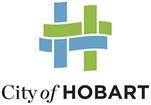
Memorandum: City Planning Committee
City Planning - Advertising Report
Attached is the advertising list for the period 7 June 2022 to 20 June 2022.
|
That: 1. That the information be received and noted.
|
As signatory to this report, I certify that, pursuant to Section 55(1) of the Local Government Act 1993, I hold no interest, as referred to in Section 49 of the Local Government Act 1993, in matters contained in this report.
|
Neil Noye Director City Life |
|
Date: 22 June 2022
File Reference: F22/60864
Attachment a: City
Planning - Advertising Report ⇩ ![]()
|
Agenda (Open Portion) City Planning Committee Meeting |
Page 569 |
|
|
|
4/7/2022 |
|
8.4 Delegated Decision Report (Planning)
Memornadum of the Director City Life of 27 June 2022 and attachment.
Delegation: Committee
|
Item No. 8.4 |
Agenda (Open Portion) City Planning Committee Meeting |
Page 570 |
|
|
4/7/2022 |
|

Memorandum: City Planning Committee
Delegated Decision Report (Planning)
Attached is the delegated planning decisions report for the period 14 June 2022 to 24 June 2022.
|
That: 1. That the information be received and noted.
|
As signatory to this report, I certify that, pursuant to Section 55(1) of the Local Government Act 1993, I hold no interest, as referred to in Section 49 of the Local Government Act 1993, in matters contained in this report.
|
Neil Noye Director City Life |
|
Date: 27 June 2022
File Reference: F22/62420
Attachment a: Delegated
Decision Report (Planning) ⇩ ![]()
|
Agenda (Open Portion) City Planning Committee Meeting |
Page 572 |
|
|
|
4/7/2022 |
|
Regulation 29(3) Local Government
(Meeting Procedures) Regulations 2015.
File Ref: 13-1-10
The Chief Executive Officer reports:-
“In accordance with the procedures approved in respect to Questions Without Notice, the following responses to questions taken on notice are provided to the Committee for information.
The Committee is reminded that in accordance with Regulation 29(3) of the Local Government (Meeting Procedures) Regulations 2015, the Chairman is not to allow discussion or debate on either the question or the response.”
9.1 Refuelling Compliance Issues
File Ref: F22/39457; 13-1-10
Memorandum of the Director City Life of 27 June 2022.
|
That the information be received and noted.
|
Delegation: Committee
|
Item No. 9.1 |
Agenda (Open Portion) City Planning Committee Meeting |
Page 573 |
|
|
4/7/2022 |
|
memorandum: Lord
Mayor
Deputy lord Mayor
Elected members
Refuelling Compliance Issues
|
Meeting: City Planning Committee
|
Meeting date: 26 April 2022
|
|
Raised by: Alderman Briscoe |
|
Question:
Can the Director inform the Committee if there have been any compliance issues regarding the operation of the refuelling stations at either the Derwent Sailing Squadron or Royal Yacht Club of Tasmania?
Response:
Council officers are not aware of any compliance issues pertaining to the refuelling facilities at either club.
As signatory to this report, I certify that, pursuant to Section 55(1) of the Local Government Act 1993, I hold no interest, as referred to in Section 49 of the Local Government Act 1993, in matters contained in this report.
|
Neil Noye Director City Life |
|
Date: 27 June 2022
File Reference: F22/39457; 13-1-10
|
|
Agenda (Open Portion) City Planning Committee Meeting |
Page 574 |
|
|
4/7/2022 |
|
Section 29 of the Local Government (Meeting Procedures) Regulations 2015.
File Ref: 13-1-10
An Elected Member may ask a question without notice of the Chairman, another Elected Member, the Chief Executive Officer or the Chief Executive Officer’s representative, in line with the following procedures:
1. The Chairman will refuse to accept a question without notice if it does not relate to the Terms of Reference of the Council committee at which it is asked.
2. In putting a question without notice, an Elected Member must not:
(i) offer an argument or opinion; or
(ii) draw any inferences or make any imputations – except so far as may be necessary to explain the question.
3. The Chairman must not permit any debate of a question without notice or its answer.
4. The Chairman, Elected Members, Chief Executive Officer or Chief Executive Officer’s representative who is asked a question may decline to answer the question, if in the opinion of the respondent it is considered inappropriate due to its being unclear, insulting or improper.
5. The Chairman may require a question to be put in writing.
6. Where a question without notice is asked and answered at a meeting, both the question and the response will be recorded in the minutes of that meeting.
7. Where a response is not able to be provided at the meeting, the question will be taken on notice and
(i) the minutes of the meeting at which the question is asked will record the question and the fact that it has been taken on notice.
(ii) a written response will be provided to all Elected Members, at the appropriate time.
(iii) upon the answer to the question being circulated to Elected Members, both the question and the answer will be listed on the agenda for the next available ordinary meeting of the committee at which it was asked, where it will be listed for noting purposes only.
|
|
Agenda (Open Portion) City Planning Committee Meeting |
Page 575 |
|
|
4/7/2022 |
|
[4] abs.gov.au/statistics/economy/price-indexes-and-inflation/wage-price-index-australia/latest-release
[5] abs.gov.au/statistics/economy/price-indexes-and-inflation/consumer-price-index-australia/mar-2022
[6] abs.gov.au/statistics/labour/earnings-and-working-conditions/average-weekly-earnings-australia/nov-2021